- Chapter 1 Rational Numbers
- Chapter 2 Linear One Equations In Variable
- Chapter 3 Understanding Quadrilaterals
- Chapter 4 Data Handling
- Chapter 5 Squares And Square Roots
- Chapter 6 Cubes And Cube Roots
- Chapter 7 Comparing Quantities

Question 1. Mohan prepares tea for himself and his sister. He uses 300 mL of water, 2 spoons of sugar, 1 spoon of tea leaves and, 50 mL of milk. How much quantity of each item will he need, if he has to make tea for five persons?
Solution:

Quantity of water required for 2 persons = 300 mL
Quantity of water required for 1 person = \(\frac{300}{2} \mathrm{~mL}\)
Quantity of water required for 5 persons \(\frac{300}{2} \times 5 \mathrm{~mL}\)
Quantity of sugar required for 2 persons = 2 spoons
Quantity of sugar required for 1 person \(\frac{2}{2} \text { spoons }\)
NCERT Solutions for Class 8 Maths Chapter 11 Direct and Inverse Proportions
Read and Learn More NCERT Solutions For Class 8 Maths
Quantity of sugar required for 5 persons \(\frac{2}{2} \times 5=5 \text { spoons }\)
Quantity of tea leaves required for 2 persons = 1 spoon
Quantity of tea leaves required for 1 person \(\frac{1}{2} \text { spoons }\)
Quantity of tea leaves required for 5 persons \(=\frac{1}{2} \times 5=2 \frac{1}{2} \text { spoons }\)
Quantity of milk required for 2 persons = 50 mL
Quantity of milk required for 1 person = \(\frac{50}{2} \mathrm{~mL}\)
Quantity of milk required for 5 persons = \(\frac{50}{2} \times 5 \mathrm{~mL}=125 \mathrm{~mL}\)
Thus, Mohan will require 750 mL of water, 5 spoons of sugar, \(2 \frac{1}{2}\) Spoons of tea leaves, and 125 mL of milk for 5 persons.
Question 2. If two students take 20 minutes to arrange chairs for an assembly, then how much time would five students have to do the same job?
Solution:
Time taken by 2 students = 20 minutes
Time taken by 1 student = 20 x 2 minutes
Time taken by 5 students = \(\frac{20 \times 2}{5} \text { minutes }=8 \text { minutes }\)
We come across many such situations in our day-to-day life, where we need to see variation in one quantity bringing in variation in the other quantity. Quantities so related are called variables and the relation is called variation.
For example :
Question 3. Write five more such situations where a change in one quantity leads to change in another quantity.
Solution:
Five more such situations where a change in one quantity leads to a change in another quantity are as follows :
Question 4. How do we find out the quantity of each item needed by Mohan? or, the time five students take to complete the job?
Solution:
We need to study some concepts of variation as follows :
Two quantities may be linked in two ways :
Both increase or decrease together proportionally.
If one increases, the other decreases proportionally, and vice-versa.
The first way is named a direct variation whereas the second way is named as an inverse variation.
If two quantities are related in such a way that an increase in one leads to a corresponding proportional increase in the other, then such a variation is called direct variation.
Thus, two numbers x and y are said to vary in direct proportion if
\(\frac{x}{y}\)= k or x = ky where k is a constant.
In this case, if ÿ1,y2 are the values ofy corresponding to the values x1, x2 of x respectively, then
⇒ \(\frac{x_1}{y_1}=\frac{x_2}{y_2}\)
Question 5. Let the consumption of petrol be x liters and the corresponding distance traveled by km. Now, complete, the following table:

We find that as the value increases, the value also increases in such a way that the ratio \(\frac{x}{y}\) does not change; it remains constant (say It). In this case, it is……(check it !)
Solution:

In this case, it is \(\frac{1}{15}\)
Question 6. Think of a few more examples for direct proportion.
Solution:
Take a clock and fix its minute hand, at 12.
Record the angle turned through by the minute hand from its original position and the time that has passed, in the following table
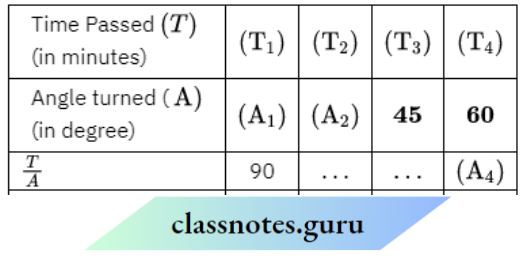
What do you observe about T and A ? Do they increase together? Is \(\frac{T}{A}\) same every time ?
Is the angle turned through by the minute hand directly proportional to the time that has passed? Yes; From the above table, you can also see

T1 : T2 = A1 : A2, because
T1 : T2 = 15 : 30 = 1:2
A1 : A2 = 90 : 180 = 1:2
Check if T2 : T3 = A2 : A3 and T3 : T4 = A3 : A4
You can repeat this activity by choosing your time interval.
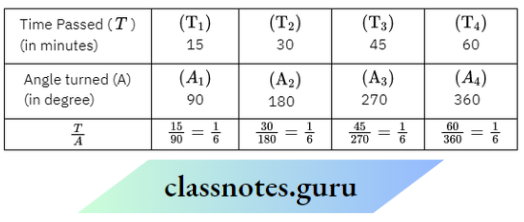
We observe about T and A that they increase together and \(\frac{T}{A}\)is the same every time. A Yes, the angle turned by the minute hand is directly proportional to the time that has passed.
On checking, we find that
T2 : T3 = A2 : A3 = 2:3
T3 : T4 = A3 : A4 = 3:4
Ask your friend to fill in the following table and find the ratio of his age to the corresponding age of his mother:

What do you observe?
Do F and M increase (or decrease) together? Is — the same every time? No.
You can repeat this activity with other friends and write down your observations.
Solution:
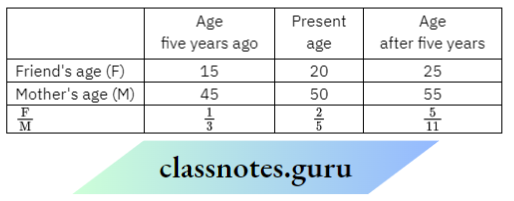
We observe that F and M increase (or decrease) together. But — is not the same every
time.
Note: It is not. necessary that the variables increasing (or decreasing) together are always in direct proportion.
For example :
Height and age of an individual
Height and weight of an individual
Height of mango tree and the number of mango fruits growing on its branches.
Class 8 Maths Chapter 11 Direct and Inverse Proportions Solutions
Question 7. Observe the following tables and find if x and y are directly proportional:
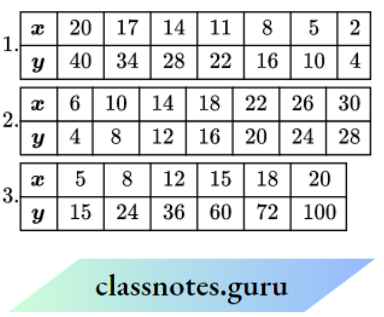
Solution:
We have \(\frac{20}{40}=\frac{1}{2}\)
⇒ \(\frac{17}{34}=\frac{1}{2}\)
⇒ \(\frac{14}{28}=\frac{1}{2}\)
⇒ \(\frac{11}{22}=\frac{1}{2}\)
⇒ \(\frac{8}{16}=\frac{1}{2}\)
⇒ \(\frac{5}{10}=\frac{1}{2}\)
⇒ \(\frac{2}{4}=\frac{1}{2}\)
We find that each ratio is the same.
Hence, x and y are directly proportional.
We have \(\frac{6}{4}=\frac{3}{2}\)
⇒ \(\frac{10}{8}=\frac{5}{4}\)
⇒ \(\frac{14}{12}=\frac{7}{6}\)
⇒ \(\frac{18}{16}=\frac{9}{8}\)
⇒ \(\frac{22}{20}=\frac{11}{10}\)
⇒ \(\frac{26}{24}=\frac{13}{12}\)
⇒ \(\frac{30}{28}=\frac{15}{14}\)
We find that all the ratios are not the Same.
Hence, x and y are not directly proportional.
⇒ \(\frac{5}{15}=\frac{1}{3}\)
⇒ \(\frac{8}{24}=\frac{1}{3}\)
⇒ \(\frac{12}{36}=\frac{1}{3}\)
⇒ \(\frac{15}{60}=\frac{1}{4}\)
⇒ \(\frac{18}{72}=\frac{1}{4}\)
⇒ \(\frac{20}{100}=\frac{1}{5}\)
We find that all the ratios are not the same.
Hence, x and y are not directly proportional.
Question 8. Principal = f1,000, Rate = 8% per annum. Fill in the following table and find which type of interest (simple or compound) changes in direct proportion with time.
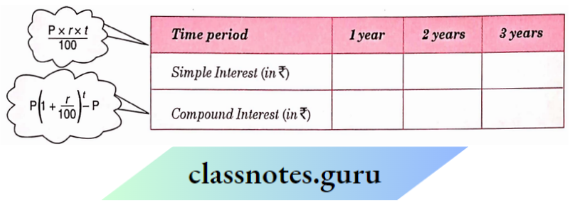
Solution:
1 year \(\frac{\mathrm{P} \times r \times t}{100}\)
⇒ \(₹ \frac{1000 \times 8 \times 1}{100}\)
₹ 80
We have \(\frac{80}{1}=80\)
2 years \(\frac{\mathrm{P} \times r \times t}{100}\)
⇒ \(₹ \frac{1000 \times 8 \times 2}{100}\)
₹ 160
\(\frac{160}{2}=80,\)3 years \(\frac{\mathrm{P} \times r \times t}{100}\)
⇒\(₹ \frac{1000 \times 8 \times 3}{100}\)
₹ 240
⇒ \(\frac{240}{3}=80\)
We find that each ratio is the same.
Hence, simple interest changes in direct proportion with a period.
Compound Interest (in ?) for different periods
1 year \(\mathrm{P}\left(1+\frac{r}{100}\right)^t-\mathrm{P}\)
⇒ \(1000\left(1+\frac{8}{100}\right)-1000\)
⇒ \(1080-1000=₹ 80\)
We have \(\frac{80}{1}=80\)
2 years \(\mathrm{P}\left(1+\frac{r}{100}\right)^t-\mathrm{P}\)
v\(1000\left(1+\frac{8}{100}\right)^2-1000\)
₹ 166.40
⇒ \(\frac{166.40}{2}=83.20\)
3 years \(\mathrm{P}\left(1+\frac{r}{100}\right)^t-\mathrm{P}\)
⇒ \(1000\left(1+\frac{8}{100}\right)^3-1000\)
₹ 259.712
⇒ \(\frac{259.712}{3}=86.5706\)
We find that all the ratios are not the same.
Hence, compound interest does not change in direct proportion to the period.
Question 9. If we fix the period and the rate of interest, simple interest changes proportionally with the principal. Would there be a similar relationship for compound interest? Why?
Solution:
Case 1
⇒ \(\text { S.I. }=\frac{\mathrm{P} r t}{100}\)
⇒ \(\frac{\text { S.I. }}{\mathrm{P}}=\frac{r t}{100}\)
r and t are fixed
⇒ \(\frac{r t}{100} \text { is constant }\)
⇒ \(\frac{\mathrm{S} . \mathrm{I}}{\mathrm{P}}=\text { constant }\)
S.I. changes proportionally with principal
Case 2
⇒ \(\text { C.I. }=\mathrm{P}\left\{\left(1+\frac{r}{100}\right)^t-1\right\}\)
⇒ \(\frac{\mathrm{C} . \mathrm{I}}{\mathrm{P}}=\left(1+\frac{r}{100}\right)^t-1\)
r and tare fixed
⇒ \(\left(1+\frac{r}{100}\right)^t-1 \text { is constant }\)
⇒ \(\frac{\mathrm{C} . \mathrm{I}}{\mathrm{P}}=\text { constant }\)
C.I. changes proportionally with principal
There is a similar relationship for compound interest
Question 10. Take a map of your State. Note the scale used there. Using a ruler, measure the “map distance’’ between any two cities. Calculate the actual distance between them.
Solution:
Let the scale be 1 cm = 100 km
Let the distance between any two cities on the map be 5 cm.
Then, the actual distance between these two cities = 100 x 5 km = 500 km
Direct and Inverse Proportions Class 8 NCERT Solutions
Question 1. Following are the car parking charges near a railway station up to
Check if the parking charges are in direct proportion to the parking time.
Solution:
We have
⇒ \(\frac{60}{4}=\frac{60 \div 4}{4 \div 4}=\frac{15}{1}\) HCF (60, 4) = 4
⇒ \(\frac{100}{8}=\frac{100 \div 4}{8 \div 4}=\frac{25}{2}\) HCF (100, 8) = 4
⇒ \(\frac{140}{12}=\frac{140 \div 4}{12 \div 4}=\frac{35}{3}\) HCF (140, 12) = 4
⇒ \(\frac{180}{24}=\frac{180 \div 12}{24 \div 12}=\frac{15}{2}\) HCF (180, 24) = 12
Since all the ratios are not the same, therefore, the parking charges are not in direct proportion to the parking time.
Question 2. A mixture of paint is prepared by mixing 1 part of red pigments with 8 parts of the base. In the following table, find the parts of the base that need to be added

Solution:
Let the number of parts of red pigments be x and the number of parts of the base is y.
As the number of parts of red pigments increases, several parts of the base also increase in the same ratio. So it is a case of direct proportion.
We make use of the relation of the type \(\frac{x_1}{y_1}=\frac{x_2}{y_2}\)
Here
x1= 1
y1 = 8 and x2 = 4
Therefore \(\frac{x_1}{y_1}=\frac{x_2}{y_2} \text { gives }\)
⇒ \(\frac{1}{8}=\frac{4}{y_2}\)
y2 = 8 x 4
y2 = 32
Hence, 32 parts of the base are needed to be added to 4 parts of red pigments.
Here,
x1 = 1
y4 = 8 and x3 = 7
Therefore \(\frac{x_1}{y_1}=\frac{x_3}{y_3}\) gives
⇒ \(\frac{1}{8}=\frac{7}{y_3}\)
y3 = 8 x 7
y3 = 56
Hence, 56 parts of the base are needed to be added to 7 parts of red pigments.
Here
x1= 1
y1= 8
x4 = 12
Therefore,\(\frac{x_1}{y_1}=\frac{x_4}{y_4}\) gives
⇒ \(\frac{1}{8}=\frac{12}{y_4}\)
y4= 12 x 8
y4 = 96
Hence, 96 parts of the base are needed to be added to 12 parts of red pigments.
Here,
x1= 1
y1 = 8
x5 = 20
Therefore \(\frac{x_1}{y_1}=\frac{x_5}{y_5}\)gives
⇒ \(\frac{1}{8}=\frac{20}{y_5}\)
y5 = 8 x 20
y5 = 160
Hence, 160 parts of the base are needed to be added to 20 parts of red pigments.
Question 3. In Question 2 above, if part of the red pigment requires 75 mL of the base, how much red pigment should we mix with 1800 mL of the base?
Solution:
Let the number of parts of red pigments be and the amount of base be y mL.
As the number of parts of red pigment increases, the amount of base also increases in the same ratio. So it is a case of direct proportion.
We make use of the relation of the type.
⇒ \(\frac{x_1}{y_1}=\frac{x_2}{y_2}\)
Here x1=1
y2 = 75 and ,y2 = 1800
⇒ \(\frac{x_1}{y_1}=\frac{x_2}{y_2}\) give
⇒ \(\frac{1}{75}=\frac{x_2}{1800}\)
⇒ \(\frac{1}{75} =\frac{x_2}{1800}\)
⇒ \(75 x_2 =1800 \)
⇒ \(x_2 =\frac{1800}{75}=\frac{600}{25}\)
x2 = 24
Hence, 24 parts of the red pigment should be mixed with 1800 mL of base.
⇒ \(\frac{x_1}{y_1}=\frac{x_2}{y_2} \Rightarrow x_1 y_2=x_2 y_1\)
⇒ \(\frac{x_1}{x_2}=\frac{y_1}{y_2}\)
Question 4. A machine in a soft drink factory fills 840 bottles in six hours. How many bottles will it fill in five hours?
Solution:
Let the machine fill x bottles in five hours. We put the given information in the form of a table as shown below :

The more the number of hours, the more the y2 number of bottles would be filled. So, the number of bottles filled and the number of hours are directly proportional to each other.
⇒ \(\frac{x_1}{x_2}=\frac{y_1}{y_2}\)
⇒ \(\frac{840}{x_2}=\frac{6}{5}\)
6×2 = 840 x 5
⇒ \(x_2=\frac{840 \times 5}{6}=700\)
Hence, 700 bottles will be filled in five hours.
Class 8 Maths Chapter 11 Exercise Solutions
Question 5. A photograph of bacteria enlarged 50,000 limes allies a length of 5 cm as shown in the diagram. What is the actual length of the bacteria? If the photograph is enlarged 20,000 times only, what, would be its enlarged length?

Solution:
Actual length of the bacteria \(\frac{5}{50000} \mathrm{~cm}=\frac{1}{10000} \mathrm{~cm}=10^{-4} \mathrm{~cm}\)
Let the enlarged length be cm. We put the given information in the form of a table as shown below :
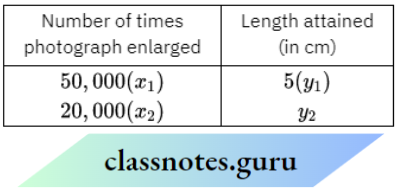
⇒ \(\frac{x_1}{y_1}=\frac{x_2}{y_2}\)
⇒ \(\frac{50000}{5}=\frac{20000}{y_2}\)
50000 y2 = 5 x 20000
⇒ \(y_2=\frac{5 \times 20000}{50000}=\frac{5 \times 2}{5}\)
y2 = 2
Hence, its enlarged length would be 2 cm.
Question 6. In a model of a ship, the mast is 9 cm high, while the mast of the actual ship is 12 m. high. If the length of the ship is 28 m, how long is the model ship?

Solution:
Let the length of the model ship be x2 cm.
We form a table as shown below :

The more the length of the ship, the more would be the length of its mast. Hence, this is a case of direct proportion. That is,
⇒ \(\frac{x_1}{y_1}=\frac{x_2}{y_2}\)
⇒ \(\frac{28}{12}=\frac{x_2}{9}\)
12 x2 = 28 x 9
⇒ \(x_2=\frac{28 \times 9}{12}=\frac{28 \times 3}{4}\)
x2 = 21
Hence, the length of the model ship is 21 m
Question 7. Suppose 2 kg of sugar contains 9 Y.106 crystals. How many sugar crystals are there in (i) 5 kg of sugar? (ii) 1.2 kg ofsugar ?
Solution:
Suppose the amount of sugar is x kg and the number of crystals is y. We put the given information in the form of a table as shown below :

As the amount of sugar increases, the number of crystals also increases in the same ratio. So it is an ease of direct proportion. We make use of the relation of the type \(\frac{x_1}{y_1}=\frac{x_2}{y_2}\)
Here, x1 = 2
y1 = 9 x 106
x2= 5
Therefore \(\frac{x_1}{y_1}=\frac{x_2}{y_2}\) gives
⇒ \(\frac{2}{9 \times 10^6}=\frac{5}{y_2}\)
2y2= 5 x 9 x 106
⇒ \(y_2=\frac{5 \times 9 \times 10^6}{2}\)
y2 = 22.5 x 106
y2 = 2.25 x 107
[Standard form]
Hence, there are 2.25 x 107 crystals of sugar in 5 kg of sugar
Here, .x1 = 2
y1 =9 X 106
x3 = 1.2
Therefore \(\frac{x_1}{y_1}=\frac{x_3}{y_3}\) gives
⇒ \(\frac{2}{9 \times 10^6}=\frac{1.2}{y_3}\)
2y3 = 1.2 x 9 x 106
2y3= 10.8 x 106
⇒ \(y_3=\frac{10.8 \times 10^6}{2}\)
y3 = 5.4 x 106
Hence, there are 5.4 x 106 crystals of sugar in 1.2 kg of sugar.
Question 8. Rashmi has a road map with a scale of 1 cm representing 18 km. She drives on a road for 72 km. What would be her distance covered in the map?
Solution:
Let. the distance covered in the map be x cm. We put the given information in the form of a table as shown below :
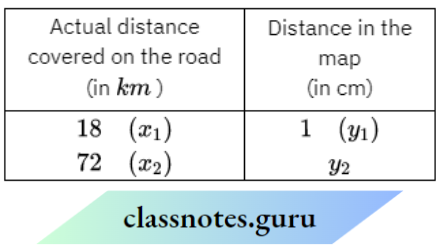
The more the actual distance covered on the road, the more the distance on the map. So, it is a case of direct proportion
⇒ \(\frac{x_1}{y_1}=\frac{x_2}{y_2} \Rightarrow \frac{18}{1}=\frac{72}{y_2}\)
⇒ \(y_2=\frac{72}{18}=4\)
Hence, the distance covered on the map would be 4 cm.
Question 9. A 5 m 60 cm high vertical pole casts a shadow 3 m 20 cm long. Find at the same time) the length of the shadow cast by another pole 10 m 50 cm high (ii) the height of a pole which casts a shadow 5 m long.
Solution:
Let the height of the vertical pole be * m and the length of the shadow be y m. We put the given information in the form of a table as shown below :
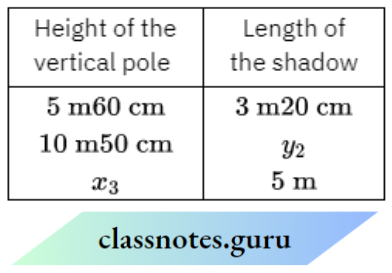
As the height of the vertical pole increases, the length of the shadow also increases in the same ratio. So it is a case of direct proportion.
We make use of the relation of the type \(\frac{x_1}{y_1}=\frac{x_2}{y_2} \text {. }\)
Here xl = 5 m 60 cm = 5.60 m
yi= 3 m 20 cm = 3.20 m
x2 = 10 m 50 cm = 10.50 m
Therefore \(\frac{x_1}{y_1}=\frac{x_2}{y_2}\) gives
⇒ \(\frac{5.6}{3.2}=\frac{10.5}{y_2}\)
5.6y2 = 3.2 x 10.5
⇒ \(y_{2 .}=\frac{3.2 \times 10.5}{5.6}=\frac{32 \times 105}{560}\)
⇒ \(\frac{4 \times 105}{70}=\frac{4 \times 15}{10}\)
y2= 6
Hence, the length of the shadow is 6 m.
(ii) Here xx = 5 m 60 cm = 560 cm
y1 = 3 m 20 cm = 320 cm
y3 = 5 m = 500 cm
Therefore \( \frac{x_1}{y_1} =\frac{x_3}{y_3} \text { gives } \frac{560}{320}=\frac{x_3}{500}\)
⇒ \(320 x_3 =560 \times 500\)
⇒ \(x_3 =\frac{560 \times 500}{320}=\frac{560 \times 50}{32}\)
⇒ \(\frac{70}{4} \times 50=\frac{3500}{4}\)
x3 = 875
Hence, the height of the pole is 8 m 75 cm.
Question 10. A loaded truck travels 14 km in 25 minutes. If the speed remains the same, how far can it travel in 5 hours?
Solution:
Two quantities x and y which vary £ in direct proportion have the relation
⇒ \(x=k y \text { or } \frac{x}{y}=k\)
⇒ \(k =\frac{\text { Number of km it can travel }}{\text { time in hours }}\)
⇒ \(\frac{14}{\left(\frac{25}{60}\right)}=\frac{14 \times 60}{25}\)
⇒ \(\frac{14 \times 12}{5}=\frac{168}{5}\)
Now, x is the distance traveled in 5 hours
Using the relation x = ky, obtain
⇒ \(x=\frac{168}{5} \times 5\)
x = 168
Hence, it can travel 168 km in 5 hours.
NCERT Class 8 Maths Chapter 11 Question Answer
Question 11. On a squared paper, draw five squares of different sides. Write the following information in a tabular form.

Find whether the length of a side is in direct proportion to the:
Solution:
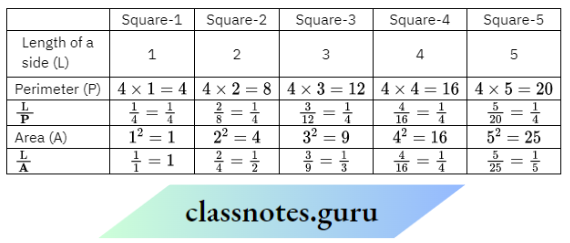
Since each \(\frac{L}{\mathrm{P}}\) is the same, so we find that the length of a side is in direct proportion to the perimeter of the square.
Since all \(\frac{L}{\mathrm{a}}\) are not the same, therefore, we find that the length of a side is not in direct proportion to the area of the square.
Question 12. The following ingredients are required to make halwa for 5 persons: SujiRawa = 250 g, Sugar = 300 g, Ghee = 200 g, Water = 500 ml. Using the concept of proportion, estimate the changes in the quantity of ingredients, to prepare halwa for your class.
Solution:
Suppose that there are 25 (= 5 x 5) students in the class. Then, this is a case of direct variation. Hence, we shall require five times the quantity of ingredients.
Question 3. Choose a scale and make a map of your classroom., showing windows, doors blackboard, etc. (An example is given here),
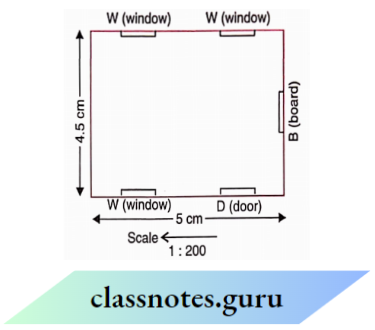
Solution:
Please make yourself.
Question 13. Take a few problems discussed so far under ‘direct variation’. Do you think that they can be solved by the ‘unitary method’?
Solution:
Yes, they can be solved by the unitary method
∴ 75 mL of the base is required for
= 1 part of red pigment
∴ 1 mL of the base is required for
\(\frac{1}{75}\) part of red pigment
∴ 1800 mL of the base is required for
⇒ \(=\frac{1}{75} \times 1800=\frac{120}{5}\)
= 24 parts of red pigment
Number of bottles filled in 6 hours = 840
Number of bottles filled in 1 hour \(\)
⇒ \(\frac{840}{6}=140\)
∴ Number of bottles filled in 5 hours = 140 x 5 = 700
∴ Distance travelled in 25 minutes = 14 km
∴ Distance travelled in 1 minute\(=\frac{14}{25} \mathrm{~km}\)
∴ Distance travelled in 5 hours(= 5 x 60 minutes or 300 minutes)
⇒ \(\frac{14}{25} \times 300 \mathrm{~km}\)
14 x 12 = 168 km
Class 8 Chapter 11 Maths NCERT Book Solutions
If two quantities are related in such a way that an increase in one quantity leads to a corresponding proportional decrease in the other and vice-versa, then such a variation is called inverse proportion.
Thus, two quantities x and y are said to vary in inverse proportion if xy = k where k is a constant of proportionality
In this case, if. y1, y2 are the values of y corresponding to the values xv x2
f x respectively,
⇒ \(x_1 y_1=x_2 y_2 \quad \text { or } \quad \frac{x_1}{x_2}=\frac{y_2}{y_1}\)
Question 14. Think of more such examples of pairs of quantities that vary in inverse proportion.
Solution:
Some more such examples of pairs of quantities that vary in inverse proportion are as follows :
Number of machines to produce a given number of articles and the number of days required for production.
Number of periods a day in a school and the length of the period.
Number of workers to build a wall and The number of hours to build the wall
Question 15. Take a squared paper and arrange 48 counters on it in different numbers of rows shown below
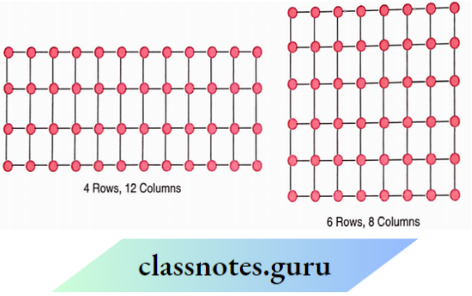
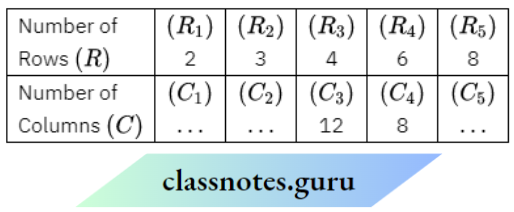
What do you observe? As R increases, C decreases.
Try this activity with 36 counters.
Solution:

So \(\frac{\mathrm{R}_1}{\mathrm{R}_2} =\frac{2}{3}\)
⇒ \( \frac{\mathrm{C}_2}{\mathrm{C}_1} =\frac{16}{24}=\frac{2}{3} \)
⇒ \( \frac{\mathrm{R}_1}{\mathrm{R}_2} =\frac{\mathrm{C}_2}{\mathrm{C}_1} \)
⇒ \(\mathrm{R}_1: \mathrm{R}_2 =\mathrm{C}_2: \mathrm{C}_1\)
R1: R2 = C2: C1
⇒ \(\frac{\mathrm{R}_3}{\mathrm{R}_4}=\frac{4}{6}=\frac{2}{3}\)
⇒ \(\frac{\mathrm{C}_4}{\mathrm{C}_3}=\frac{8}{12}=\frac{2}{3}\)
⇒ \(\frac{\mathrm{R}_3}{\mathrm{R}_4}=\frac{\mathrm{C}_4}{\mathrm{C}_3}\)
R3:R4 = C4:C3
Yes! R and C are inversely proportional to each other.
Let us arrange 36 counters in different numbers of rows as shown below :
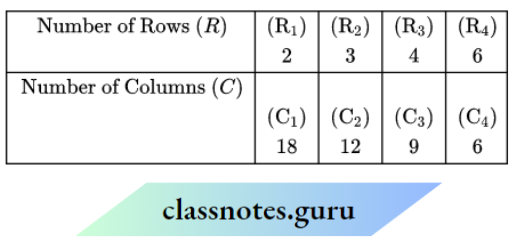
Let us try this activity with 36 counters as follows :

We observe that as R increases, C decreases.
R1 : R2 = 2:3
C2 : C4= 12 : 18 = 2 : 3
R1:R2 = C2 : C1
R3 : R4 = 4:6 = 2:3
C4 : C3 = 6:9 = 2:3
R3:R4= c4-c3
Yes! R and C are inversely proportional to each other.
Question 16. Observe the following tables and find which pair of variables (here x and y) are in inverse proportion.
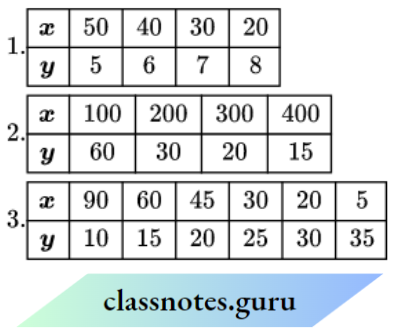
Solution:
x1y1 = 50 x 5 = 250
x2y2 = 40 x6 = 240
So, x1y1 ≠ x2y2
Hence, x and y are not in inverse proportion
x1y1= 100 x 60 = 6000
x2y2 = 200 x 30 = 6000
x3y3 = 300 x 20 = 6000
x4ÿ4 = 400 x 15 = 6000
So , x1y1 = x2y2 = x3y3 = x4y4
Hence, x and y are in inverse proportion.
x1y1= 90 x 10 = 900
x2y2 = 60 x 15 = 900
x3y3 = 45 x 20 = 900
x4ÿ4 = 30 x 25 = 750
As x1y1 = x2y2 = x3y3 ≠ x4y4
So, x and y are not in inverse proportion.
Note: When two quantities x and y are in direct proportion (or vary directly) they are also written as x y.
When two quantities x andy are in inverse proportion (or vary inversely) they are also written as x «c \(\frac{1}{y}\)
Chapter 11 Class 8 Maths Worksheet with Answers
Question 1. Which of the following are in inverse proportion 1
Solution:
The number of workers on a job and the time to complete the job are in inverse
proportion, since as the number of workers increases, then the time to complete the job decreases proportionally.
The time taken for a journey and the distance traveled at a uniform speed are not in inverse proportion, since for a longer distance, more time will be required.
The area of cultivated land and the crop harvested is not in inverse proportion, since for more area of cultivated land, more crops will be needed to be harvested.
The time taken for a fixed journey and the speed of the vehicle are in inverse proportion, since the speed of the vehicle, proportionally less would be the time to cover a fixed journey.
The population of the country and the area of land per person are in inverse proportion,
since for more population of the country, the area of land per person would be proportionally less.
Question 2. In a Television game show, the prize money of f1,00,000 is to be divided equally amongst the winners. Complete the following table and find whether the prize money given to an individual winner is directly or inversely proportional to the number of winners.

Solution:
Let the prize (in T) for each winner bey3, y4, y5, y6, and y1 corresponding to the number of winners 4, 5, 8, 10, and 20 respectively. Then,
1 X 1,00,000 = 4 X y3 \(y_3=\frac{1,00,000}{4}=25,000\)
1 x 1,00,000 = 5 x y4 \(y_3=\frac{1,00,000}{5}=20,000\)
1 x 1,00,000 = 8 x y5 \(y_3=\frac{1,00,000}{8}=12,000\)
1 x 1,00,000 = 10 x y6 \(y_3=\frac{1,00,000}{10}=10,000\)
1 x 1,00,000 = 20 x y7 \(y_3=\frac{1,00,000}{20}=5,000\)

As the number of winners increases, amount of prize decreases. So the prize money given to an individual winner is inversely proportional to the number of winners.
Question 3. Rehrnan is making any paira wheel of using spokes in such a way that the angles between any pair of consecutive equal. Help equal him spokes by completing the following table:
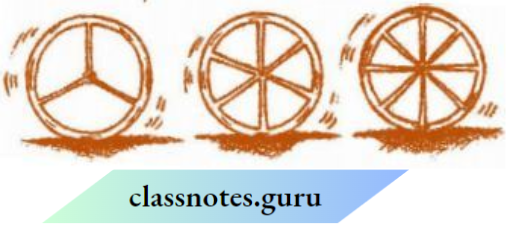
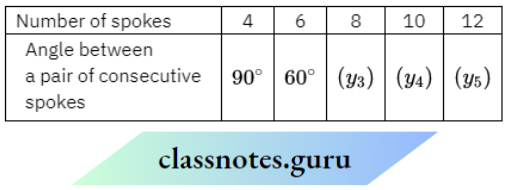
Solution:
Let the angles (in degree) between a pair of consecutive spokes be y3, y4, and y5 respectively. Then,
⇒ \(y_3=\frac{360^{\circ}}{8}=45^{\circ}\)
⇒ \(y_4=\frac{360^{\circ}}{10}=36^{\circ}\)
⇒ \(y_5=\frac{360^{\circ}}{12}=30^{\circ}\)
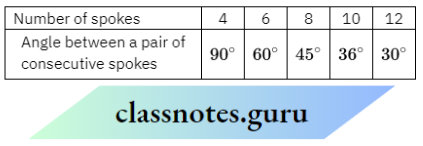
Yes; The number of spokes and the angles formed between the pairs of consecutive spokes are in inverse proportion.
|4 x 90° = 6 x 60° = 8 x 45° = 10 x 36° = 12 x 30°
Let the angle (in degrees) between a pair of consecutive spokes on a wheel with 15 spokes be y6.
The smaller the number of spikes, the more the angle between a pair of consecutive spokes.
So, this is a case of inverse proportion.
Hence, 4 x 90° = 15 x y
⇒ \(y_6=\frac{4 \times 90^{\circ}}{15}\) x1y1 = x2y2
y6 = 24°
Hence, the angle between a pair of consecutive spokes on a wheel with 15 spokes is 24°.
Let x spokes be needed.
The lesser the number of spokes, the more will be the angle between a pair of consecutive spokes, bo, this is a case of inverse proportion.
Hence, 4 x 90° = x x 40°
⇒ \(x=\frac{4 \times 90^{\circ}}{40}\) x1y1 = x2y2
X = 9
Hence, 9 spokes would be needed, if the angle between a pair of consecutive spokes is 40″,
Question 4. If a box of sweets is divided among 21 children, they will get 5 sweets each. How many would each get, if the number of the children is reduced by 4?
Solution:
Suppose that each would get y2 sweets
Thus, we have the following table :
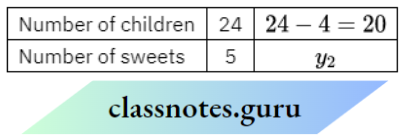
The fewer the number of children, the more the number of sweets each would get. So, this is a case of inverse proportion.
Hence 24 x 5 = 20 x y2
⇒ \(y_2=\frac{24 \times 5}{20}\)
y2 = 6
Hence, each would get 6 sweets, if the number of children is reduced by 4.
Question 5. A farmer has enough food to feed 20 animals in his cattle for 6 days. How long would the food last if there were 10 more animals in his cattle?
Solution:
Suppose that the food would last for two days. We have the following table :
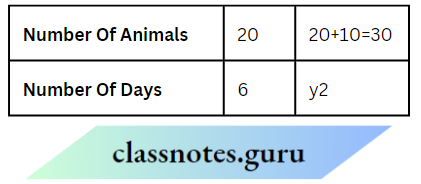
We note that the more the number of animals, the lesser will be the number of days for which the food will last. Therefore, this is a case of inverse proportion.
So, 20 x 6 = 30 x y2
⇒ \(y_2=\frac{20 \times 6}{30}\)
y2 = 4
Hence, the food would last for 4 days, if there were 10 more animals in his cattle.
NCERT Class 8 Chapter 11 Proportion Questions and Answers
Question 6. A contractor estimates that 3 persons could rewire Dasminder’s house in 4 days. If, he uses 4 persons instead of three, how long should they take to complete the job?
Solution:
Suppose that they take y2 days to complete the job. We have the following table :
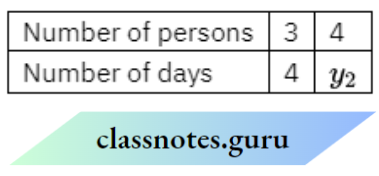
The more the number of persons, the lesser will be the number of days required to complete the job. So, this is a case of inverse proportion.
Hence, 3 x 4 =4 x y2
⇒ \(y_2=\frac{3 \times 4}{4}\)
y2 = 3
Hence, they would take 3 days to complete the job.
Question 7. A batch of bottles was packed in 25 boxes with 12 bottles in each box. If the same batch is packed using 20 bottles in each box, how many boxes would be filled?

Solution:
Suppose that y2 boxes would be filled. We have the following table:

The smaller the number of bottles, the more the number of boxes required to be filled. So, this is a case of inverse proportion.
Hence, 12 x 25 = 20 x y2
⇒ \(y_2=\frac{12 \times 25}{20}=3 \times 5\)
y2= 15
Hence, 15 boxes would be filled if the same batch is packed using 20 bottles in each box.
Question 8. A factory requires 42 machines to produce a given number of articles in 63 days. How many machines would be required to produce the same number of articles in 54 days?
Solution:
Suppose that x2 machines would be required. We have the following table :

The smaller the number of machines, the more will be the number of days to produce the same number of articles.
So, this is a case of inverse proportion.
Hence, 42 x 63 = x2 x 54
⇒ \(x_2=\frac{42 \times 63}{54}=\frac{21 \times 7}{3}\)
x2= 49
Hence, 49 machines would be required to produce the same number of articles in 54 days.
Question 9. A car takes 2 hours to reach a destination by traveling at the speed of 60 km/h. How long will it take when the car travels at the speed of 80 km/h?
Solution:
Let it take two hours. We have the following table :
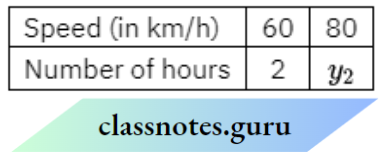
Lesser the speed, the more the number of hours to reach the destination. So, this is a case of inverse proportion.
Hence, 60 x 2 = 80 x y2
⇒ \(y_2=\frac{60 \times 2}{80}=\frac{3 \times 2}{4}\)
⇒ \(y_2=\frac{3}{2}=1 \frac{1}{2}\)
Thus, \(1 \frac{1}{2}\) hours would be taken when the car travels at the speed of 80 km/h.
NCERT Solutions for Class 8 Maths Chapter 11 Direct and Inverse Proportions with Explanation
Question 10. Two people could fit new windows in a house in 3 days.
Solution:
Let the job would take y2 days.
We have the following table :

The more the number of people, the lesser the number of days to do the job. So, the number of persons and number of days vary in inverse proportion.
So, 2 x 3= 1 x y2
Thus, the job would now take 6 days when one of the persons fell ill before the work started.
Let y3 persons be needed.
We have the following table :

Clearly, the more the number of people, the lesser the number of days to do the job. So, the number of persons and number of days vary in inverse proportion.
So, 3 x 2 = 1 x y3
y3= 6
Thus, 6 people would be needed to fit the windows in one day.
Question 11. A school has 8 periods a day each of 45 minutes duration. How long would each period be, if the school has 9 periods a day, assuming the number of school hours to be the same?
Solution:
Let each period be two minutes long. We have the following table :
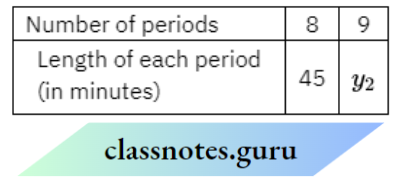
Wo note that the more the number of periods, the lesser would be the length of each period. Therefore, this is a case of inverse proportion.
So, 8 x 45 = 9 x y2
⇒ \(y_2=\frac{8 \times 45}{9}\)
y2 = 40
Hence, each period would be 40 minutes long if the school had 9 periods a day.
Question 12. Take a sheet of paper. Fold it as shown in the figure. Count the number of parts and the area of a part in each case.

Tabulate your observations and discuss them with your friends. Is it a case of inverse proportion? Why?

Solution:

We see that
⇒ \(1 \times 1=2 \times \frac{1}{2}=4 \times \frac{1}{4}=8 \times \frac{1}{8}=16 \times \frac{1}{16}=1 \text { (= constant) }\)
So yes it is a case of inverse proportion because the greater the number of parts lesser the area of each part.
Question 13. Take a few containers of different sizes with circular bases, Fill the same amount of water in each container. note the diameter of each container and the respective height at which the water levels stand. Tabulate your observations. Is it a case of inverse proportion?


Solution:

Let the same amount of water in each container be V. Then
⇒ \(V=\pi\left(\frac{d_1}{2}\right)^2 h_1=\pi\left(\frac{d_2}{2}\right)^2 h_2=\pi\left(\frac{d_3}{2}\right)^2 h_3\)
d12h1 = d22h2 = d32h3
d1h1= d2h2 = d3h3
So, it is not a case of inverse proportion.
It does not imply that
Class 8 Maths Chapter 11 Direct and Inverse Proportions Concept and NCERT Solutions
Question 1. 10 meters of cloth cost? 1000. What will 4 meters cost?
Solution: 1. ₹ 400
⇒ \(\frac{10}{1000}=\frac{4}{?} \quad \Rightarrow ?=400\)
Question 2. 15 books weigh 6 kg. What will 6 books weigh?
Solution: 2. 2.4 kg
⇒ \(\frac{15}{6}=\frac{6}{?} \quad \Rightarrow ?=2.4\)
Question 3. Does a horse eat 18 kg of corn in 12 days? How much does he eat in 9 days?
Solution: 3. 13.5 kg
⇒ \(\frac{12}{18}=\frac{9}{?} \quad \Rightarrow ?=\frac{18 \times 9}{12}\)
= 13.5
Question 4. 8 g of sandalwood cost ₹ 40. What will 10 g cost?
Solution: 4. ₹ 50
⇒ \(\frac{8}{40}=\frac{10}{?} \quad \Rightarrow ?=50\)
Question 5. 20 trucks can hold 150 metric tonnes. How much will 12 trucks hold?
Solution: 2. 90 metric tonnes
⇒ \(\frac{20}{150}=\frac{12}{?} \quad \Rightarrow ?=90 .\)
Question 6. 120 copies of a book cost ₹ 600. What will 400 copies cost?
Solution: 2. ₹ 2000
⇒ \(\frac{120}{600}=\frac{400}{?} \Rightarrow ?=2000 .\)
Question 7. The rent of 7 hectares is ₹ 875. What is the rent of 16 hectares?
Solution: 1. ₹ 2000
⇒ \(\frac{7}{875}=\frac{16}{?} \quad \Rightarrow ?=\frac{875 \times 16}{7}\)
= 2000
Question 8. A boy runs 1 km in 10 minutes. How long will it take to run 600 m?
Solution: 4. 6 minutes
⇒ \(\frac{1000}{10}=\frac{600}{?} \Rightarrow ?=6\)
Question 9. A shot travels 90 m in 1 second. How long will it take to go 225 m?
Solution: 2. 2.5.seconds
⇒ \(\frac{90}{1}=\frac{225}{?} \Rightarrow ?=2.5 .\)
Question 10. 3 knives cost ₹ 63. What will 17 knives cost?
Solution: 1. ₹ 357
⇒ \(\frac{3}{63}=\frac{17}{?} \quad \Rightarrow \quad ?=357\)
Question 11. 15 men can mow 40 hectares of land in 1 day. How much will 6 men mow in 1 day?
Solution: 1. 16 hectares
⇒ \(\frac{15}{40}=\frac{6}{?} \quad \Rightarrow ?=\frac{40 \times 6}{15}=16 .\)
Question 12. A man walks 20 km in 5 hours. How long would it take to walk 32 km?
Solution: 4. 8 hours
⇒ \(\frac{20}{5}=\frac{32}{?} \quad \Rightarrow ?=8\)
Question 13. What is the cost of 50 sticks at ₹ 24 per score?
Solution: 4. ₹ 60
⇒ \(\frac{20}{24}=\frac{50}{?} \quad \Rightarrow ?=60 \text {. }\)
Question 14. A train travels 60 km in 1 hour. How long will it take to go 150 km?
Solution: 3. 2.5 hours
⇒ \(\frac{60}{1}=\frac{150}{?} \quad \Rightarrow ?=2.5\)
Question 15. If 3 quintals of coal cost ₹ 6000, what is the cost of 120 kg?
Solution: 2. ₹ 2400
⇒ \(\frac{300}{6000}=\frac{120}{?} \Rightarrow ?=2400\)
Class 8 Maths Chapter 11 Direct and Inverse Proportions Concept and NCERT Solutions
Question 16. If 20 cows eat as much as 15 oxen, how many cows will eat as much as 36 oxen?
Solution: 4. 48
⇒ \(\frac{15}{20}=\frac{36}{?} \quad \Rightarrow ?=\frac{20 \times 36}{15}\)= 48
Question 17. The fare for a journey of 40 km is ₹ 25. How much can be traveled for ₹ 40?
Solution: 2. 64 km
⇒ \(\frac{25}{40}=\frac{40}{?} \Rightarrow ?=\frac{40 \times 40}{25}\)= 74
Question 18. Apala types 200 words in half an hour. How many words will she type in 12 minutes?
Solution: 1. 80
⇒ \(\frac{30}{200}=\frac{12}{?} \quad \Rightarrow ?=80 \text {. }\)
Question 19. A labourer is paid? 400 for 2 days of work. If he works for 5 days, how much will he get?
Solution: 1. ₹ 1000
⇒ \(\frac{2}{400}=\frac{5}{?} \quad \Rightarrow ?=1000 .\)
Question 20. A machine in a soft drink factory fills 600 bottles in 5 hours. How many bottles will it fill in 2 hours?
Solution: 4. 240
⇒ \(\frac{5}{600}=\frac{2}{?} \quad \Rightarrow ?=240 .\)
Question 21. If 8 men can do a piece of work in 20 days, in how many days could 20 men do the same work?
Solution: 2. 8 days
⇒ \(8 \times 20=20 \times ? \quad \Rightarrow ?=8\)
⇒ \(5 \times 3=15,7 \times 3=21 \)
Question 22. If an amount of food last for 40 days for 120 men, how long will it last for 80 men at the same rate?
Solution: 2. 60 days
⇒ \( 40 \times 120=80 \times ? \quad \Rightarrow ?=60 \)
Question 23. If 18 women can reap a field in 7 days, in what time can 6 women reap the same field?
Solution: 2. 21 days
⇒ \(18 \times 7=6 \times ? \quad \Rightarrow ?=21 .\)
Question 24. 10 men can dig a trench in 15 days. How long will 3 men take?
Solution: 1. 50 days
⇒ \( 10 \times 15=3 \times ? \quad \Rightarrow ?=50\)
Question 25. 3 lambs finish eating turnips in 8 days. In how many days will 2 lambs finish them?
Solution: 4. 12
\(3 \times 8=2 \times ? \Rightarrow ?=12 .\)Question 26. 6 pipes are required to fill a tank in 1 hour. How long will it take if only 5 pipes of the same type are used?
Solution: 2. 72 minutes
⇒ \( 6 \times 60=5 \times? \)
⇒ \(?=72 \text { minutes. }\)
Question 27. 40 cows can graze a field in 16 days. How many cows will graze the same field in 10 days?
Solution: 2. 64
⇒ \(40 \times 16=? \times 10 \quad \Rightarrow ?=64 .\)
Question 28. If x = ky and when y = 4, x = 8 then k =
Solution: 2. 2
⇒ \(8=4 k \quad \Rightarrow k=2 .\)
Class 8 Maths Chapter 11 Direct and Inverse Proportions Concept and NCERT Solutions
Question 29. The constant of variation, if x «= y, from the following table, is
x 6 12 15 21
y 2 4 5 7
Solution: 3. 3
⇒ \(2 \times 3=6,4 \times 3=12, \\\)
Question 30. x and y vary inversely with each other. If x = 15 when y- 6, then the value of x when = 15 is
Solution: 4. 4
⇒ \( 15 \times 6=? \times 15 \quad \Rightarrow ?=6 \)
Write whether the following statements are True or False:
1. The distance traveled by a CNG vehicle and the amount of CNG consumed are directly proportional: True
2. If and q are in inverse proportion, then (p+l) and (q- 1) are also in inverse proportion: True
3. If Apala can finish a work in n days, then the amount of work done by her in one day is \(\frac{1}{y}\): True
4. If two quantities p and q vary inversely, then pq remains constant: True
5. If x and y are in direct proportion, then \(\frac{1}{x} \text { and } \frac{1}{y}\) are also in direct proportion: True
Class 8 Maths Chapter 11 Direct and Inverse Proportions Concept and NCERT Solutions
1. If xy = 1, then x and y vary ______ with each other: Inversely
2. The radius and the circumference of a circle vary ______ with each other.
sheets of the same: Directly
3. If the weight of 10 sheets of an A-4 size paper sheet is 30 g, then ______
the paper would weigh 90 g: 30
4. If the amount of work finished by Meenu in one day is \(\frac{1}{m}\) then the whole work will be finished by her in______days: m
5. If the speed remains constant, then the distance traveled is ______ proportional to the time: Directly
6. The area occupied by 10 postal stamps is 40 cm2. Find the area occupied by 100 such stamps: 400cm2
7. In a camp, there is enough flour for 50 persons for 40 days. How long will the food last, if 30 more people join the camp: 25days
8. 20 persons can reap a field in 15 days. How many more persons should be engaged to reap the same field in 10 days: 30
9. A car is traveling 80 km per hour. Find the distance traveled by car in 3 hours, if the speed remains constant: 240km
10. If x varies inversely as y and x = 20 when y = 30. Then, find y when x = 50: 12
In this chapter, we shall learn about the factorization of algebraic expressions, methods of factorization, and division of algebraic expressions.
A number when written as a product of its prime factors is said to be in the prime factor form. Similarly, we can express algebraic expressions as products of their factors.
A fundamental factor cannot be expressed further as a product of factors.
When we factorize an algebraic expression, we write it as a product of irreducible factors. These factors may be numbers, algebraic variables, or algebraic expressions. This process is called factorization.
NCERT Solutions for Class 8 Maths Chapter 12 Factorisation
We factorize each term of the given algebraic expression as a product of irreducible factors and separate the common factors. Then, we combine the remaining factors in each term using the distributive law.
Read and Learn More NCERT Solutions For Class 8 Maths
Question 1. Factorise:
12x + 36
22y – 33z
14pq + 35pqr.
Solution:
We have
12i = 2 x 2 x 3 x x
36 = 2 x 2 x 3 x 3
The two terms have 2, 2, and 3 as
common factors.
Therefore, 12x + 36
= (2 x 2 x 3 x x) + (2 x 2 x 3 x 3)
= 2 x 2 x 3 x (x + 3) using distributive law
= 12 x (x + 3)
= 12(x + 3)
which is the required factor form.
We have
22y = 2 x ll x y
33z = 3 x li x z
The two terms have 11 as a common factor.
Therefore,
22y – 33z
= (11 x 2 x y) – (11 x 3 x z)
= 11 X [(2 X y) – (3 X Z)]
I use the distributive law
= 11 x (2y – 3z)
= ll(2y – 3z)
which is the required factor form.
We have
14pq = 2 x 7 x p x q
35pgr = 5×7 x p x g x r
The two terms have 7, p, and q as common factors.
Therefore, 14pq + 35pqr
= 7 X p x q x 2 + 7 x p x q x 5 x r
= 7 x p x q x [2 + (5 x r)]
using distributive law
= 7pq x (2 + 5r)
= 7pq(2 + 5r).
which is the required factor form.
Note: We notice that the factor form of an expression has only one term
Sometimes it so happens that all the terms in a given algebraic expression do not have a common factor, but the terms can be grouped so that all the terms in each group have a common factor. In doing so, we get a common factor across all the groups formed. This leads to the required factorization of the given algebraic expression.
Question 1. Find the common factors of the given terms:
Solution:
1. 12x = 2 × 2 × 3 × x
36 = 2 × 2 × 3 × 3
Common prime factors are 2 (occurs twice) and 3.
Required common factor
= 2 × 2 × 3 = 12
2. 2y = 2 x y
22xy = 2 × 11 × x × y
Common factors are 2 and y.
Required common factor = 2 × y = 2y
3. 14pq = 2 x 7 x p x q
28 p2q2 = 2 × 2 × 7 × p × p × q × q
Common factors are 2, 7, p, and g.
Required common factor
= 2 × 7 × p × q = 14pg
4. 2x = 1 × 2 × x
3ÿ = 1 × 3 × x × x
4 = 1× 2 × 2
Common factor is 1
Required common factor = 1
5. 6abc = 2 x 3 x a x b x c
24ab2 = 2 × 2 × 2 × 3 × a × b × b
12a2b = 2 × 2 × 3 × a × a × b
Common factors are 2, 3, a and b
Required common factor
= 2 × 3 × a × b = 6ab
6. 16x3 = 2 × 2 × 2 × 2 × x × y × x
-4X2 =-1 × 2 × 2 × y × X
32r = 2 ×2 × 2 × 2 × 2 × x
Common factors are 2 (occurs twice) and x (occurs once).
Required common factor = 2 × 2 × x = 4x
7. 10pq = 2 ×5 × p × q
20qr = 2 × 2 × 5 × q × r
30rp = 2 x 3 x 5 x r xp
Common factors are 2 and 5.
Required common factor = 2 x 5 = 10
8. 3x2y3 = 3 X x X x X y X y X y
10x3y2 = 2 x 5 x x x x x x y x y
6 x3 y2 z = 2 x 3 x z x x x y X y X z
Common factors are x (occurs twice) and y (occurs twice)
Required common factor = X X X X y X y = x2y2
Question 2. Factorize the following expressions:
Solution:
1. 7x = 7 × x
42 = 2 x 3 x 7
7x – 42
= l x x – 2 x 3 x 7
= 7(x-2 x 3)
using distributive law
= 7 (x – 6)
It is the required factor form.
2. 6p – 2 x 3 x p
12g = 2 x 2 x 3 x q
6p – 12q
= 2 x 3 x p – 2 x 2 x 3 x q
= 2 x 3(p – 2 x q)
using distributive law
= 6(p – 2q)
It is the required factor form.
3. 7a2 = 7 x a x a
14a = 2 x 7 x a
7a2 + 14a
= 7 x a x a + 2 x 7 x a
= 7 x a (a + 2)
I use the distributive law
= 7a (a + 2)
It is the required factor form.
4. -16z = (-1) x 2 x 2 x 2 x 2 x z
20Z3= 2 × 2 × 5 × Z × x × Z
A – 16z + 20 ×3 N
= (-1) x 2 x 2 x 2 x 2 x 2 + 2 x 2 x 5 x z x z x z
= (2 x 2 x z) [(-1) x 2 x 2 + 5 X z X z] 5
I am using the distributive law
= 4z(-4 + 5z2)
It is the required factor form.
5. 20l2m = 2 x 2 x 5 x l x l x m
30alm = 2 x 3 x 6 x a x l x m
A 20l2m + 30alm
= 2 x 2 x 5 x l x l x m
+ 2 x 3 x 5 x a x l x m
= 2 x 5 x l x m
x (2 x l + 3 x a)
= 10lm (2l + 3a)
| Using the distributive law
It is the required factor form.
6. 5x2y = 5 × x × x × y
15xy× = 3 × 5 × x × y × y
A 5x2y – 15xy2
= 5 × x × x × y
-3 × 5 × x × y × y
= (5 × x × y)(x – 3 x y)
| Using the distributive law
= 5xy (x – 3y)
It is the required factor form.
7. 10a2 = 2 × 5 × a × a
1562 = 3 × 5 × b × b
20c2= 2 × 2 × 5 × c × c
10a2 – 15b2 + 20c2
= 2 × 5 × a × a – 3 × 5 × b × b +2 × 2 × 5 × c × c
+2 × 2 × 5 × c × c
= 5 (2 × a × a -3 × b × b + 2 × 2 × c × c)
using distributive law
= 5(2a2 – 3b2 + 4c2)
It is the required factor form.
8. 4a2 = 2 x 2 x a x a
4ab = 2 x 2 x a x 6
4ca = 2 x 2 x c x a
– 4a2 + 4ab – 4ca
= (-1) × 2 ×2 ×a × a
+ 2 × 2 × a × b
-2 × 2 × c × a
= 2 × 2 × a [(- 1) × a + 6 – c)]
I use the distributive law
= 4a (- a. + 6 – c)
It is the required factor form.
9. x2yz = x × x × y × z
xy2z =x × y × y × z
xyz2 =x × y × z × z
x2yz + xyz + xyz2
= X × X × y × z
+ X × y × y × Z
+ X × y × Z × z
= X × y × z(x + y + z)
I use the distributive law
= xyz{x + y + z)
It is the required factor form.
10. ax2y = a × x × x × y
bxy2 = b × x × y × y
Xyz = C × X × y × z
ax2y + bxy2 + XYZ
= a X × X × X y + b × x × y X y + C × X × y × z
= X X y (a × x+b × y + c × z)
I use the distributive law
= xy (ax + by + cz).
It is the required factor form.
Class 8 Maths Chapter 12 Factorisation Solutions
Question 3. Factorise :
Soiution:
x2 + xy + 8x + 8y
= x(x + y) + 8(x + y)
Taking x common in the first two terms
and 8 commons in the last two terms.
= (x + y)(x + 8)
Taking (x + y) common
It is the required form.
2. 15xy – 6x + 5y – 2
= 3x(5y – 2) + 1(5y – 2)
Taldng 3x common in first two terms and 1 common in last two terms.
= (5y – 2) (3x + 1)
Taking (5y- 2) common
It is the required factor form.
3. ax + bx – ay – by
= x(a + b) – y(a + b)
I Taking .v common in the first two terms x and -y common in the last two terms.
= (a + b)(x – y)
| Taking (a + b) common
It is the required factor form.
4. 15pq + 15 + 9g + 25p
= 15pq + 9q + 25p + 15
Arranging the terms
= 3q(5p + 3) + 5(5p + 3)
Taking 3g common in the first two terms and 5 common in the last two terms.
= (5p + 3)(3q + 5)
Taking (5p + 3) common
It is the required factor form.
5. z-7 + 7xy – xyz
= z – 7 – XYZ + Ixy
Arranging the terms
= 1(z – 7) – xy (z – 7)
Taking 1 common in the first two terms
and- xy common in the last two terms.
= (z – 7) (1 – xy).
Taking (z – 7) common
It is the required factor form.
The following identities prove to be quite helpful in factorization of an algebraic expression :
(a + b)2 = a2 + 2ab + b2
(a – b)2 = a2 – 2ab + b2
(a + b) (a – b) = a2 – b2
12.2.4 Factors Of The Form (X + A) {X + B)
(x + a) (x + b) = x2 + (a. + b) x + ab
To factorize an algebraic expression of type x2 + px + q, we find two factors a and b of q such that
ab = q and a + b-p
Then, the given expression becomes
x2 + (a + b) x + ab = x2 + ax + bx + ab
= x (x + a) + b (x + a) = (x + a) (x + b)
which are the required factors.
Question 1. Factorize the following expressions:
Solution:
1. a2 + 8a+ 16
= (a)2 + 2 (a)(4) + (4)2
= (a + 4)2
Using Identity I
= (a + 4) (a + 4)
It is the required factor form.
2. p2 – 10p + 25
= (p)2 – 2(p) (5) + (5)2
= (p-5)2
1 Using Identity II
= (p – 5) (p – 5)
It is the required factor form.
3. 25m2 + 30m + 9
= (5m)2 + 2(5m) (3) + (3)2
= (5m + 3)2
Using Identity I
= (5m + 3) (5m + 3)
It is the required factor form.
4. 49y2 + 84yz + 36z2
= (7y)2 + 2(7y) (6z) + (6z2
= (7y + 6z)2 I Using Identity I
= (7y + 6z) (7y + 6z)
It is the required factor form.
5. 4x2 – 8x + 4
= 4(x2 – 2x + 1)
= 4 [(x)2 – 2(x) (1) + (1)2]
= 4(x – 1)2
Using Identity II
= 4(x – 1) (x – 1)
It is the required factor form.
6. 121b2 – 88bc + 16c2
= (11b)2 – 2(11b) (4c) + (4c)2
= (11b – 4c)2
Using Identity II
= (11b – 4c) (11b – 4c)
It is the required factor form.
7. (l + m)2 – 4lm
= (l2 + 2lm + m2) – 4lm
I Using Identity I
= l2 + (2lm – 4lm) + m2
I Combining the like terms
= l2 – 2lm + m2
= (l)2 – 2(l)(m) + (m2
= (l – m)2
Using Identity II
= (l – m) (l- m)
It is the required factor form.
8. a4 + 2a2b2 + b4
= (a2)2 + 2(a2) (b2) + (b2)2
= (a2 + b2)2 I Using Identity I
= (a2 + b2) (a2 + b2)
It is the required factor form.
Question 2. Factorise:
Solution:
1. 4p2 – 9q2
= (2p)2– m2
= (2p – 3q) (2p + 3q)
I am Using Identity III
It is the required factor form.
2. 63a2 – 112b2
= 7 (9a2 – 1662) | Taking 7 common
= 7 {(3a)2 – (46)2}
= 7 (3a – 45) (3a + 45)
Using Identity III
It is the required factor form
3. 49x2 – 36
= (7x)2 – (6)2
= (7x – 6) (7x + 6)
1 Using Identity III
It is the required factor form.
4. 16x5 – 144x3
= 16x3(x2 – 9)
I Taking 16x3 common
= 16x3 {(x)2 – (3)2}
= 16x3 (x – 3) (x + 3)
Using Identity III
It is the required factor form.
5. (l + m)2 – (l – m)2
= {(l + m) – (l -m)}
x {(l + m) + (l – m)}
Using Identity III
= (l + m – l + m) (l + m + l – m)
= (2m) (2l)
= 4lm
It is the required factor form.
Factorisation Class 8 NCERT Solutions
6. 9x2y2 – 16
= (3xy)2 – (4)2
= (3xy – 4) (3xy + 4)
Using Identity II
It is the required factor form
7. (x2 – 2xy + y2) – z2
= (x- y)2 – z2
Using Identity II
= (x – y – z) (x – y + z)
Using Identity III
It is the required factor form.
8. 25a2 – 4b2 + 28b2 – 49c2
= 25a2 – (4b2 – 28bc + 49c2)
= 25a2 – {(2b)2 – 2(2b) (7c) + (7c)2}
= (5a)2 – (2b – 7c)2
Using Identity II
= {5a – (2b – 7c)} {5a + (2b – 7c)}
I Using Identity III
= (5a – 2b + 7c) (5a + 2b – 7c).
It is the required factor form.
Question 3. Factorize the expressions:
Solution:
1. ax2 = a × x × x
bx = b × x
ax2 + bx = ax × x × + x = x (a × x + b)
| Using the distributive law
= x (ax + b)
It is the required factor form
2. 7p2 = 7 × p × p
21q2 = 3 × 7 × q × q
7p2 + 21q2 =7 × p × p + 3 × 7 × q × q
= 7(p × p + 3 × q × q)
Using distributive law
= 7(p2 + 3g2)
It is the required factor form
3. 2x3 = 2 × x × x × x
2xy2 = 2 × x × y × y
2xz2 = 2 × x × z × z
2X2+ 2y2 + 2z2
= 2 × x × x × x + 2 × x × y × y + 2 × x × z × z
= (2 × x) (x × X + y × y + Z × z)
Using distributive law
= 2x(x2 + y2 + z2)
It is the required factor form
4. am2 + bm2 + bn2 + an2
= am2+ bm2 + an2 + bn2
= m2 (a + b) +n2 (a + b)
I Taking m2 commonly in the first two terms
‘ and n2 are common in the last two terms.
= (a + b) (m2 + n2)
I Taking (a + b) common
It is the required factor form.
5. (lm + l) + m + 1
= l(m + 1) + 1 (m + 1)
Taking l common in the first two terms and 1 common in the last two terms.
= (HI + 1) (l+ 1)
Taking (m + 1) common
It is the required factor form.
6. y(y + z) + 9(y + z)
= (y + z) (y + 9)
Taking (y + z) common
It is the required factor form.
7. 5y2 – 20y – 8z + 2yz
= 5y2 – 20y + 2yz – 8z
= 5y (y – 4) + 2z(y – 4)
distributive law
= (y – 4) (5y + 2z)
I Taking (y – 4) common
It is the required factor form.
8. 10ab + 4a + 5b+ 2
= (10ab + 4a) + (5b + 2)
I Grouping the terms
= 2a (5b + 2) + 1 (5b + 2)
Using distributive law
= (5b + 2) (2a + 1)
| Taking (56 + 2) common
It is the required factor form.
9. 6xy – 4y + 6 – 9x
= 6xy – 4y – 9x + 6
Grouping the terms
= 2y (3x – 2) – 3(3x – 2)
Using distributive law
= (3x – 2) (2y – 3).
Taking (x – 2) common
It is the required form.
Question 4. Factorise:
Solution:
1. a4 – b4
= (a2)2 – (b2)2
= (a2 – b2) (a2 + b2)
Using Identity III
= (a – b) (a + b) (a2 + b2)
| Using Identity III
It is the required factor form.
2. p4– 81= (p2)2 – (9)2
= (P2 – 9) (p2 + 9)
| Using Identity III
= (P)2-(3)2)(p2 + 9)
= (P – 3) (p + 3) (p2 + 9)
Using Identity III
It is the required factor form.
3. x4 – (y + z)4
= (x2)2 -{(y + z)2}2
= {x2 – (y + 2)2} {x2+ (y + 2)2}
Using Identity III
= {x – (y + z)} {x + (y + z)} {x2 + (y + z)2}
Using Identity III
= (X – y – Z)(X + y + z) {x2 + (y + z)2}
It is the required factor form.
4. x4 – (x – z)4
= (x2)2 – {(x – z)}2
= {x2 – (x – z)2}{x2+(x – z)2
Using Identity III
= {x – (x – z)}{x +(x- z)} {x2 + (x – z)2}
Using Identity III
= (x – x + z) (x + X – z)
{x2 + (X – 2)2}
= Z(2X – Z) {X2 + (X – 2)2}
= z(2x – z) (x2 + X2 – 2xz + z2)
Using Identity II
= z(2x – z) (2x2 – 2xz + z2)
It is the required factor form.
5. a4 – 2a2b2 + b4
= (a2)2– 2(a2) (b2) + (b2)2
= (a2 – b2)2
| Using Identity II
= {(a – 6) ( a + b)}2
Using Identity III
= (a – b)2 (a + b)2
= (a-b) (a – b) (a + b) (a + 6).
It is the required factor form
Class 8 Maths Chapter 12 Exercise Solutions
Question 5. Factorize the following expressions:
Solution:
1. P2 +6p + 8
= p2 + 6p + 9 – 1
= {(p)2 + 2(p)(3) + (3)2}-(l)2
= (p + 3)2 – (l)2
I Using Identity I
= (p + 3 – l)(p + 3 + 1)
Using Identity III
= (p + 2) (p + 4)
It is the required factor form
2. q2– lOq + 21
= q2 – lOq + 25-4
= {(q)2-2(q)(5) + (5)2}-4
= (q – 5)2 – (2)2
Using Identity II
= (q – 5 – 2) (q – 5 + 2)
Using Identity III
= (q – 7) (q – 3)
It is the required factor form
3. P2+ 6p – 16
= p2 + 6p + 9 – 25
= (p)2 + 2(p)(3) + (3)2-(5)2
= (P + 3)2 – (5)2
Using Identity I
= (P + 3 – 5) (p + 3 + 5)
I Applying for Identity III
= (p – 2) (p + 8)
It is the required factor form.
Here, we shall divide one algebraic expression by another.
Division Of A Monomial By Another Monomial
We shall factorize the numerator and denominator into irreducible factors and cancel out the common factors from the numerator and the denominator.
Question 1. Divide:
Solution:
1. 24xy2z3+ 6yz2
⇒ \(\frac{2 \times 2 \times 2 \times 3 \times x \times y \times y \times z \times z \times z}{2 \times 3 \times y \times z \times z}\)
⇒ \(\frac{2 \times 2 \times x \times y \times z}{1}=4 x y z\)
2. 63a2b4c6 + 7a2b2c3
⇒ \(\frac{3 \times 3 \times 7 \times a \times a \times b \times b \times b \times b \times c \times c \times c \times c \times c \times c}{7 \times a \times a \times b \times b \times c \times c \times c}\)
⇒ \(\frac{3 \times 3 \times b \times b \times c \times c \times c}{1}\)
⇒ \(=9 b^2 c^3\)
We divide each term of the polynomial in the numerator by the monomial in the denominator.
We factorize the algebraic expressions in the numerator and the denominator into irreducible factors and cancel the common factors from the numerator and the denominator.
Question 1. Carry out the following divisions:
Solution:
1. 28x2 + 56x
⇒ \(\frac{28 x^4}{56 x}\)
⇒ \(\frac{2 \times 2 \times 7 \times x \times x \times x \times x}{2 \times 2 \times 2 \times 7 \times x}\)
⇒ \(=\frac{x \times x \times x}{2}=\frac{x^3}{2}\)
2. – 36y3 + 9y2
⇒ \(\frac{-36 y^{\circ}}{9 y^2}\)
⇒ \(\frac{(-1) \times 2 \times 2 \times 3 \times 3 \times y \times y \times y}{3 \times 3 \times y \times y}\)
⇒ \(\frac{(-1) \times 2 \times 2 \times y}{1}=\frac{-4 y}{1}=-4 y\)
3. 66pq2P + llqr2
⇒ \(\frac{66 p q^2 r^5}{11 q r^2}\)
⇒ \(\frac{2 \times 3 \times 11 \times p \times q \times q \times r \times r \times r}{11 \times q \times r \times r}\)
⇒ \(\frac{2 \times 3 \times p \times q \times r}{1}=\frac{6 p q r}{1}=6 p q r\)
4. 34x3y3z3 + 5lxy2z3
\(\frac{34 x^3 y^3 z^3}{51 x y^2 z^3}\)⇒ \(\frac{2 \times 17 \times x \times x \times x \times y \times y \times y \times z \times z \times z}{3 \times 17 \times x \times y \times y \times z \times z \times z}\)
⇒ \(\frac{2 \times x \times x \times y}{3}=\frac{2}{3} x^2 y\)
5. 12a8b8 + (-6a6b4).
⇒ \(\frac{12 a^8 b^8}{-6 a^6 b^4}\)
⇒ \(\frac{2 \times 2 \times 3 \times a \times a \times a \times a \times a \times a \times a \times a \times b \times b \times b \times b \times b \times b \times b \times b}{(-1) \times 2 \times 3 \times a \times a \times a \times a \times a \times a \times b \times b \times b \times b}\)
⇒ \(\frac{-2 \times a \times a \times b \times b \times b \times b}{1}\)
⇒ \(\frac{-2 a^2 b^4}{1}=-2 a^2 b^4 \)
NCERT Class 8 Chapter 12 Maths Question Answer
Question 2. Divide the given polynomial by the given monomial:
Solution:
1. (5x2 – 6x) + 3x
⇒ \(=\frac{5 x^2-6 x}{3 x}=\frac{5 x^2}{3 x}-\frac{6 x}{3 x}=\frac{5}{3} x-2=\frac{1}{3}(5 x-6)\)
2. (3y8 – 4y6 + 5y4) + y4
⇒ \(=\frac{3 y^8-4 y^6+5 y^4}{y^4}=\frac{3 y^8}{y^4}-\frac{4 y^6}{y^4}+\frac{5 y^4}{y^4}\)
– 3y4 – 4y2 + 5
3. 8(x3y2z2 + x2y2 + x2y2Z2) 4x2y2z2
⇒ \(\frac{8\left(x^3 y^2 z^2+x^2 y^3 z^2+x^2 y^2 z^3\right)}{4 x^2 y^2 z^2}\)
⇒ \(\frac{8 x^2 y^2 z^2(x+y+z)}{4 x^2 y^2 z^2}\) Taking (x? y2 z2) common
⇒ \(\frac{2(x+y+z)}{1}=2(x+y+z)\)
4. (x2+ 2x2 + 3x) x 2x
⇒ \(\frac{x^3+2 x^2+3 x}{2 x}=\frac{x \times\left(x^2+2 x+3\right)}{2 \times x}\)
⇒ \(\frac{1}{2}\left(x^2+2 x+3\right)\)
5. (P3q2 – P6q3) +p3q3
⇒ \(\frac{p^3 q^6-p^6 q^3}{p^3 q^3}=\frac{p^3 q^3\left(q^3-p^3\right)}{p^3 q^3}\)
⇒ \(\frac{q^3-p^3}{1}=q^3-p^3\)
Question 3. Work out the following divisions:
Solution:
1. (10x – 25) – 5
⇒ \(\frac{10 x-25}{5}=\frac{5(2 x-5)}{5}\)
⇒ \(\frac{2 x-5}{1}=2 x-5\)
⇒ \((10 x-25) \div(2 x-5)\)
⇒ \(\frac{10 x-25}{2 x-5}=\frac{5(2 x-5)}{2 x-5}=\frac{5}{1}=5\)
2. 10 y(6 y+21)+5(2 y+7)
\(\frac{10 y(6 y+21)}{5(2 y+7)}=\frac{10 y \times 3(2 y+7)}{5(2 y+7)}\)⇒ \(\frac{2 y \times 3}{1}=\frac{6 y}{1}=6 y\)
⇒ \(9 x^2 y^2(3 z-24)+27 x y(z-8)\)
⇒ \(\frac{9 x^2 y^2(3 z-24)}{27 x y(z-8)}=\frac{9 x^2 y^2 \times 3(z-8)}{27 x y(z-8)}\)
⇒ \( \frac{x y}{1}=x y\)
3. 96abc(3a – 12) (5b – 30) + 144(a – 4) (b – 6)
⇒ \(\frac{96 a b c(3 a-12)(5 b-30)}{144(a-4)(b-6)}\)
⇒ \(\frac{2 \times 2 \times 2 \times 2 \times 2 \times 3 \times a b c \times 3(a-4) \times 5(b-6)}{2 \times 2 \times 2 \times 2 \times 3 \times 3 \times(a-4)(b-6)}\)
|Taking 3 common in (3 a-12) and 5 common in $(5 b-30)
⇒ \(\frac{2 \times 5 \times a b c}{1}=\frac{10 a b c}{1}\)
Question 4. Divide as directed.
Solution:
1. 5(2x + 1) (3x + 5) + (2x + 1)
⇒ \(=\frac{5(2 x+1)(3 x+5)}{2 x+1}=\frac{5(3 x+5)}{1}\)
= 5(3x + 5)
2. 26xy(x + 5) (y – 4) + 13x(y – 4)
⇒ \(=\frac{26 x y(x+5)(y-4)}{13 x(y-4)}=\frac{2 y(x+5)}{1}\)
= 2y(x + 5)
3. 52pqr (p + q) (q + r) (r + p) -s- 104pq(q + r) (r + p)
⇒ \(\frac{52 p q r(p+q)(q+r)(r+p)}{104 p q(q+r)(r+p)}\)
⇒ \(\frac{2 \times 2 \times 13 \times p q r(p+q)(q+r)(r+p)}{2 \times 2 \times 2 \times 13 \times p q(q+r)(r+p)}=\frac{1}{2} r(p+q)\)
4. 20(y + 4) (y2 + 5y + 3) + 5(y + 4)
⇒ \(\frac{20(y+4)\left(y^2+5 y+3\right)}{5(y+4)}\)
⇒ \(\frac{2 \times 2 \times 5 \times(y+4)\left(y^2+5 y+3\right)}{5 \times(y+4)}=\frac{2 \times 2 \times\left(y^2+5 y+3\right)}{1}\)
= 4(y2 + 5y + 3)
5. x(x + 1) (x + 2) (x + 3) + x(x + 1)
⇒ \(=\frac{x(x+1)(x+2)(x+3)}{x(x+1)}=\frac{(x+2)(x+3)}{1}\)
= (x + 2) (x + 3)
Question 5. Factorize the expressions and divide them as directed,
Solution:
1. ( y2 + 7y + 10) + (y + 5)
⇒ \(\frac{y^2+7 y+10}{y+5}=\frac{y^2+2 y+5 y+10}{y+5}\)
Using Identity IV; 2y + 5y = 7y; (2y) (5y) = 10/
⇒ \(\frac{y(y+2)+5(y+2)}{y+5}=\frac{(y+2)(y+5)}{y+5}\)
Taking (y + 2) common
⇒ \(\frac{y+2}{1}=y+2\)
2. (m2 – 14m – 32) + (m + 2)
⇒ \(\frac{m^2-14 m-32}{m+2}=\frac{m^2-16 m+2 m-32}{m+2}\)
⇒ \(\frac{m(m-16)+2(m-16)}{m+2}=\frac{(m-16)(m+2)}{m+2} \quad \text { |Taking }(m-16) \text { common }\)
⇒ \(\frac{m-16 m+2 m=-14 m ; \quad(-16 m)(2 m)=-32 m^2}{}=m-16\)
3. (5p2 – 25p + 20) + (p – 1)
⇒ \(\frac{5\left(p^2-5 p+4\right)}{p-1}=\frac{5\left(p^2-p-4 p+4\right)}{p-1}\)
\(\frac{5\{p(p-1)-4(p-1)\}}{p-1}=\frac{5(p-1)(p-4)}{p-1}\)⇒ \(\frac{5(p-4)}{1}=5(p-4)\)
4. 4yz(z2 + 6z – 16) + 2y(z + 8)
⇒ \(\frac{4 y z\left(z^2+6 z-16\right)}{2 y(z+8)}=\frac{2 \times 2 \times y z\left(z^2+6 z-16\right)}{2 \times y(z+8)}\)
⇒ \(\frac{2 z\left(z^2+6 z-16\right)}{z+8}=\frac{2 z\left(z^2+8 z-2 z-16\right)}{z+8}\)
Using Identity IV: 8z – 2z = 6z; (8z) (- 2z) = – 16z2
⇒ \(\frac{2 z[z(z+8)-2(z+8)]}{z+8}\) Taking (z + 8) common
⇒ \(\frac{2 z(z+8)(z-2)}{z+8}=\frac{2 z(z-2)}{1}\)
= 2z (z – 2)
5. 5pq(p2 – q2) + 2p(p + q)
⇒ \(\frac{5 p q\left(p^2-q^2\right)}{2 p(p+q)}=\frac{5 p q(p+q)(p-q)}{2 p(p+q)}\) Using Identity III
⇒ \(\frac{5}{2} q(p-q)\)
6. 12xy(9x2 – 16y2) + 4xy(3x + 4y)
⇒ \(\frac{12 x y\left(9 x^2-16 y^2\right)}{4 x y(3 x+4 y)}=\frac{3\left(9 x^2-16 y^2\right)}{3 x+4 y}\)
⇒ \(\frac{3\left\{(3 x)^2-\left(4 y^2\right)\right\}}{3 x+4 y}\)
⇒ \(\frac{3(3 x+4 y)(3 x-4 y)}{3 x+4 y}\)
⇒ \(\frac{3(3 x-4 y)}{1}=3(3 x-4 y)\)
7. 39y3(50y2 – 98) + 26y2(5y + 7)
⇒ \(\frac{39 y^3\left(50 y^2-98\right)}{26 y^2(5 y+7)}\)
⇒ \(\frac{3 \times 13 \times y^3 \times 2 \times\left(25 y^2-49\right)}{2 \times 13 \times y^2(5 y+7)}\) I Taking 2 common
⇒ \(\frac{\left.3 y(5 y)^2-(7)^2\right)}{(5 y+7)}=\frac{3 y(5 y+7)(5 y-7)}{(5 y+7)}\) Using Identity III
⇒ \(\frac{3 y(5 y-7)}{1}=3 y(5 y-7)\)
Chapter 12 Class 8 Maths Worksheet with Answers
Question 1. The common factor of x2y2 and x3y3 is
Solution: 1. x2Y2
x2y2= X X X X y X y
x3y3 = X X X X x X y X y X y
Question 2. The common factor of x2y2 and x4y is
Solution: 4. x3y
x3y2= x x x x x y x y
x4y = x X x X X x x x y
Question 3. The common factor of a2m4 and a4m2 is
Solution: 2. a2m
a2m4 = a x a x m x m x m x m
a4m2 = a x a x a x a x m x m
Question 4. The common factor of p3q4 and p4q3 is
Solution: 3. p3q4
p3q4=p x p x p x q x q x qx q
p4q3 = p x p x p x p x q x q x q,
Question 5. The common factor 12y and 30 is
Solution: 1. 6
12y = 2 x 2 x 3 x y
30 = 2 x 3 x 5
Question 6. The common factor of 2x, 3x3, 4 is
Solution: 1. 1
2x = 2 x x
3x3 = 3 x T x x x x
4 = 2 x 2.
Question 7. The common factor of 10ab, 30bc, 50ca is
Solution: 1. 10
10a6 = 2 x 5 x a x b
306c = 2 x 3 x 5 x b x c
50ca = 2 x 5 x 5 x c x a
Question 8. The common factor of 14a2b and 35a4b2
Solution: 4. 7a2b
14a2b = 2 x 7 x a x a x b
35a4b2 = 5 x 7 x a x a x a x a x a x b
Question 9. The common factor of 8a2b4c2, 12a4bc4 and 20a3b4 is
Solution: 4. 4a2b.
8a2b4c2 = 2 x 2 x 2 x a x a x b x b x b x b x c x c
12a4bc2 = 2 x 2 x 3 x a X a X a x a x b x c x c
20a3b4 = 2 x 2 x 5 x a x a x a x b x b x b x b
Question 10. The common factor of 6 a3b4c2, 21a2b and 15a3 is
Solution: 1. 3a2
6a3b4c3 = 2 x 3 x a’x o x a x b x b x t x 6 x c x c
21a2b = 3 x 7 x o x a x 6
15a3 = 3 x 5 x a x a x a
Question 11. The common factor of 2a2b4c2, 8a4b3c4 and 6a3b4c2 is
Solution: 1. 2a2b3c2
2a2b4c2 = 2 x a x a X b X b X b X b X c x c
8a4b3c2 = 2 x 2 x 2 x 0 x a x n x a x b x b x b X c X c X c X c
6a3b4c2 = 2 X 3 X a x a X a X b X b X b X b X c X C
Question 12. The common factor of 3a2b4c2, 12b2c4 and 15a3b4c4 is
Solution: 2. 3b2c2
3a3b4c3 = 3 x o x a x b x b x 6 x 6 x c x c
12b3c4 = 2 x 2 x 3 x b x. b xcxcxcxc
15a3b4c4 = 3 x 5 x a x a x a x b x b x b x b X c x c x c x c.
Question 13. The common factor of 3a2b4c2, 12b3c4 and 15a3b4b4 is
Solution: 1. 12x3
243y4 = 2 x 2 x 2 x 3
x x x x x x x y x y x y x y
36x4z4 = 2 x 2 x 3 x 3 X X X X X X X X X z X z X z X z
48x3y2z = 2 x 2 x 2 x 2 x 3 x x x x x x x y x y x z.
NCERT Class 8 Maths Chapter 12 All Exercises Solutions
Question 14. The common factor of 72x3y4z4, 120z2d4x4 and 96y3z4d4 is
Solution: 4. 24z3
72x3y4z4 = 2 x 2 x 2 x 3 x 3 x x x x x x X y X y X y X y x z x z x z x z
120z2d4x4 = 2 x 2 x 2 x 3 x 5 x z x z x d x d x d x d x x x x x x x x
96y3z4d4 = 2 x 2 x 2 x 2 x 2 x 3 x y X y X y x z X z x z X z x d x d x d x d,
Question 15. The common factor of 36p2q3x4, 48pq3x2, and 54p3q3x4 is
Solution: 1. 6pq3x2
36p2q3x4 = 2 x 2 x 3 x 3 x p x p x q x q x q x x x x x x x x
48pq3x2= 2 X 2 X 2 X 2 X 3 x p x q x q x q x x x x
P3q4x4 = p x p x p x q x q x q x x x x x x x x.
Question 16. The factorisation of 12a2b + 15ab2 is
Solution: 1. 3ab(4a+ 5b)
12a2b + 16ab2 = 3ab(4a + 5b)
Question 17. The factorisation of 10x2 – 18x3 + 14x4 is
Solution: 1. 2x2(7x2 – 9x + 5)
10x2 – 18x3+ 14x4 = 2x2 (6 – 9x + 7x2).
Question 18. The factorisation of 6x – 42 is
Solution: 1. 6(x – 7)
6x – 42 = 6(x – 7)
Question 19. The factorisation of 6x + 12y is
Solution: 1. 14a3b3(2b2 – 3a2)
6x + 12y = 6(x + 2y)
NCERT Solutions for Class 8 Maths Chapter 12 Factorisation with Examples
Question 20. The factorization of 28a3b2 – 42a2b3 is
Solution: 1. 14a3b2(2b2 – 3a2)
28a3b3 – 42a2b3 = 14a3b3(2b2 – 3a2)
Question 21. The factorisation of a3 + a2b + ab2 is
Solution: 1. a(a2 + ab + b2)
a3 + a2b + ab2 = a(a2 + ab+ b2)
Question 22. The factorisation of x2yz + xy2z + xyz2 is
Solution: 1. xyz(x + y + z)
x2yz + xy2z + xyz2 = xyz (x+ y + z)
Question 23. The factorisation of ax2y + bxy2 + cxyz is
Solution: 1. xy(ax + by + cz)
ax2y + bxy2 + XYZ
= xy (ax + by + cz)
Question 24. The factorisation of a (x + y + z) + b(x + y + z) + c(x + y + z) is
Solution: 1. (a + b + c)(x + y + z)
a(x + y + z) + b(x + y + z) + c(x + y + z)
= (x + y + z) (a + b + c)
Question 25. The factorisation of 6xy – 4y + 6 – 9xis
Solution: 1. (3x – 2)(2y – 3)
6xy – 4y + 6 – 9x
= 2y(3x – 2) – 3(-2 + 3x)
= (3x – 2)(2y – 3)
Question 26. The factorisation of x2 + xy + 2x + 2y is
Solution: 1. (x + 2)(x + y)
x2 + xy + 2x + 2y
= x(x + y) + 2(x + y)
= (x + 2) (x + y)
Question 27. The factorization of ax + bx – ay – by is
Solution: 1. (x – y)(a + b)
ax + bx – ay – by
= x(a. + b) – y(a + b)
= (x – y)(a + b)
Question 28. The factorization of ab – a – b + 1 is
Solution: 1. (a – 1)(b – 1)
ab – a – b + 1
= a(b – 1) – 1(b – 1)
= (a – l)(b – 1).
Question 29. The factorisation of x2 + x + xy + y + zx + z is
Solution: 1. (x + y + z)(x + 1)
x2+ x + xy + y + zx + z
= x(x + 1) + y(x + 1) + z(x + 1)
= (X + 1)(x + y + z)
Question 30. The factorisation of x2y2 + xy + xy2z + yz + x2yz + xz is
Solution: 1. (xy + yz + zx)(xy + 1)
x2y2 + xy + xy2z + yz + x2yz + xz
= xy(xy + 1) + yz(xy + 1) + Zx(xy + 1)
= (xy + yz + zx)(xy + 1).
Question 31. The factorisation of x2 + 8x + 16 is
Solution: 2. (x + 4)2
x2 + 8x + 16
= (x)2 + 2 (x)(4) + (4)2 = (x+ 4)2.
Question 32. The factorisation of 4y2 – 12y + 9 is
Solution: 2. (2y – 3)2
4y2 – 12y + 9
= (2y)2 – 2(2y)(3) + (3)2
= (2y – 3)2
Question 33. The factorisation of 49p2 – 36 is
Solution: 1. (Ip + Q)(lp – 6)
49p2 – 36
= (7p)2 – (6)2 = (7p – 6)(7p + 6)
Question 34. The factorisation of y2 – 7y + 12 is
Solution: 4. (y – 3)(y – 4).
y2– 7y + 12
= y2 – 3y – 4y + 12
= y(y – 3) – 4(y – 3)
= (y – 3)(y – 4)
Question 35. The factorisation of z2 -4z – 12 is
Solution: 3. (z – 6)(z + 2)
z2 – 4z – 12
= z2 – 6z + 2z – 12
= z(z – 6) + 2(z – 6)
= (z – 6)(z + 2).
Class 8 Maths Chapter 12 Factorisation Full Chapter Solutions
Question 36. The factorisation of am2+ bm2 + bn2 + an2 is
Solution: 2. (a + b)(m2 + n2)
am2 + bm2 + bn2 + an2
= m2(a + b) + n2(b + a)
= (a + b)(m2 + n2).
Question 37. The factorisation of (Im + t) + m + 1 is X
Solution: 1. (l + 1)(m + 1)
Im + l + m + 1
= l(m + 1) + l(m + 1)
= (l + 1)(m + 1)
Question 38. The factorization of (I + m)2 – 4lm is
Solution: 1. (l- m)2
(I + m)2 – 4Im
= l2 + m2+ 2Im – 4lm
= l2– 2Im + m2 = (l- m)2
Question 39. The factorisation of 1 + p + q + r + pq + qr + pr + pqr is
Solution: 1.(l +p)(1 + q)(1 + r)
(1 + p) + q + r + pq + qr + pr + pqr = 1 + p + q + pq + r (1 + p + q + pq)
= (1 + r)(1 + p + q + pq)
= (1 + r)(1 + p)(l + q).
Question 40. The value of 0.645 x 0.645 + 2 x 0.645 x 0.355 + 0.355 x 0.355 is
Solution: 1. 1
Value = (0.645 + 0.355)2 = (l)2 = 1.
Question 41. The factorisation of 1 + 16x + 64×2 is
Solution: 2. (1 + 8x)2
1 + 16x + 64X2
= (l)2 + 2(1) (8x) + (8x)2 = (1 + 8x)2
Question 42. The factorisation of a:2 + x + \(\frac{1}{4}\) is
Solution: 3. \(\left(x+\frac{1}{2}\right)^2\)
⇒ \( x^2+x+\frac{1}{4}=x^2+2(x)\left(\frac{1}{2}\right)+\left(\frac{1}{2}\right)^2\)
⇒ \(\left(x+\frac{1}{2}\right)^2\)
Question 43. The value of 992 is
Solution: 1. (90)2 + 2(90)(9) + (9)2
992 = (90 + 9)2
= (90)2 + 2(90)(9) + (9)2
Question 44. The value of 492 is
Solution: 1. (50)2- 2(50)(1) + (1)2
492 = (50 – 1)2
= (50)2 _ 2(50)(l) + (1)2
Question 45. The factorisation of\(\left(\frac{x^2}{y^2}-2+\frac{y^2}{x^2}\right)\) x – 0, y * 0 is
Solution: 2. \(\left(\frac{x}{y}-\frac{y}{x}\right)^2\)
⇒ \(\frac{x^2}{y^2}-2+\frac{y^2}{x^2}\)
⇒ \(\left(\frac{x}{y}\right)^2-2\left(\frac{x}{y}\right)\left(\frac{y}{x}\right)+\left(\frac{y}{x}\right)^2 \)
⇒ \(\left(\frac{x}{y}-\frac{y}{x}\right)^2\)
Question 46. The value of \( \frac{0.73 \times 0.73-0.27 \times 0.27}{0.73-0.27} is\)
Solution: 1. 1
Value= \(\frac{(0.73+0.27)(0.73-0.27)}{0.73-0.27}\) = 1
Question 47. The factorisation of x2 – 9 is
Solution: 3. (a + 3)(a – 3)
x2 – 9 = (x)2 – (3)2 = (x – 3) (x + 3).
Question 48. The factorisation of 36xy – 1 is
Solution: 1. (6xy – 1)(6xy + 1)
36x2y2 – 1 = (6xy)2 – (1)2
= (6xy – 1)(6xy + 1).
Question 49. The value of \(\frac{0.564 \times 0.564-0.436 \times 0.436}{0.564-0.436} \text { is }\)
Solution: 2. 1
Value = \(\frac{(0.564+0.436)(0.564-0.436)}{0.564-0.436}\) = 1
Question 50. The value of (0.68)2 – (0.32)2 is
Solution: 4. 0
Value = (0.68 + 0.32) (0.68 – 0.32) = 0.36.
Question 51. The factorisation of 3x2 + 10x + 8 is
Solution: 1. (3x + 4)(x + 2)
3X2 + lOx + 8
= 3X2 + 6x + 4x + 8
= 3x(x + 2) + 4(x + 2)
= (x + 2)(3x + 4).
Class 8 Factorisation Questions and Answers with Step-by-Step Explanation
Question 52. The factorisation of 3a2 – 16a + 16 is
Solution: 1. (x – 4)(3a – 4)
3×2 – 16x + 16
= 3s2 – 12x – 4x + 16
= 3x(x – 4) – 4(x – 4)
= (x – 4) (3x – 4).
Question 53. The factorisation of 6a2 – 5a – 6 is
Solution: 1. (2a – 3)(3a + 2)
6X2 – 5x – 6
= 6×2 – 9x + 4x – 6
= 3x(2x – 3) + 2(2x – 3)
= (2x – 3)(3x + 2).
Question 54. The factorisation of 6 – a – 2a2 is
Solution: 1. (2 + a)(3 – 2a)
6 – x – 2x2
= 6 + 3x – 4x – 2x2
= 3(2 + x) – 2x (2 + x)
= (2 + x)(3 – 2x)
Question 55. If x2 – x – 42 = (x + k)(x + 6), then k =
Solution: 4. -7
x2 – x – 42
= x2 – 7x + 6x – 42
= x(x — 7) + 6(x — 7)
= (x – 7)(x + 6)
= (x + k) (x + 6)
k = -7
Question 56. The value of 3.5 x 3.5 – 2.5 x 2.5 is
Solution: 2. 6
Value = (3.5 + 2.5)(3.5 – 2.5) = 6
Question 57. If \(\left(x-\frac{1}{x}\right)^2=x^2+a+\frac{1}{x^2}\) then a=
Solution: 1. -2
⇒ \(\left(x-\frac{1}{x}\right)^2 =x^2-2+\frac{1}{x^2}\)
⇒ \(x^2+a+\frac{1}{x^2} a=-2 .\)
Question 58. If x = 2, y = -1, then the value of x2 + 4xy + 4y2 is
Solution: 1. 0
x2 + 4xy + 4y2
= (x)2 + 2(x)(2y) + (2y)2
– (x + 2y)2 = {2 + 2(- l)}2 = 0
Question 59. The quotient of 28x2 ÷ 14r is
Solution: 2. 2x
⇒ \(\frac{28 x^2}{14 x}=\frac{2 \times 2 \times 7 \times x \times x}{2 \times 7 \times x}=2 x .\)
Question 60. The quotient of 12a8b8 ÷ (- 4a6b6) is
Solution: 4. -3a2b2
⇒ \(-\frac{12 a^8 b^8}{4 a^6 b^6}\)
⇒ \(2 \times 2 \times 3 \times a \times a \times a \times a \times a \times a \times a \times a \)
⇒ \(-\frac{\times b \times b \times b \times b \times b \times b \times b \times b}{2 \times 2 \times a \times a \times a \times a \times a \times a} \times b \times b \times b \times b \times b \times b\)
= – 3a2b2
Write whether the following statements are True or False:
1. An equation is true for all values of its variables: False
2. The difference of the square of two consecutive natural numbers is equal to their sum: True
3. An identity is true for all values of its variables: True
4. (x + 1) (x – 1) (x2 + 1) = x4 + 1: False
5. The difference between the areas of the two squares with sides 5o and 5b is 25 (a – b) (a + b): True
1. The name of the property a (b + c) = ab + ac is: Distributive Property
2. The greatest common factor of 5a. and 151) is: 5
3. The common factor of 2xy and 3zt is: 1
4. The quotient obtained on dividing (x2 – 1) (x – 2) by – (x – 2) is:- (x2 – 1)
5. On dividing (x4+ y4) (x – y) by (x – y), the remainder is: 0
6. Find the value of an in 9a = 502 – 412: 91
7. Ifa + b = 10 and a2 + b2 = 44, then find ab: 28
8. Factorise x3 – 64x: x (x – 8) (x + 8)
9. x – \(\frac{1}{x}\) = 5, then find the value of \(x^2+\frac{1}{x^2}\): 27
10. Simplify : (a + b)2 + (a – b)2: . 2 (a2 + b2)
The purpose of the graph is to show numerical facts in visual form for their better and quicker understanding. It is especially very useful when there is a trend or comparison to be shown.
It is a graph which displays data that changes continuously over periods.
Question What is the information that you gather from the given histogram? Try to list them out.
Solution:
This histogram illustrates the distribution of weights (in kg) of 40 persons in a locality. The information that we gather from this histogram is as follows :
A maximum number of persons in the locality have their weights (in kg) in the interval 50-55.
The minimum number of persons in the locality have their weights (in kg) in the interval 40- 45
NCERT Solutions for Class 8 Maths Chapter 13 Introduction to Graphs
Read and Learn More NCERT Solutions For Class 8 Maths
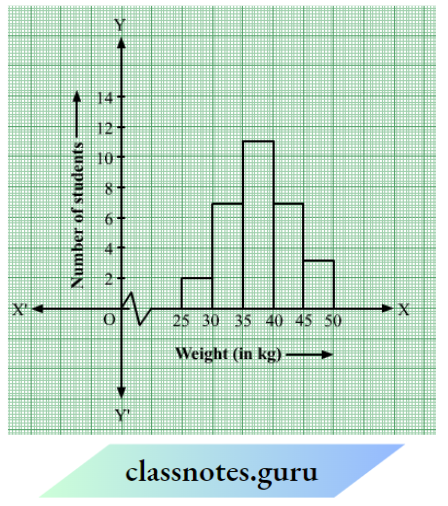
Question 1. The following graph shows a patient’s temperature in a hospital, recorded every hour.

Solution:
The patient’s temperature at 1 p.m. was 36.5°C.
The patient’s temperature was 38.5°C at 12 noon
The two times when the patient’s temperature was the same were 1 p.m. and 2 p.m.
The temperature at 1.30 p.m. was 36.5°C.
From the graph, we see that the temperature was constant from 1 p.m. to 2 p.m. Since 1.30 p.m. comes in between 1 p.m. and 2 p.m., therefore we arrived at our answer.
The patient’s temperature showed an upward trend during the periods 9 a.m. to 10 a.m., 10 a.m. to 11 a.m. and 2 p.m. to 3 p.m.
Question 2. The following line graph shows the yearly sales figures for a manufacturing company.
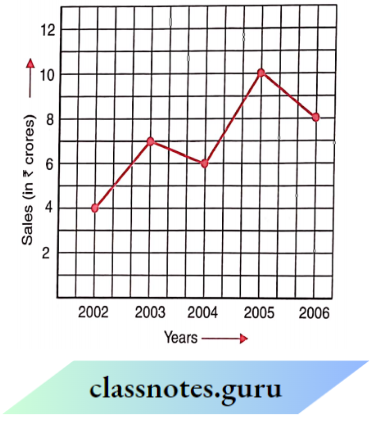
Solution:
The sales in
The sales in
The difference between the sales in 2002 and 2006 = ₹ 8 crores – ₹ 4 crores = ₹ 4 crores
The difference between the sales in 2002 and 2003 =₹ 7 crores – ? 4 crores =₹ 3 crores
The difference between the sales in 2003 and 2004=₹ 7 crores – ₹ 6 crores = ₹ 1 crore
The difference between the sales in 2004 and 2005 =₹ crores – ₹ 6 crores = ₹ 4 crores
The difference between the sales in 2005 and 2006
= ₹ 10 crores – ₹ 8 crores = ₹ 2 crores
Therefore, in the year 2005, the difference between the sales as compared to the previous year was the greatest.
Question 3. For an experiment in Botany, two different plants, plant A and plant B were grown under similar laboratory conditions. Their heights were measured at the end of each week for 3 weeks. The results are shown in the following graph.
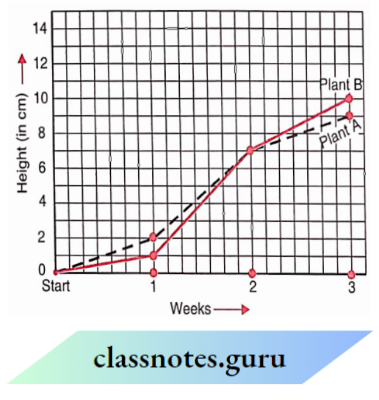
Solution:
1. The height of Plant A
2. The height of Plant B
3. Plant A grew 9 cm – 7 cm = 2 cm during the 3rd week.
4. From the end of the 2nd week to the end of the 3rd week, Plant B grew = 10 cm – 7 cm = 3 cm.
5. The Plant A grew in 1st week = 2 cm – 0 cm = 2 cm
The Plant A grew in 2nd week = 7 cm – 2 cm = 5 cm
The Plant A grew in 3rd week = 9 cm – 7 cm = 2 cm
Therefore, the Plant A grew mostly in Weeks second week
6. The Plant B grew in 1st week = 1 cm – 0 cm = 1cm
The Plant B grew in 2nd week = 7 cm – 1 cm = 6 cm
The Plant B grew in 3rd week = 10 cm – 7 cm = 3 cm
Therefore, Plant B grew the least in the first week.
7. At the end of the week, the two plants shown here were of the same height.
Question 4. The following shows the temperature forecast and the actual temperature for each day of the week:

Solution:

Since the maximum temperature difference is 7.5°C, therefore, the actual temperature filtered the most from the forecast temperature on Thursday.
Question 5. Use the tables below to draw linear graphs.
The number of days a hillside city received snow in different years

Population (in thousands) of men and women in a village in different years
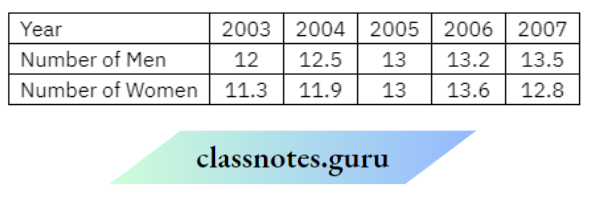
Solution:
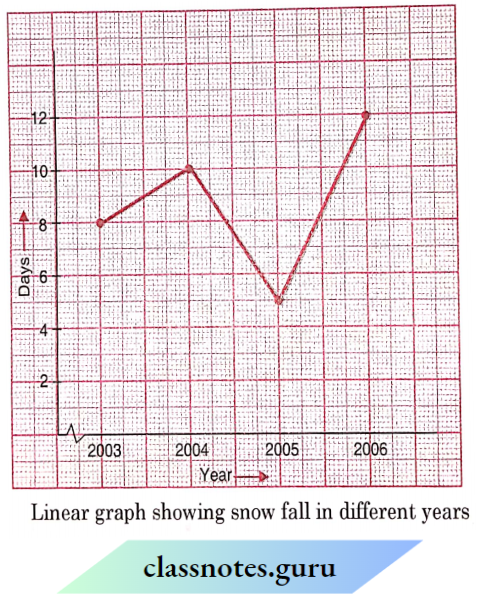
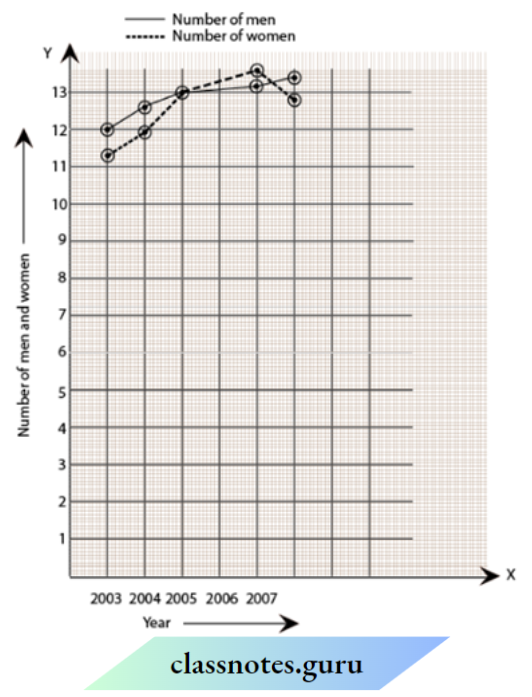
Class 8 Maths Chapter 13 Introduction to Graphs Solutions
Question 6. A courier person cycles from a town to a neighbouring suburban area to deliver a parcel to a merchant. His distance from the town at different times is shown in the following graph.

Solution:
1. The scale taken for the time axis (i.e., along the x-axis) is 4 units = 1 hour.
2. Time of the start of the travel = 8 a.m.
Time of the end of the travel = 11.30 a.m.
The time taken by the person for the travel = Difference between 8 a.m. and 11.30 a.m. = 31/2 hours.
3. The place of the merchant from the town is 22 km.
4. Yes. This is indicated by the horizontal part of the graph (10 a.m. -10.30 a.m.)
Distance covered by the person between 8 a.m. and 9 a.m. = (10 – 0) km = 10 km
Distance covered by the person between 9 a.m. and 10 a.m. = (16- 10)=6 km
covered by km the person between 10 a.m. and 10: 30 a.m. = (16 – 16) km = 0 km
Distance covered by the person between 10.30 a.m. and 11.30 a.m. = (22 – 16) km = 6 km
He rides fastest between 8 a.m. and 9 a.m
Question 7. Can there be a time-temperature graph as follows? Justify your answer.
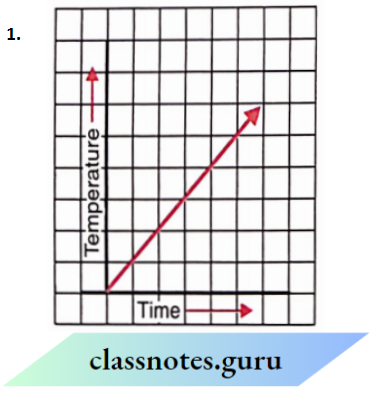
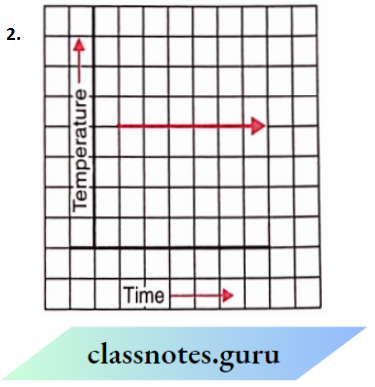
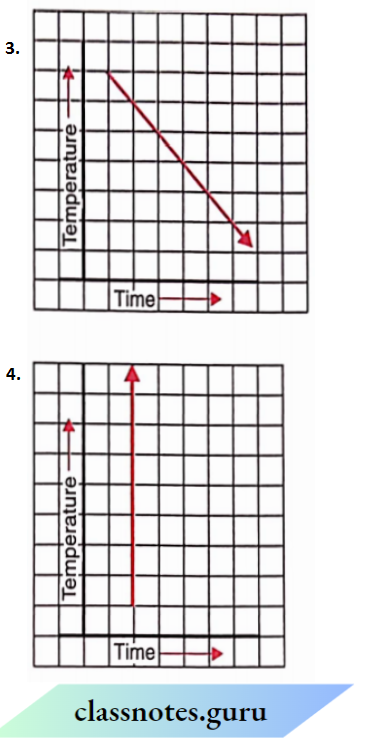
Solution:
In our daily life, we observe two quantities that are interrelated i.e., the change in one quantity is accompanied by a change in the other quantity, for example: the more the number of days a labourer works, the more the wages he gets. More the sugar we purchase, more the amount we have to pay.
In the first, case, the number of days is called the independent variable (or control variable) and the wages are called the dependent variable. Similarly, in the second case, the amount of sugar is the independent variable whereas the money paid is the dependent variable.
Thus, an independent variable is a variable which can take values freely i.e., whose value is not dependent on any other variable whereas a dependent variable is a variable where value depends upon the other variable, i.e., independent variable.
The relation between the independent and dependent variables can be shown by a graph.
Question 1. The number of litres of petrol you buy to fill a car’s petrol tank will decide the amount you have to pay. Which is the independent variable here? Think about it
Solution:
The independent variable here is the amount of petrol we buy to fill a car’s petrol tank.
Question 2. In the given example use the graph to find how much petrol can be purchased for 800.
Solution:
Mark the point representing 800 the on y-axis. From this point, draw a line, parallel to the line graph at point, draw a line parallel to OY to ow cut OX at a point This point represents litres on the x-axis Hence, 16 litres of petrol can be purchased for 800
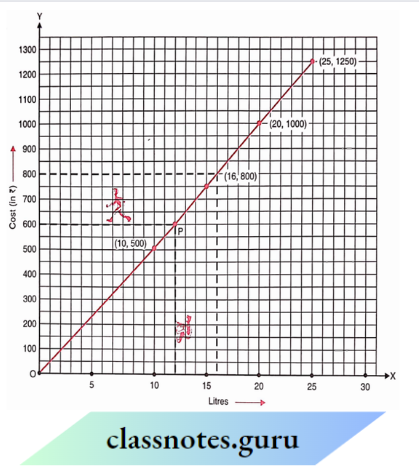
Question Is Example a case of direct variation?
Solution:
It is a case of direct variation as
⇒ \(\frac{100}{10}=\frac{200}{20}=\frac{300}{30}=\frac{500}{50}=\frac{1000}{100}\) = 10 (constant)
Question 1. Draw the graph for the following tables of values, with suitable scales on the axes.
1. Cost of apples

2. Distance travelled by car

3. Interest on deposits for a year

Solution:
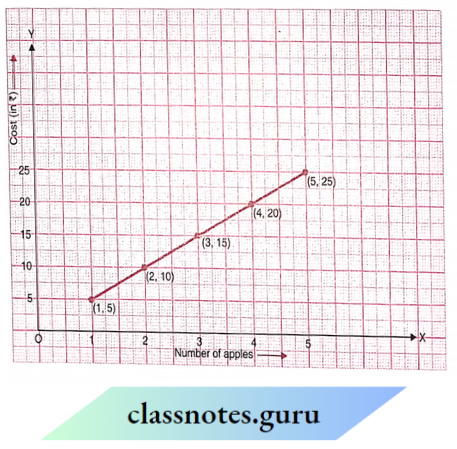
Scale:
On the horizontal axis: 2 units = 1 apple
On the vertical axis: 1 unit = ? 5
Mark the number of apples on the horizontal axis.
Mark cost (in ?)the on vertical axis.
Plot, the points: (1, 5), (2, 10), (3, 15), (4, 20) and (5, 25).
Join the points.
We get a linear graph.
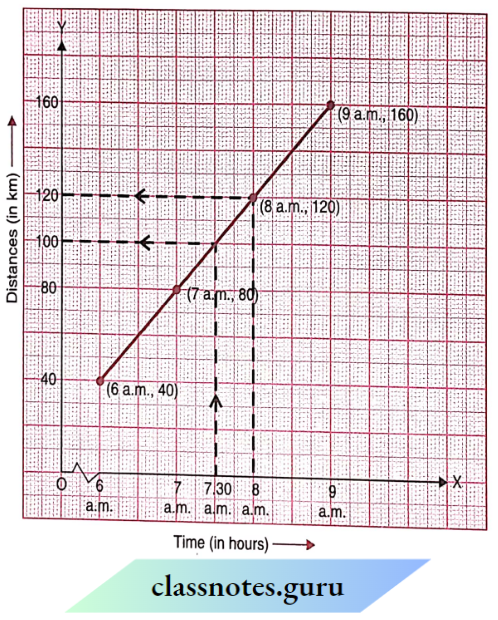
Scale :
On the horizontal axis: 2 units = 1 hour
On the vertical axis: 2 units = 40 km
Mark time (in hours)the on horizontal axis.
Mark distances (in km)the on vertical axis.
Plot the points (6 a.m., 40), (7 a.m., 80), (8 a.m., 120) and (9 a.m. 160).
Join the points.
We get a linear graph.
Distance covered during 7.30 a.m. to 8 a.m. = 120 km – 100 km = 20 km
The time when the car had covered a distance of 100 k Since its start was 7.30 a.m.
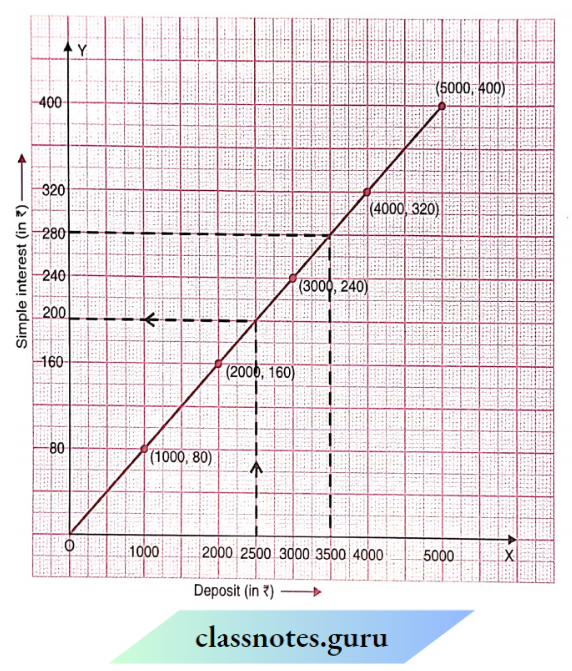
Scale :
On the horizontal axis: 2 units? 1000
On the vertical axis: 2 units 80
Mark deposit (in ?) on the horizontal axis.
Mark simple interest (in ?) on the vertical axis.
Plot the points (1000, 80), (2000, 160), (3000, 240), (4000, 320) and (5000, 400).
Join the points.
We get a linear graph.
Yes, The graph passes through the origin.
Interest o ? 2500 for a year = ? 200
To get an interest of? 280 per year? 3500 should be deposited.
Question 2. Draw a graph for the following:

Is it a linear graph?

Is it a linear graph?
Solution:

Scale:
On the horizontal axis : 1 unit = 1 cmOn thee vertical axi : 1 unit = 4 cm
Mark the side of the square (in cm) on the horizontal axis
Mark the perimeter (in cm) on vertical
Plot the points (2, 8), (3,12), (3.5, 14), (5, 20) and (6, 24).
Join the points.
Yes, It is a linear graph.

Scale :
On the horizontal axis: 2 units = 2 cm
On the vertical axis: 1 unit = 2 cm
Mark the side of the square (in cm) on the horizontal axis.
Mark the area (in cm2) on the vertical axis.
Plot the points (2, 4), (3, 9), (4, 16), (5, 25) and (6, 36).
Join the points.
The graph we get is not linear.
Introduction to Graphs Class 8 NCERT Solutions
Observe the following bar graph and answer the related questions:

Question 1. On which head, is the expenditure maximum?
Solution: 4. Salary of employees.
Question 2. On which head or head, is the expenditure minimum?
Solution: 1. Travelling allowance or rent
Question 3. On which two heads, is the expenditure the same?
Solution: 2. Travelling allowance and rent
Question 4. What is the difference in expenditure (in thousands of rupees) between the salary of employees and rent?
Solution: 3. 300
Question 5. What is the sum of the expenditures (in thousands of rupees) on travelling allowance and rent?
Solution: 2. 200
Observe the following circle graph and answer the related questions:
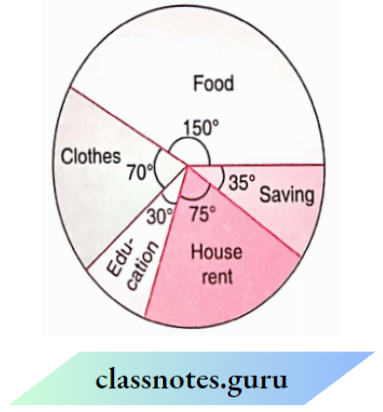
Question 6. On which head is the expenditure maximum?
Solution: 1. Food
Question 7. On which head is the expenditure minimum
Solution: 1. Education
Question 8. If the budget of the family is ₹ 10800, what is the savings?
Solution: 1. ₹ 1050
Question 9. What is the difference in spending on clothes and education the budget of the family is ₹ 1000.
Solution: 1. ₹ 1200
Question 10. What is the sum of the expenditures on food and education if the budget of the family is ₹ 1080?
Solution: 3. ₹ 8000
Observe the following circle graph and answer the related questions:
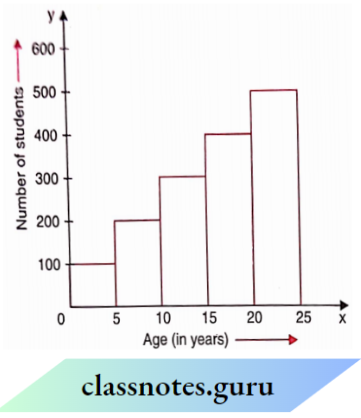
Question 11. In which class intervals, are the maximum number of students?
Solution: 3. 20-25
Question 12. In which class intervals, are the minimum number of students?
Solution: 1. 0-5
Question 13. In which class intervals, is the number of students 200?
Solution: 1. 0-5
NCERT Class 8 Maths Chapter 13 Exercise Solutions
Question 14. The difference in the number of students in class intervals 0-5 and 5- 10 is
Solution: 1. 100
Question 15. The sum of the number of students in the class intervals 10-15 and 20-25 is
Solution: 1. 800
Observe the following temperature-timeline graph and answer the related questions:
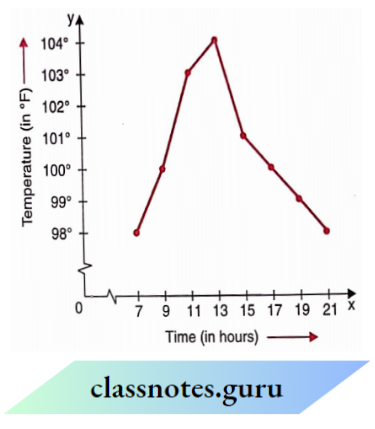
Question 16. At what time is the temperature maximum?
Solution: 1. 13 hours
Question 17. At what time(s) is the temperature minimum?
Solution: 1. 7 hours and 21 hours
Question 18. 103°F temperature is the time
Solution: 1. 11 hours
Question 19. What is the difference of temperatures at 7 hours and 21 hours?
Solution: 1. 0°F
Question 20. What is the rise in temperature from 11 hours to 13 hours?
Solution: 1. 1°F
Question 21. What is the fall in temperature from 13 hours to 21 hours?
Solution: 1. 2°F
Class 8 Maths Chapter 13 Question Answer
Question 22. The coordinates of the origin are
Solution: 1. (0,0)
Question 23. What are the coordinates of a point whose .v-coordinate is 3 andy-coordinate is 4?
Solution: 2. (3,4)
Question 24. What are the coordinates of a point whose x-coordinate is 1 and y-coordinate is 0?
Solution: 1. (1,0)
Question 25. What are the coordinates of a point whose v-coordinate is 0 and whose y-coordinate is?
Solution: 1. (0,1)
Observe the following velocity-lime graph and answer the related questions:
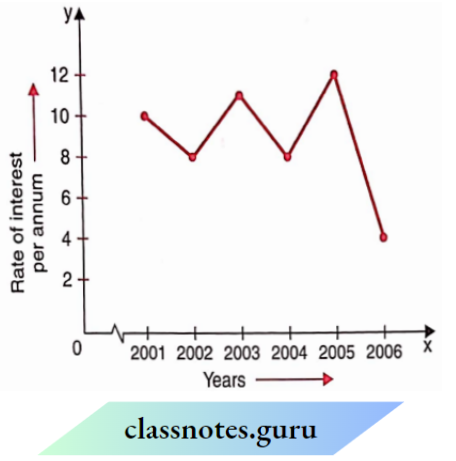
Question 26. At what time is the velocity maximum?
Solution: 1. 6
Question 27. At what time is the velocity minimum?
Solution: 4. 11
Question 28. At what times are the velocities equal?
Solution: 1. 8 and 12
Question 29. What is the fall in velocity from 7 to 1 1?
Solution: 1. 80 km/hour
Question 30. What is the rise in velocity from 11 to 12?
Solution: 4. 60 km/hour.
Observe the following runs-over graph and answer the related questions:
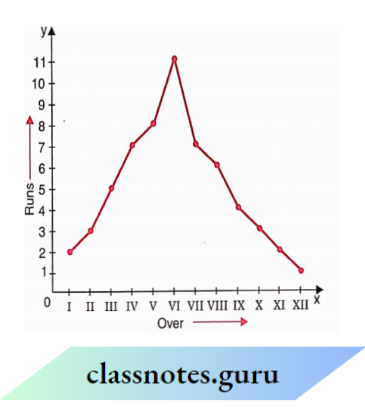
Question 31. In which over is the maximum scoreboard scored?
Solution: 4. 6
Question 32. In which over are the maximum runs scored?
Solution: 3. 12
Question 33. What is the difference in runs scored in IV and V overs?
Solution: 1. 1
Question 34. What is the sum of runs scored in I and XII overs?
Solution: 1. 1
Question 35. 3 runs are scored in which over?
Solution: 3. 7 and 8
Class 8 Maths NCERT Chapter 13 Graph Questions
Read the graph and answer the related questions:

Question 36. In which year was the rate of interest maximum?
Solution: 1. 2005
Question 37. In which year was the rate of interest minimum
Solution: 1. 2006
Question 38. The difference in the maximum and minimum rates of interests
Solution: 4. 8%.
Question 39. The rise in interest from 2004 to 2005 was
Solution: 2. 4%
Question 40. The fall in interest from 2001 to 2002 was
Solution: 2. 2%
Read the graph and answer the related questions :
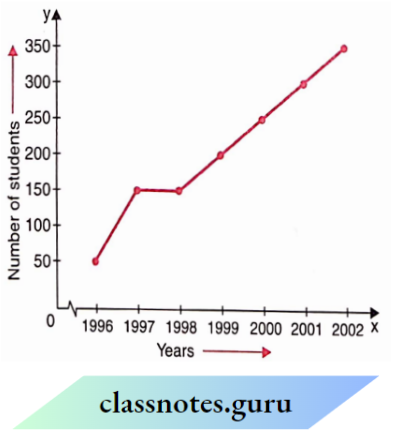
Question 41. How many students appeared in the year 2000?
Solution: 2. 250
Question 42. In which year did 50 students appear?
Solution: 4. 1996.
Question 43. In which year did the maximum number of students appear?
Solution: 1. 2002
Question 44. What is the maximum number of students that appeared in any year?
Solution: 1. 350
Question 45. In which two years was the number of students appearing the same?
Solution: 1. 1997 and 1998
Introduction to Graphs Class 8 Chapter Explanation and Solutions
Read the graph and answer the related questions:
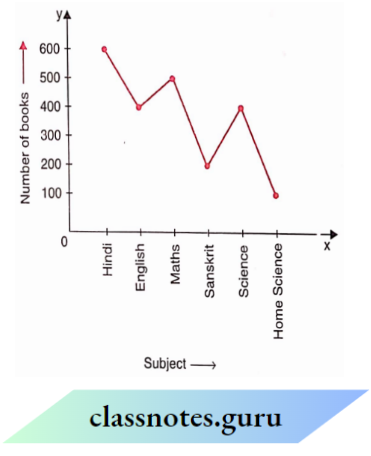
Question 46. The maximum books are of which subject?
Solution: 1. Hindi
Question 47. The minimum books are of which subject
Solution: 1. Home Science
Question 18. 500 books are of which subject
Solution: 4. Maths.
Question 49. How many books are on the subject of Home Science?
Solution: 1. 100
Question 50. How many books are there in Sanskrit and Home Science taken together?
Solution: 3. 300
Read the graph and answer the related questions:
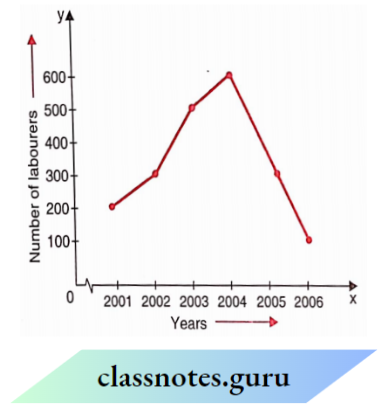
Question 51. In which year was the number of labourers maximum?
Solution: 4. 2004
Question 52. In which year was the number of labourers minimum?
Solution: 4. 2006
Question 53. What was the difference in the number of labourers in the years 2002 and 203?
Solution: 2. 200
Question 54. Find the rise in the number of labourers from 2001 to 2004.
Solution: 3. 400
NCERT Solutions for Class 8 Maths Chapter 13 Introduction to Graphs with Examples
Question 55. Find the sum of the number of labourers in the years 2004 and 2006.
Solution: 1. 700
Read the circle graph and answer the related questions:

Question 56. There are in all 101000 students a school. The number of students in the class I are
Solution: 1. 500
Question 57. The number of students in class II is
Solution: 2. 250
Question 58. In which two classes is the number of students the sesame
Solution: 3. 3 and 4
Question 59. The minimum number of students in any class is
Solution: 1. 125
Question 60. The sum of the number of students in class 3 and class 4 is
Solution: 4. 250
Write whether the following statements are ‘D ue or False:
1. The coordinates of the origin are (0, 0): True
2. The .v-coordinate of a point is its distance from r-the axis: False
3. For fixing a point on the graph sheet, we need two coordinates: True
4. The relation between the pendent variable and the dependent variable is shown through a graph: True
Class 8 Chapter 13 Graphs Questions and Answers Step-by-Step
1. Comparison of parts of a whole can be done by_____: pie chart
2. A point which lies on both these is_____: (0,0)
3. The r-coordinate of every point lying on the y-axis is_____: 0
4. The process of fixing a point with the help of x and y coordinates is called_____of the point: Plotting
5. What will you get after joining the points (-1, -1), (0, 0) and (3, 3): A straight line passing through the origin
6. What will you get after joining the points (1, 0), (1, 1) and (1, -1): A straight line not passing through the origin
7. What is the distance of the point (3, 4) from s-axis: 4
8. In the following graph, what are the coordinates of P: (3,2)
Graph Plotting and Interpretation Class 8 Maths Chapter 13 Solutions
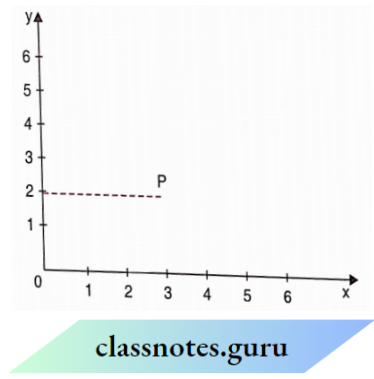
9. In the following graph, which letter indicates (the point (3, 0): A

Class 8 Chapter 1 Rational Numbers Worksheet with Answers
Read and Learn More NCERT Solutions For Class 8 Maths
The list of properties of rational Numbers can be given as follows :
Whole numbers
Question 1. 4 + 7 =________________ Is it a whole number
Solution:
4 + 7=11
Yes, It is a whole number.
Question 2. 3 × 7 = _______________Is it a whole number?
Solution:
3 × 7 = 21
Yes, It is a whole number
Question 3. Check for closure property under all four operations for natural numbers
Solution:
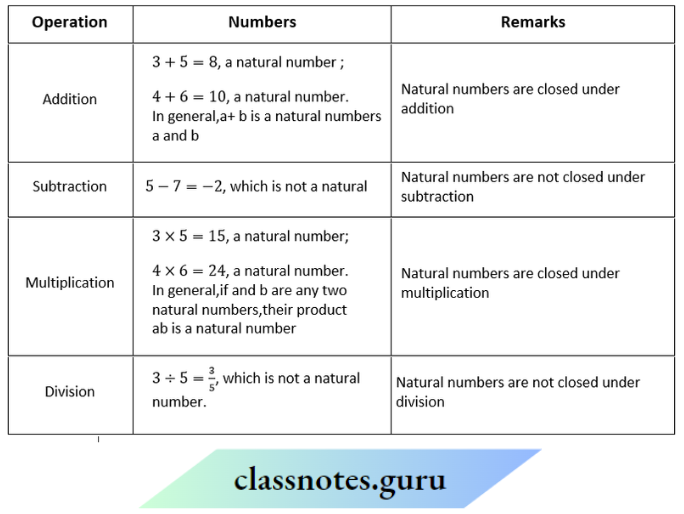
Integers
Question 1. Is – 7 + (- 5) an integer?
Solution:
– 7 + (- 5)
– 7 + (- 5) = – 12
Yes, Which is an integer.
Question 2. Is 8 + 5 an integer?
Solution:
8 + 5
8 + 5 = 13
Yes, Which is an integer
Question 3. Is 5 – 7 an integer?
Solution:
5 – 7
5 – 7 = -2
Yes, Which is an integer.
Question 4. Is 8 – (- 6) an integer?
Solution:
8 – (- 6)
8 – (- 6) = 8 + 6
= 14,
Yes, Which is an integer.
Question 5. Is – 5 × 8= do integer?
Solution:
– 5 × 8
– 5 × 8= – 40
Yes, Which is an integer
Rational numbers
Question 1.\(\frac{-3}{8}+\frac{(-4)}{5}\)= ________ Is it a rational number ?
Solution:
⇒ \(\frac{-3}{8}+\frac{(-4)}{5}\)
=\(\frac{-15+(-32)}{40}\)
= \(\frac{-47}{40}\)
Yes, It is a rational number
Question 2. \(\frac{5}{8}-\frac{4}{5}=\frac{25-32}{40}\) = _________________ it is a ralional number?
Solution:
⇒ \(\frac{5}{8}-\frac{4}{5}\)
= \(\frac{25-32}{40}\)
= \(\frac{-7}{40}\)
Yes, It is a rational number.
Question 3. \(\frac{-5}{9}+\frac{(-7)}{6}\) _______________ Is it a rational number?
Solution:
⇒ \(\frac{3}{7}-\left(\frac{-8}{5}\right)=\frac{3}{7}+\frac{8}{5}\)
= \(\frac{15+56}{35}\)
=\(\frac{71}{35}\) .
Yes, It is a rational number.
Question 4. \(\frac{4}{7}+\frac{6}{11}\) Is it a rational number ?
Solution:
⇒ \(\frac{4}{7}+\frac{6}{11}\)
= \(\frac{44+42}{77}=\frac{86}{77}\)
Yes, It is a rational number
Question 5. \({4}{5} \times \frac{-6}{11}\)___________Is it a rational number?
Solution:
⇒ \(\frac{4}{5} \times \frac{-6}{11}\)
= \(\frac{24}{55}\)
Yes, It is a rational number.
Question 6. \(\frac{2}{7}+\frac{5}{3}\)= _______________Is it a rational number?
Solution:
⇒ \(\frac{2}{7} \div \frac{5}{3}\)
=\(\frac{2}{7} \times \frac{3}{5}\)
= \(\frac{6}{35}\)
Yes, It is a rational number
Question 7. \(\frac{-3}{8}+\frac{-2}{9}\)= ______________ It is a rational numbers
Solution:
⇒ \(\frac{-3}{8} \div \frac{-2}{9}\)
= \(\frac{-3}{8} \times \frac{-9}{2}\)
= \(\frac{27}{16}\)
Yes, it is a rational number.
Rational Numbers Class 8 Maths Notes and Q&A
Question 8. Check it for a few more pairs of rational numbers
1. \(\frac{3}{5}+\frac{7}{13}\)
Solution:
⇒ \(\frac{3}{5}+\frac{7}{13}\)
= \(\frac{39+35}{65}\)
= \(\frac{74}{65}\)
Rational number
2. \(\frac{3}{7}+\frac{(-4)}{9}\)
Solution:
⇒ \(\frac{3}{7}+\frac{(-4)}{9}\)
= \(\frac{27+(-28)}{63}\)
Rational number
3. \(\frac{-5}{9}+\frac{(-7)}{6}\)
Solution:
⇒ \(\frac{-5}{9}+\frac{(-7)}{6}\)
= \(\frac{-10+(-21)}{18}\)
Rational number
Question 9. Try this for some more pairs of rational numbers
1. \(\frac{-3}{8}-\frac{4}{5}\)
Solution:
⇒ \(\frac{-3}{8}-\frac{4}{5}\)
= \(\frac{-15-32}{40}\)
=\(\frac{-47}{40}\)
Rational number
2. \(\frac{2}{9}-\frac{3}{7}\)
Solution:
⇒ \(\frac{2}{9}-\frac{3}{7}\)
= \(\frac{14-27}{63}\)
= –\(\frac{13}{63}\)
Rational number
3. \(\frac{-3}{4} \times \frac{7}{8}\)
Solution:
⇒ \(\frac{-3}{4} \times \frac{7}{8}\)
= –\(\frac{21}{32}\)
Rational number
4. \(\frac{5}{8} \times \frac{3}{7}\)
Solution:
⇒ \(\frac{5}{8} \times \frac{3}{7}\)
= \(\frac{15}{56}\)
Rational number
Question 10. Fill in the blanks in the following table
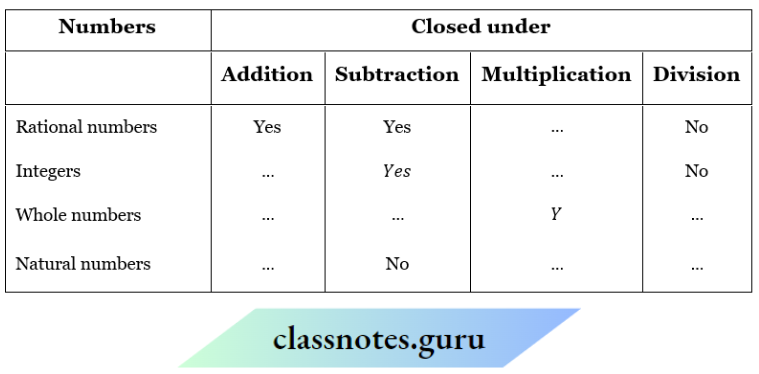
Solution:

Whole numbers
Question 1. Recall the commutativity of different operations for whole numbers by filling the following table.
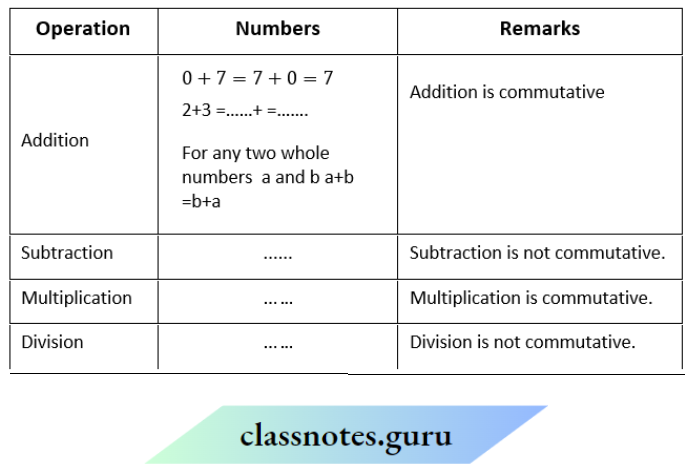
Check whether the commutativity of the. operations hold for natural numbers also.
Solution:
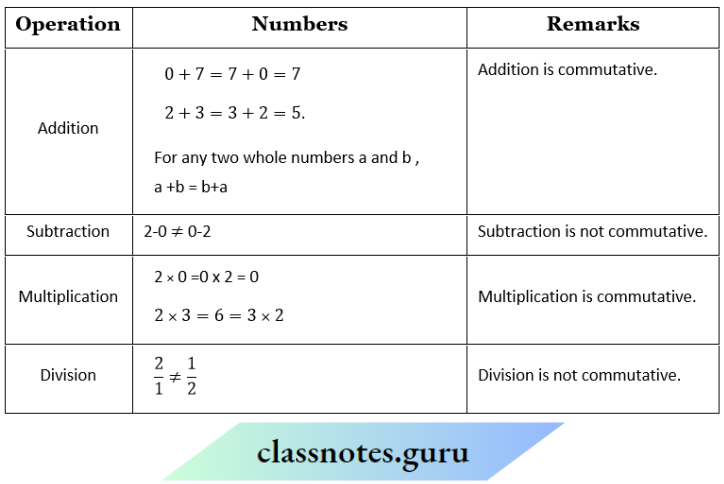
Commutativity of the operations for natural numbers also.
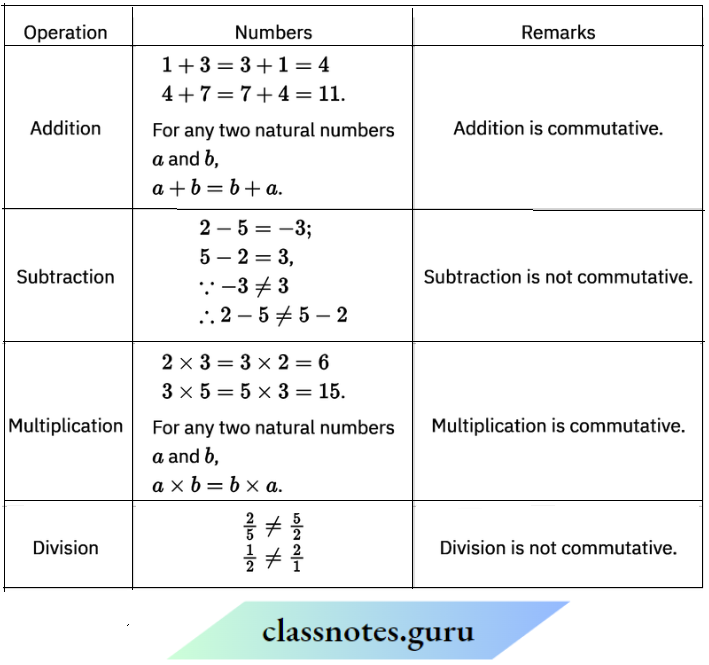
Integers
Question 1. Fill in the following table and check the commutativity of different operations for integers:
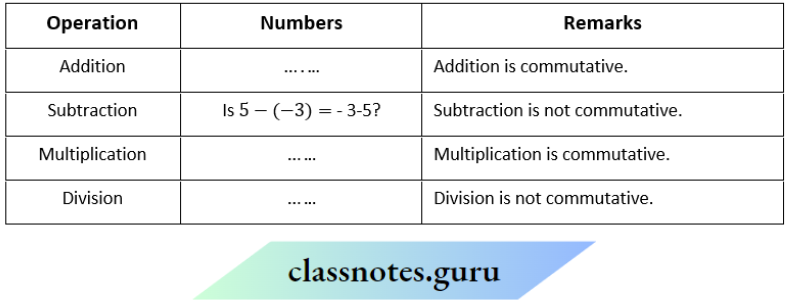
Solution:

Rational numbers
Question 1. \(\frac{-6}{5}+\left(\frac{-8}{3}\right)\) = \(\ldots \ldots \text { and } \frac{-8}{3}+\left(\frac{-6}{5}\right)=\ldots\) Is \(\frac{-6}{5}+\left(\frac{-8}{3}\right) \)= \(\left(\frac{-8}{3}\right)+\left(\frac{-6}{5}\right) \)
Solution:
⇒ \(\frac{-6}{5}+\left(\frac{-8}{3}\right)\)
= \( \frac{-18+(-40)}{15}=\frac{-58}{15}\)
= \(\frac{-8}{3}+\left(\frac{-6}{5}\right)\)
= \(\frac{-40+(-18)}{15}=\frac{-58}{15}\)
So, \(\frac{-6}{5}+\left(\frac{-8}{3}\right)=\left(\frac{-8}{3}\right)+\left(\frac{-6}{5}\right)\)
Question 2. Is \(\frac{3}{8}+\frac{1}{7}=\frac{1}{7}+\left(\frac{-3}{8}\right)\)?
Solution.
⇒ \(\frac{-3}{8}+\frac{1}{7}=\frac{-21+8}{56} \)
= \(\frac{-13}{56}\)
= \(\frac{1}{7}+\left(\frac{-3}{8}\right)=\frac{8+(-21)}{56}\)
= \(\frac{-13}{56}\)
So, \(\frac{-3}{8}+\frac{1}{7}=\frac{1}{7}+\left(\frac{-3}{8}\right)\).
Class 8 Maths Chapter 1 NCERT Workbook Answers
Question 3. Is \(\frac{2}{3}-\frac{5}{4}=\frac{5}{4}-\frac{2}{3}\)
Solution:
⇒ \(\frac{2}{3}-\frac{5}{4}=\frac{8-15}{12}=\frac{-7}{12} \)
⇒ \(\frac{5}{4}-\frac{2}{3}=\frac{15-8}{12}=\frac{7}{12}\)
⇒ \(\frac{-7}{12} \neq \frac{7}{12} \)
∴ \(\frac{2}{3}-\frac{5}{4} \neq \frac{5}{4}-\frac{2}{3} \)
⇒ \(\frac{1}{2}-\frac{3}{5}=\frac{3}{5}-\frac{1}{2} \)
⇒ \(\frac{1}{2}-\frac{3}{5}=\frac{5-6}{10}=\frac{-1}{10} \)
⇒ \(\frac{3}{5}-\frac{1}{2}=\frac{6-5}{10}=\frac{1}{10} \)
⇒ \(\frac{-1}{10} \neq \frac{1}{10} \)
⇒ \(\frac{1}{2}-\frac{3}{5} \neq \frac{3}{5}-\frac{1}{2}\)
Question 4. \(\frac{-8}{9} \times\left(\frac{-4}{7}\right)=\frac{32}{63} \)
Solution:
⇒ \(\frac{-4}{7} \times\left(\frac{-8}{9}\right)=\frac{32}{63}\)
So, \(\frac{-8}{9} \times\left(\frac{-4}{7}\right)=\frac{-4}{7} \times\left(\frac{-8}{9}\right)\)
Question 5. \(\frac{-5}{9} \times \frac{7}{8}\)
Solution:
= \(\frac{7}{8} \times\left(\frac{-5}{9}\right)\)
= \(\frac{-35}{72}\)
Question 6. \(\frac{-6}{11} \times\left(\frac{-3}{5}\right)\)
Solution:
⇒ \(\frac{-6}{11} \times\left(\frac{-3}{5}\right)\)
=\(\frac{-3}{5} \times\left(\frac{-6}{11}\right)\)
= \(\frac{18}{55}\)
⇒ \(\frac{2}{3} \times \frac{4}{7}=\frac{4}{7} \times \frac{2}{3}=\frac{8}{21}\)
Question 7. Is \(\frac{-5}{4} \div \frac{3}{7}=\frac{3}{7}\div\left(\frac{-5}{4}\right)\)
Solution:
⇒ \(\frac{-5}{4} \div \frac{3}{7}=\frac{3}{7} \div\left(\frac{-5}{4}\right)\)
= \(\frac{-35}{12}\)
And \(\frac{3}{7} \div \frac{-5}{4}=\frac{3}{7} \times\left(\frac{-4}{5}\right) \)
= \(\frac{-12}{35}\)
Since \(\frac{-35}{12} \neq \frac{-12}{35} \)
∴ \(\frac{-5}{4} \div \frac{3}{7} \neq \frac{3}{7} \div\left(\frac{-5}{4}\right)\)
Question 8. Complete the following table:

Solution:

Whole numbers
Question 1. Recall the associativity of the four operations for whole numbers through this table

Fill in this table and. verify the remarks given in the last column. Check for yourself the associativity of different operations for natural numbers
Solution:
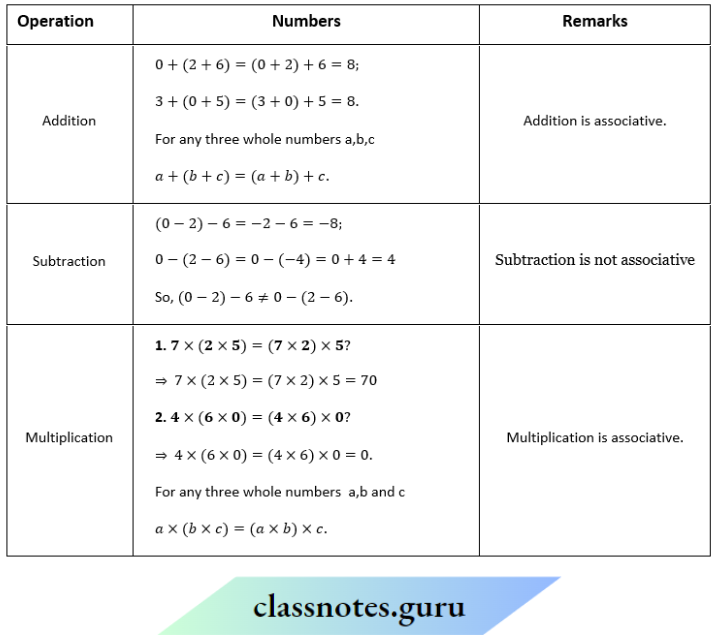
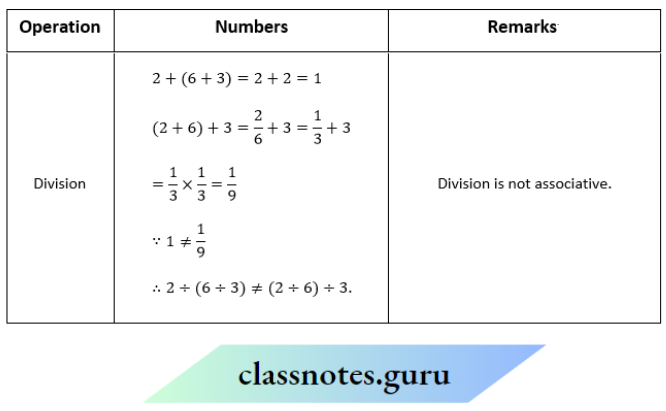
Integers
Question 1. Is (-2) + [3 + (-4)] = [(-2) + 3] + (-4)?
Solution:
Yes; (-2) + [3 + (-4)]
= [(-2) + 3] + (-4)
= -3.
Addition is associative
Question 2. -Is (-6) +[(-4) +(-5)] = (-6) + (-4)] + (-5)?
Solution:
Yes; (-6) + [(-4) + (-5)]
= [(-6) + (-4)] + (-5)
= -15
Addition is associative
NCERT Solutions for Class 8 Maths Chapter 1 Rational Numbers with Explanation
Question 3. Is 5 – (7 – 3) = (5 – 7) – 3?
Solution:
5 – (7 – 3) = 5 – 4
= 1
(5 – 7) – 3 = -2 – 3
= -5
1 ≠ – 5
∴ No; 5 – (7 – 3) ≠ (5 – 7) – 3.
Subtraction is not associative
Question 4. Is 5× [(- 7) × (-8)] = [5× (- 7)] × (- 8) ?
Solution:
Yes; 5 × [(-7) × (-8)]
= [5× (-7)] ×(-8)
= 280.
Multiplication is associative
Question 5. Is (- 4) × [(- 8)×(- 5)]= (-4) x (-8)]× (-5)
Solution:
Yes; (-4) × [(-8) × (-5)]
= [(-4) × (-8)] × (-5)
= -160
Multiplication is associative
Question 6. Is [(-10) ÷ 2] ÷ (- 5)= (-10) ÷[2 ÷ (-5)]?
Solution:
[(-10) ÷ 2] ÷ (-5)= (-5) ÷ (-5) = 1
(-10) ÷ [2 ÷ (-5)]= (-10) ÷ \(\frac{-2}{5}\)
= (-10) ×\(\frac{-5}{2}\)
= 25
∴ 1 ≠ 25
∴ No; [(-10) ÷ 2] ÷ (-5)≠ (-10) ÷ [2 ÷ (-5)]
The division is not associative
Rational numbers
Question 1. Find \(\frac{-1}{2}+\left[\frac{3}{7}+\left(\frac{-4}{3}\right)\right]\) and \(\left[\frac{-1}{2}+\frac{3}{7}\right]+\left(\frac{-4}{3}\right) \text {. }\) Are the two sums equal?
Solution:
⇒ \(\frac{-1}{2}+\left[\frac{3}{7}+\left(\frac{-4}{3}\right)\right]\)
= \(\frac{-1}{2}+\frac{9+(-28)}{21}=\frac{-1}{2}+\left(\frac{-19}{21}\right)\)
= \(\frac{-21+(-38)}{42}=\frac{-59}{42}\)
And \( {\left[\frac{-1}{2}+\frac{3}{7}\right]+\left(\frac{-4}{3}\right)}\)
= \(\frac{-7+6}{14}+\left(\frac{-4}{3}\right)=\frac{-1}{14}+\left(\frac{-4}{3}\right)\)
= \(\frac{-3+(-56)}{42}=\frac{-59}{42}\)
= \(\frac{-1}{2}+\left[\frac{3}{7}+\left(\frac{-4}{3}\right)\right] \)
= \(\left[\frac{-1}{2}+\frac{3}{7}\right]+\left(\frac{-4}{3}\right)\)
= \(\left[\frac{-1}{2}+\frac{3}{7}\right]+\left(\frac{-4}{3}\right)\)
Question 2. \(\frac{-3}{4}+\left[\frac{2}{3}+\left(\frac{-6}{7}\right)\right]\)
Solution:
⇒ \(\frac{-3}{4}+\left[\frac{2}{3}+\left(\frac{-6}{7}\right)\right]\)
= \(\frac{-3}{4}+\frac{14+(-18)}{21}=\frac{-3}{4}+\left(\frac{-4}{21}\right)\)
= \(\frac{-63+(-16)}{84}=\frac{-79}{84} \)
= \(\left[\frac{-3}{4}+\frac{2}{3}\right]+\left(\frac{-6}{7}\right) \)
= \(\frac{-9+(8)}{12}+\left(\frac{-6}{7}\right)=\frac{-1}{12}+\left(\frac{-6}{7}\right) \)
= \(\frac{-7+(-72)}{84}=\frac{-79}{84}\)
So, yes \(\frac{-3}{4}+\left[\frac{2}{3}+\left(\frac{-6}{7}\right)\right]\)
= \(\left[\frac{-3}{4}+\frac{2}{3}\right]+\left(\frac{-6}{7}\right) \)
Question 3. \( \frac{-1}{4}+\left[\frac{2}{9}\right.\left.+\left(\frac{-5}{11}\right)\right] \)
Solution:
⇒ \( \frac{-1}{4}+\left[\frac{2}{9}\right.\left.+\left(\frac{-5}{11}\right)\right] \)
= \(\frac{-1}{4}+\left(\frac{22-(45)}{99}\right) \)
= \(\frac{-1}{4}+\left(\frac{-23}{99}\right) \)
⇒ \(\left[\frac{-1}{4}\right.\left.+\frac{2}{9}\right]+\left(\frac{-5}{11}\right)\)
= \(\frac{-99+(-92)}{396}=\frac{-191}{396}\)
= \(\frac{-9+8}{36}+\left(\frac{-5}{11}\right)\)
= \(\frac{-1}{36}+\left(\frac{-5}{11}\right)=\frac{-11+(-180)}{396}\)
= \(\frac{-191}{396} \)
⇒ \(\frac{-1}{4}+\left[\frac{2}{9}+\left(\frac{-5}{11}\right)\right] \)
= \(\left[\frac{-1}{4}+\frac{2}{9}\right]+\left(\frac{-5}{11}\right)\)
Question 4. \(\frac{-2}{3}-\left[\frac{-4}{5}-\frac{1}{2}\right]\) Check for yourself
Solution:
= \(\left[\frac{-2}{3}-\left(\frac{-4}{5}\right)\right]-\frac{1}{2}\)
= \(\frac{-2}{3}-\left[\frac{-4}{5}-\frac{1}{2}\right]\)
= \(\frac{-2}{3}-\left(\frac{-8-5}{10}\right)=\frac{-2}{3}-\left(\frac{-13}{10}\right)\)
= \(\frac{-2}{3}+\frac{13}{10}=\frac{-20+39}{30}=\frac{19}{30}\)
And \({\left[\frac{-2}{3}-\left(\frac{-4}{5}\right)\right]-\frac{1}{2}=\left[\frac{-2}{3}+\frac{4}{5}\right]-\frac{1}{2}} \)
= \(\left[\frac{-10+12}{15}\right]-\frac{1}{2}=\frac{2}{15}-\frac{1}{2} \)
= \(\frac{4-15}{30}=\frac{-11}{30}\)
So, No ; \(\frac{-2}{3}-\left[\frac{-4}{5}-\frac{1}{2}\right]\)≠ \(\frac{-2}{3}\)– (\(\frac{-4}{5}\)) – \(\frac{1}{2}\)
Question 5. \(\left(\frac{-7}{3} \times \frac{5}{4}\right) \times \frac{2}{9}\)___________
Solution:
⇒\(\left(\frac{-7}{3} \times \frac{5}{4}\right) \times \frac{2}{9}=\frac{-35}{12} \times \frac{2}{9}\)
=\(\frac{-35}{54}\)
So, Yes ;
Question 6. Is \(\frac{2}{3} \times\left(\frac{-6}{7} \times \frac{4}{5}\right)=\left(\frac{2}{3} \times \frac{-6}{7}\right) \times \frac{4}{5} \)
Solution:
⇒ \(\frac{2}{3} \times\left(\frac{-6}{7} \times \frac{4}{5}\right)\)
= \(\frac{2}{3} \times \frac{-24}{35}=\frac{-48}{105}\)________ (1)
= \(\frac{2}{3}\)× \(\frac{-6}{7}\)× \(\frac{4}{5}\)
= \(\frac{-12}{21} \times \frac{4}{5}=\frac{-48}{105}\)________ (2)
So, Yes; A = B
Class 8 Maths Chapter 1 Rational Numbers Step-by-Step Answers
Question 7. \(\frac{-6}{5} \times\left(\frac{2}{3} \times \frac{1}{8}\right)\)
Solution:
⇒ \(\frac{-6}{5} \times\left(\frac{2}{3} \times \frac{1}{8}\right)=\frac{-6}{5} \times \frac{1}{12}\)
=\(\frac{-1}{10}\)
And \(\left(\frac{-6}{5} \times \frac{2}{3}\right) \times \frac{1}{8}=\frac{-4}{5} \times \frac{1}{8}=\frac{-1}{10}\)
So, Yes
⇒ \(\frac{-6}{5} \times\left(\frac{2}{3} \times \frac{1}{8}\right)=\left(\frac{-6}{5} \times \frac{2}{3}\right) \times \frac{1}{8}\)
Question 8. \(\frac{2}{7} \times\left(\frac{-5}{9} \times \frac{2}{3}\right) \)
Solution:
⇒ \(\frac{2}{7} \times\left(\frac{-5}{9} \times \frac{2}{3}\right) \)
=\(\frac{2}{7} \times\left(\frac{-10}{27}\right)=\frac{-20}{189} \)
= \(\left(\frac{2}{7} \times \frac{-5}{9}\right) \times \frac{2}{3}=\frac{-10}{63} \times \frac{2}{3}\)
=\(\frac{-20}{189}\)
So, Yes; A=B
Question 9. \(\frac{1}{2}+\left[\frac{-1}{3}+\frac{2}{5}\right]=\left[\frac{1}{2}+\left(\frac{-1}{3}\right)\right]+\frac{2}{5}\),Is L.H.S. =R.H.S. ? Check for yourself
Solution:
L.H.S.\(\frac{1}{2}+\left(\frac{-1}{3}+\frac{2}{5}\right)\)
= \(\frac{1}{2} \div\left(\frac{-1}{3} \times \frac{5}{2}\right)\)
= \(\frac{2}{5} is \frac{5}{2}\)
= \(\frac{1}{2}+\left(-\frac{5}{6}\right) \)
= \(\frac{1}{2} \times \frac{-6}{5}=\frac{-3}{5} \)
R.H.S= \(\left[\frac{1}{2}+\left(\frac{-1}{3}\right)\right]+\frac{2}{5}\)
= \(\left(\frac{1}{2} \times \frac{-3}{1}\right) \div \frac{2}{5}=\frac{-3}{2}+\frac{2}{5} \)
= \(\frac{-3}{2} \times \frac{5}{2}=\frac{-15}{4}\)
So, No; L.H.S ≠R. H.S.
Question 10. Complete the following table:
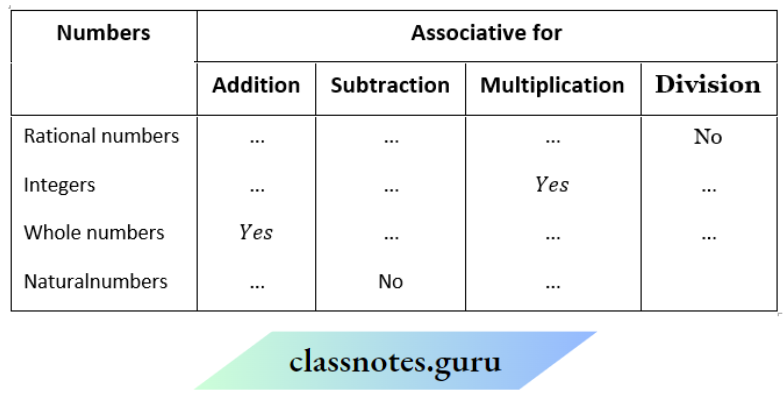
Solution:
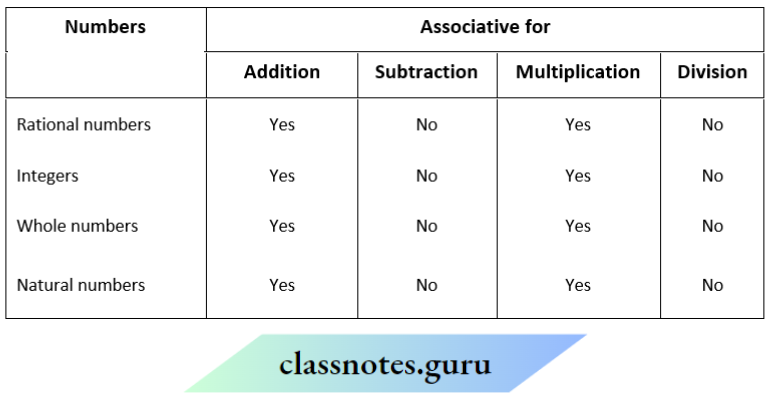
Question 11. Do you think the properties commutativity and associativity made the calculations
Solution.
Yes! The properties of commutativity and associativity made the calculations easier
Question 1. \(-5+0=\ldots \ldots. \ldots \ldots .=-5\)
Solution:
-5+0=0+(-5)=-5
Question 2. \(\frac{-2}{7}+\ldots \ldots .=0+\left(\frac{-2}{7}\right)=\frac{-2}{7}\)
⇒ \(\frac{-2}{7}+0=0+\left(\frac{-2}{7}\right)=\frac{-2}{7}\)
Question 3. Do a few more such additions. What do you observe?
Solution:
1. 3 + 0 = 0 + 3 = 3
2. -9 +0 = 0 + (-9) = -9
3.\(\frac{-3}{4}+0=0+\left(\frac{-3}{4}\right)=\frac{-3}{4}\)
We observe that when we add 0 to a whole number, the sum is again that whole number. This happens for integers and rational numbers also.
Question 1. \(\frac{-2}{7} \times 1=\ldots \ldots . . \times \ldots . .=\frac{-2}{7}\)
Solution:
– \(\frac{2}{7} \times 1=1 \times \frac{-2}{7}=\frac{-2}{7}\)
Question 2. \(\frac{3}{8} \times \ldots \ldots=1 \times \frac{3}{8}=\frac{3}{8}\)
Solution:
⇒ \(\frac{3}{8} \times 1=1 \times \frac{3}{8}\)
= \(\frac{3}{8}\)
Question 3. What do you find?
Solution:
We find that when we multiply any rational number by 1, we get back the same rational number as the product
Question 4. Check for a few more rational numbers
1. 7 × 1
Solution:
7 × 1 = 7 = 1 × 7
2.\(\frac{-3}{5} \times 1\)
Solution:
⇒ \(\frac{-3}{5} \times 1\)
=\(1 \times \frac{-3}{5}=\frac{-3}{5}\)
3. \(\frac{7}{9} \times 1\)
Solution:
⇒ \(\frac{7}{9} \times 1\)
= \(1 \times \frac{7}{9}=\frac{7}{9}\)
Question 5. Is 1 the multiplicative identity for integers? For whole numbers?
Solution:
Yes, 1 is the multiplicative identity for integers as well as for whole numbers.
Question 6. If a property holds for rational numbers, will it also hold for integers?
Solution:
1. Except for the following property, the properties of the rational numbers will also hold good for integers :
If a and b are rational numbers, then a÷b is also a rational number if b ≠ 0 but a÷ b is not necessarily an integer where a and b are integers
Example: \(\frac{4}{5}\)is a rational number. Here 4 and 5 are integers, while \(\frac{4}{5}\) is not an integer
2. Except for the following properties, the properties of the rational numbers will also hold good for whole numbers:
If a and b are rational numbers, then, a- b is also a rational number. But if a and b are whole numbers, then A b is not necessarily a whole number
Let 4 and 5 be whole numbers, but 4 – 5 = -1 is not a whole number.
2. If a and b are rational numbers, then, a + b is a rational number if b but if a and b are whole numbers, then a + b is not necessarily a whole number.
Example: 4 and 5 are whole numbers but \(\frac{4}{5}\) is not a whole number
Rational Numbers Class 8 NCERT Solutions with Practice Questions
For all rational numbers a, b, and c,
a(b + c) = ab + ac.
a(b-c) = ab – ac
Question 1. \(\left\{\frac{7}{5} \times\left(\frac{-3}{12}\right)\right\}+\left\{\frac{7}{5} \times \frac{5}{12}\right\}\)
Solution:
⇒ \(\left\{\frac{7}{\mathbf{5}} \times\left(\frac{-3}{12}\right)\right\}+\left\{\frac{7}{5} \times \frac{\mathbf{5}}{\mathbf{1 2}}\right\}\)
= \(\frac{7}{5} \times\left\{\left(\frac{-3}{12}\right)+\frac{5}{12}\right\} \)
= \(\frac{7}{5} \times\left\{\frac{(-3)+5}{12}\right\}=\frac{7}{5} \times \frac{2}{12} \)
= \(\frac{7}{5} \times \frac{1}{6}=\frac{7}{30} \)
Question 2. \(\left\{\frac{9}{16} \times \frac{4}{12}\right\}+\left\{\frac{9}{16} \times \frac{-3}{9}\right\}\)
Solution:
⇒ \(\left\{\frac{9}{16} \times \frac{4}{12}\right\}+\left\{\frac{9}{16} \times \frac{-3}{9}\right\} \)
= \(\frac{9}{16} \times\left\{\frac{4}{12}+\left(\frac{-3}{9}\right)\right\}\)
= \(\frac{9}{16} \times\left\{\frac{1}{3}+\left(\frac{-1}{3}\right)\right\} \)
= \(\frac{9}{16} \times\left\{\frac{1-1}{3}\right\}=\frac{9}{16} \times 0=0 .\)
Question 1. Name the property under multiplication used in each of the following
1. \( \frac{-4}{5} \times 1=1 \times \frac{-4}{5}=-\frac{4}{5} \)
2. \(\frac{13}{17} \times \frac{-2}{7}=\frac{-2}{7} \times \frac{-13}{17}\)
3. \(\frac{-19}{29} \times \frac{29}{-19}=1\)
Solution:
1.1 is the multiplicative identity
2. Commutativity of multiplication
3. Multiplicative inverse.
Question 2. Tell what property allows you tocompute :\(\frac{1}{3} \times\left(6 \times \frac{4}{3}\right) \text { as }\left(\frac{1}{3} \times 6\right) \times \frac{4}{3} \text {. }\)
Solution:
Associativity of multiplication
Question 3. The product of two rational numbers is always a
Solution:
The product of two rational numbers is always a rational number.
Question 1. Which of the following statements is false?
Solution: 4. Rational numbers are not closed under addition.
Question 2. Which of the following statements is false?
Solution: 1. Natural numbers are closed under subtraction
Question 3. Which of the following statements is true?
Solution: 1. Natural numbers are closed under multiplication
Question 4. Which of the following statements is true?
Solution: 2. Whole numbers are not closed under the division
Question 5. Which of the following statements is false?
Solution: 3. Integers are not commutative for addition
Question 6. Which of the following statements is true?
Solution: 4. Rational numbers are not commutative for subtraction.
Question 7. Which of the following statements is false?
Solution: 3. Integers are not commutative for multiplication
Question 8. Which of the following statements is true?
Solution: 2. Whole numbers are not commutative for division
Question 9. Which of the following statements is true?
Solution: 1. Natural numbers are associative for addition
Question 10. Which of the following statements is true?
Solution: 2. Whole numbers are not associative for subtraction
Question 11. Which of the following statements is true?
Solution: 3. Integers are associative for multiplication
Rational Numbers Class 8 NCERT Solutions with Practice Questions
Question 12. Which of the following statements is true?
Solution: 4. Rational numbers are not associative for division
Question 13. 0 is not
Solution: 1. A natural number
Question 14. ½ is
Solution: 4. A rational number.
Question 15. a + 6 = 6 + a is called
Solution: 1. Commutative law of addition
Question 16. a × b = b × a is called
Solution: 2. Commutative law for multiplication
Question 17. (a + b) + c = a + (b + c) is called
Solution: 3. Addition associative law for addition
Question 18. a × (b × c) = (a × b) × c is called
Solution: 2. Associative law for multiplication
Question 19. a (6 + c) = ab + ac is called
Solution: 3. Distributive law
Question 20. The additive identity for rational numbers is
Solution: 3. 0
Question 21. The multiplicative identity for rational numbers is
Solution: 2. 1
Question 22. How many rational numbers are there between any two given rational numbers?
Solution: 3. Countless
Question 23. If a and 6 are two continuous rational numbers, then
Solution: 2. \(\frac{a+b}{2}<b\)
1. a – 0 and 0 – a represent the same rational number where a ≠ 0. – False
2. 0 is a rational number – True
3. Between any two given rational numbers, there are countless rational numbers – True
1. A number of the form p/q, where p and q are integers and q ≠0 is called a → Rational number
2. Write the number 0 reduced by 1 → (-1)
3. Are the two rational numbers p/q and q≠0 equivalent →Yes
4. In the rational number p/q, why q≠0 → Since division by zero is not defined
5. Which rational number on the number line is equidistant from 0 and -1 → (\(\frac{-1}{2}\)).
Hardy – Ramanujan Number
Look at the following relations :
1729 = 1728 + 1 = 12³ + 1³
1729 = 1000 + 729 = 10³ + 9³
1729 is the smallest Hardy – Ramanujan Number (a number expressed as a sum of two cubes in two different ways is known as a Hardy- Ramanujan Number). There are infinitely many such numbers.
Few are 4104 (2, 16; 9, 15), 13832 (18, 20; 2, 24
Q. Check it with the numbers given in the brackets. 4104 (2, 16; 9, 15) and 13832 (18, 20; 2, 24)
2³ + 16³ = 8 + 4096 = 4104
9³ + 15³ = 729 + 3375 = 4104
18³ + 20³ = 5832 + 8 000 = 13832
2³ + 24³ = 8 + 13824 = 13832
Read and Learn More NCERT Solutions For Class 8 Maths
Numbers obtained when a number is multiplied by itself three times are known as cube numbers or perfect cubes.
For example: 1, 8, 27,
The cube of a natural number m is denoted by m3 and is expressed as
m³ = m x m x m.
Thus, 1³ = 1 x 1 x 1 = 1
2³ = 2 × 2× 2 = 8
3³ = 3 × 3 × 3 = 27, and so on
Question 1. How many cubes of side? 1 cm will \ make a cube of side 2 cm?
Solution:
2 × 2 × 2 = 8 cubes of side 1 cm will make a cube of side 2 cm.
Question 2. How many cubes of side 1 cm will make a cube of side 3 cm?
Solution:
3 × 3 × 3 = 27 cubes of side 1 cm will make a cube of side 3 cm
Question 3. Following are the cubes of the numbers from 11 to 20
Solution:
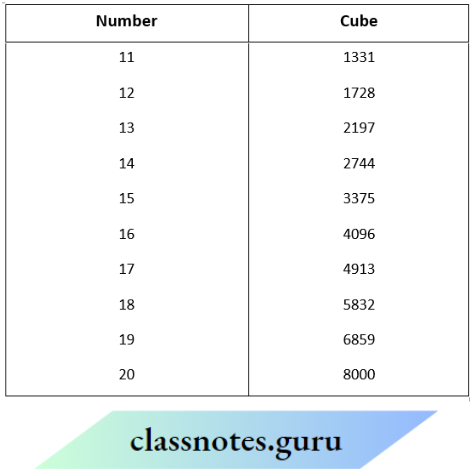
Question 4. Complete the following cubes of numbers From 1 to 10

Solution:
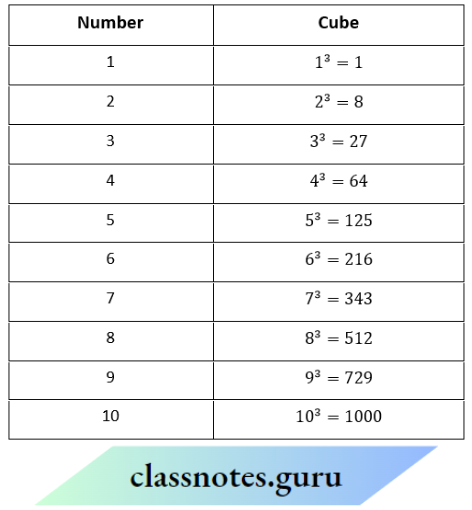
Question 5. Are there only ten perfect cubes from 1 to 1000?
Solution:
Yes :
There are only ten perfect cubes from 1 to 1000.
These are: 1, 8, 27, 64, 126, 216, 343, 512, 729 and 1000
Question 6. How many perfect cubes are there from 1 to 100?
Solution:
There are only four perfect cubes from 1 to 100.
These are: 1, 8, 27, and 64.
Question 7. Observe the cubes of even numbers. Are they all even? What can you say about the cubes of odd numbers?
Solution:
Question 8. Consider a few numbers having 1 as the one’s digit (or unit’s). Find the cube of each of them. What can you say about the one digit of the cube of a number having 1 as the one’s digit? Similarly, explore the one’s digit of cubes of numbers ending in 2, 3, 4,
Solution:
We observe that the one digit of the cube of a number having 1 as the one’s digit is 1. Similarly, the one’s digit of cubes of numbers ending in 0, 2, 3, 4, 5, 6, 7, 8, 9 are 0, 8, 7, 4, 5, 6, 3, 2, 9 respectively
Question 9. Find the one digit ofthe cube ofeach of the following numbers.
Solution:
1. 3331
Unit digit of the number = 1
Unit digit of the cube of the number = 1
∴ 1 × 1 × 1 = \(\underline{1}\)
2. 8888
Unit digit of the number = 8
Unit digit of the cube of the number = 2.
∴ 8 × 8 × 8 = 51\(\underline{2}\)
3. 149
Unit digit of the number = 9
Unit digit of the cube of the number = 9
∴ 9 × 9 × 9 = 72\(\underline{9}\)
4. 1005
Unit digit of the number = 5
Unit digit of the cube of the number = 5.
∴ 5 × 5 × 5 = 12\(\underline{5}\)
5. 1024
Unit digit of the number = 4
Unit digit of the cube of the number = 4
∴ 4 × 4 × 4 × 4 = 6\(\underline{4}\)
4. 77
Unit digit of the number = 7
Unit digit of the cube of the number = 3.
∴ 7 × 7 × 7 = 34\(\underline{3}\)
8. 5022
Unit digit of the number = 2
Unit digit of the cube of the number = 8
∴ 2 × 2 × 2 = \(\underline{8}\)
8. 53
Unit digit of the number = 3
Unit digit of the cube of the number = 7
∴ 3 × 3 × 3 = 2\(\underline{7}\)
If in the prime factorization of any number, each prime factor appears three times, then the number is a perfect cube.
For example, 216 =\(\underline{2 \times 2 \times 2} \times \underline{3 \times 3 \times 3} \times \underline{3 \times 3} \times \underline{5 \times 5}\)
= 2³ × 3³ = (2× 3)³ = 6³ which is a perfect cube.
Question 1. How many consecutive odd numbers will be needed to obtain the sum as 10³?
Solution: Ten.
Question 2. Express the following numbers as the sum of odd numbers using the above pattern.
Solution:
1. 6³
Here, n = 6
∴ (n – 1) = 5
We start with n × (n – 1) + 1
= 6× 5 +1
= 31
6³ = 31 + 33 + 35 + 37+ 39 + 41
2. 8³
Here, n = 8
∴ (n – 1) = 7
We start with n × (n – 1) + 1
= 8 × 7 + 1
= 56+1
= 57
8³ = 57 + 59 + 61 + 63 + 65 + 67 + 69 + 71
3. 7³
Here, n = 7
(n -1) = 6
We start with n × (n – 1) + 1,
7 × 6 + 1,
= 42+1
= 43
7³ = 43 + 45 + 47 + 49 + 51 + 53 + 55
Question 3. Consider the following pattern.
Using the above pattern, find the value of the following:
Sol.
1. 7³ – 6³
= 1 + 7 × 6 ×3
=1+126
= 127
2. 12³ – 11³
= 1 + 12 × 11 × 3
=1 + 396
= 397
3. 20³- 19³
T = 1 + 20 × 19 × 3
= 1 + 1140
= 1141
4. 51³ – 50³
1 + 51 × 50 × 3
= 1 + 7650
= 7651
Question 4. Which of the. following are perfect cubes
1. 400
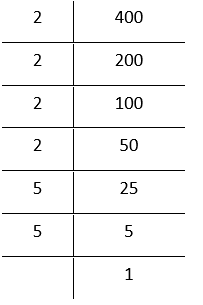
By prime factorisation,
Grouping the factors in triplets
400 = \(\underline{2 \times 2 \times 2} \times\) 2× 5 × 5.
= 2³ × 2× 5× 5
Bylaws of exponents
In the above factorization, 2 and 5 × 5 remain after grouping 2’s in triplets.
∴ 400 is not a perfect cube
2.33375
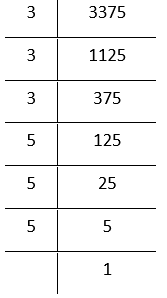
Therefore, 400 is not a perfect cube
By prime factorisation,
3375 = \(\underline{3 \times 3 \times 3} \times \underline{5 \times 5 \times 5}\)
Grouping the factors in triplets
= 3³× 5³
Bylaws of exponents
= (3 × 5)³
= 15³, which is a perfect cube.
∴ 3375 is a perfect cube.
3. 80000
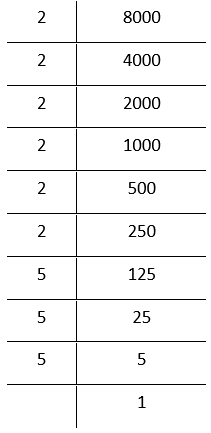
By prime factorisation,
8000 = \(\underline{2 \times 2 \times 2} \times \underline{2 \times 2 \times 2} \times \underline{5 \times 5 \times 5}\)
Grouping the factors in triplets
= 2³× 2³ × 5³
Bylaws of exponents
= (2 × 2 ×5)³
= 20³, which is a perfect cube.
∴ 8000 is a perfect cube
4.15625
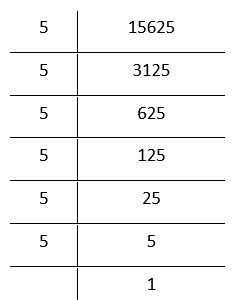
By prime factorisation,
15625 = \(\underline{5 \times 5 \times 5} \times \underline{5 \times 5 \times 5}\)
Grouping the factors in triplets
= 5³× 5³
Bylaws of exponents
= (5 × 5)³
Bylaws of exponents
25³, which is a perfect cube.
∴ 15625 is a perfect cube
5. 9000
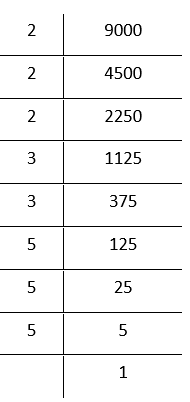
By prime factorisation,
9000 = \(\underline{2 \times 2 \times 2} \times\) 3× 3 × \(\underline{5 \times 5 \times 5}\)
Grouping the factors in triplets
In the above factorization, 3×3 remains after grouping 2’s and 5’s in triplets.
∴ 9000 is not a perfect cube.
6. 6859

By prime factorisation
6859 = \(\underline{19 \times 19 \times 19}\)
Grouping the factors in triplets
= 19³
Bylaws of exponents which is a perfect cube
∴ 6859 is a perfect cube
7. 2025
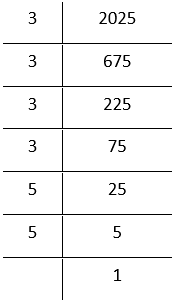
By prime factorisation,
2025 = \(\underline{3 \times 3 \times 3} \times\) 3 × 5 × 5
Grouping the factors in triplets
= 3³ × 3 × 5 × 5
Bylaws of exponents
In the above factorization, 3 and 5 × 5 remain after grouping 3’s in triplets.
∴ 2025 is not a perfect cube
8. 10648
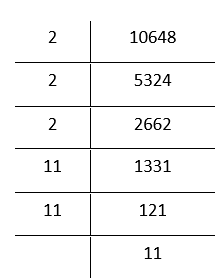
By prime factorisation
10648 = \(\underline{2 \times 2 \times 2} \times \underline{11 \times 11 \times 11} \times \)
Grouping the factors in triplets
= 2³ × 11³
Bylaws of exponents
= (2 × 11)³
Bylaws of exponents
= 22³, which is a perfect cube.
∴ 10648 is a perfect cube
Sometimes we have to find the smallest natural number by which a number is multiplied or divided to make it a perfect cube
Question 1. Check which of the following are perfect cubes
What pattern do you observe in these perfect cubes
Solution:
1. 2700

By prime factorisation,
2700 = 2× 2× \(\underline{3 \times 3 \times 3}\)× 5 × 5
Grouping the factors in triplets
= 2 × 2 × 3³× 5× 5
Bylaws of exponents
In the above factorization, 2 × 2 and
5× 5 remain after grouping 3’s in triplets.
∴ 2700 is not a perfect cube
2. 16000

By prime factorisation,
16000 = \(\underline{2 \times 2 \times 2} \times \underline{2 \times 2 \times 2}\) × 2 × \(\underline{5 \times 5 \times 5}\)
Grouping the factors in triplets
= 2³ × 2³ × 2 × 5³
Bylaws of exponents
In the above factorization, 2 remains after grouping 2’s and 5’s in triplets.
∴ 16000 is not a perfect cube
3. 64000
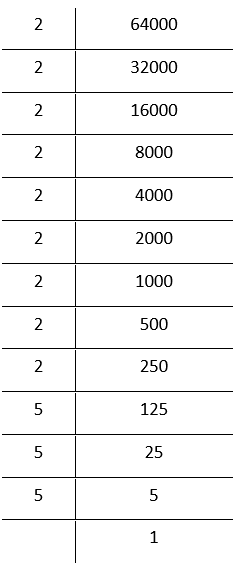
By prime factorisation,
64000 = \(\underline{2 \times 2 \times 2 } \times \underline{2 \times 2 \times 2} \times \underline{2 \times 2 \times 2} \times \underline{5 \times 5 \times 5}\)
Grouping the factors in triplets
= 2³ ×2³ × 2³× 5³
By laws of exponents
= (2 × 2 × 2 ×5)³
= 40³, which is a perfect cube.
∴ 64000 is a perfect cube
4. 900
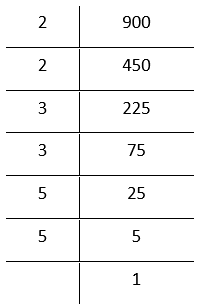
By prime factorisation,
900 = 2 ×2 × 3 × 3 × 5 × 5
In the above factorization, 2 × 2, 3 × 3, and 5 × 5 remain when we try to group the factors in triplets.
∴ 900 is not a perfect cube.
5. 125000
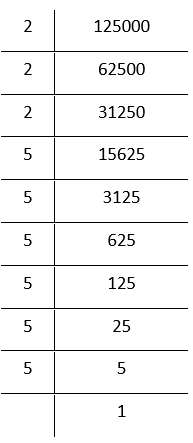
By prime factorisation,
125000 = \(\underline{2 \times 2 \times 2 } \times \underline{5 \times 5 \times 5} \times \underline{5 \times 5 \times 5}\)
Grouping the factors in triplets
= 2³ × 5³ × 5³
Bylaws of exponents
= (2 × 5 × 5)³
= 50³, which is a perfect cube.
∴ 125000 is a perfect cube.
6. 36000
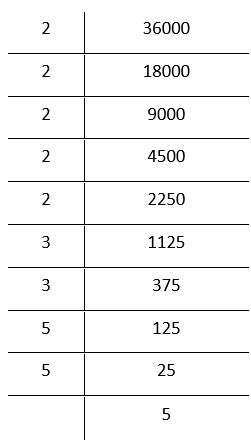
By prime factorisation,
3600 = \(\underline{2 \times 2 \times 2 } \times \underline{2 \times 2 } \times \underline{3 \times 3} \times \underline{5 \times 5 \times 5}\)
Grouping the factors in triplets
= 2³ × 2 × 2 × 3 × 3 × 5³
Bylaws of exponents
In the above factorization, 2 × 2 and 3 ×3 remain after grouping 2’s and 5’s in triplets
∴ 36000 is not a perfect cube.
7. 21600

By prime factorisation
21600 = \(\underline{2 \times 2 \times 2 }\) × 2 × 2 × \(\underline{5 \times 5 \times 5}\)
Grouping the factors in triplets
= 2³ × 2 × 2×3³×5 × 5
Bylaws of exponents
In the above factorization, 2×2 and 5×5 remain after grouping 2’s and 3’s in triplets
∴ 21600 is not a perfect cube.
8. 10000
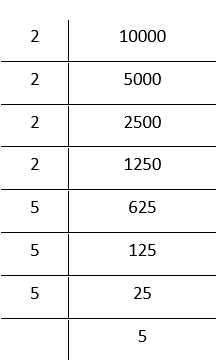
By prime factorisation,
1000 =\(\underline{2 \times 2 \times 2}\) × 2 × \(\underline{5 \times 5 \times 5}\) × 5
Grouping the factors in triplets
= 2³ × 2 × 5³ × 5
Bylaws of exponents
In the above factorization, 2 and 5 remain after grouping 2’s and 5’s in triplets.
∴ 10000 is not a perfect cube
9. 27000000

By prime factorisation,
27000000
=\(\underline{2 \times 2 \times 2} \times \underline{2 \times 2 \times 2} \times \underline{3 \times 3 \times 3} \times \underline{5 \times 5 \times 5}\times \underline{5 \times 5 \times 5}\)
Grouping the factors in triplet
= 2³×2³ × 3³× 5³ × 5³
Bylaws of exponents
= 300³, which is a perfect cube.
∴ 27000000 is a perfect cube.
10. 1000
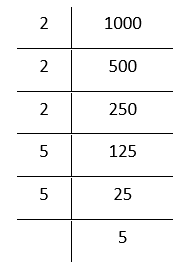
By prime factorization,
1000 = \( \underline{2 \times 2 \times 2} \times \underline{5 \times 5 \times 5}\)
Grouping the factors in triplets
= 2³ × 5³
Bylaws of exponents
= (2 × 5)³ I By laws of exponents
= 10³, which is a perfect cube.
Therefore, 1000 is a perfect cube.
We observe the following pattern in these perfect cubes:
Question 1. Which of the following numbers are not perfect cubes?
Solution:
1. 216
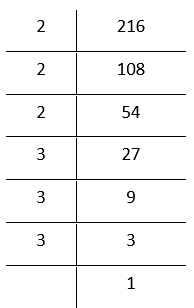
By prime factorisation
216 = \(\underline{2 \times 2 \times 2}\times \underline{3 \times 3 \times 3}\)
Grouping the factors in triplets
= 2³ × 3³
Bylaws of exponents
= (2 × 3)³
= 6³ which is a perfect cube.
∴ 216 is a perfect cube
2. 128
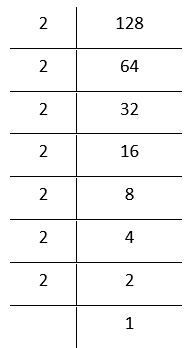
By prime factorisation
128 = \(\underline{2 \times 2 \times 2}\times \underline{2 \times 2 \times 2}\) × 2
Grouping the factors in triplets
= 2³ × 2³ × 2
Bylaws of exponents
In the above factorization,2remainsafter grouping the 2 ‘s in triplets
∴ 128 is not a perfect cube
3. 1000
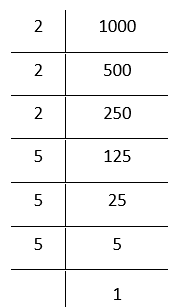
By prime factorisation
= \(\underline{2 \times 2 \times 2}\times \underline{5 \times 5 \times 5}\)
Grouping the factors in triplets
= 2³× 5³
Bylaws of exponents
= (2 × 5)³ = 10³
Bylaws of exponents
Which is a perfect cube.
∴ 1000 is a perfect cube
4. 100

By prime factorisation
100 = \(\underline{2 \times 2 \times }\times \underline{5 \times 5}\)
In (he above factorization, 2 × 2,5 × 5 remains when we try to group the factors in triplets
Therefore, 100 is not a perfect, cube.
5.46656
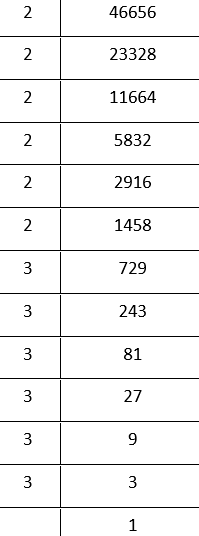
By prime factorisation,
46656 = \(\underline{2 \times 2 \times 2 \times 2 \times 2 \times 2}\) × \(\underline{3 \times 3 \times 3} \times \underline{3 \times 3 \times 3}\).
Grouping the factors in triplets
= 2³ × 2³×3³ × 3³
Bylaws of exponents
= (2 ×2 × 3 × 3)³
Bylaws of exponents
= 36³, which is a perfect cube.
∴ 46656 is a perfect cube
Question 2. Find the smallest number by which each of the following numbers must be multi¬ plied to obtain, a perfect cube
Solution:
1. 243
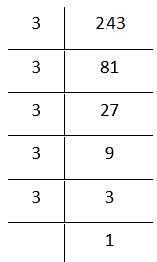
By prime factorisation
243 =\(\underline{3 \times 3 \times 3}\) × 3 × 3
Grouping the factors in triplets
The prime factor 3 does not appear in a group of three.
Therefore, 243 is not a perfect cube. To make it a cube, we need one more 3. In that case
243 = \(\underline{3 \times 3 \times 3} \times \underline{3 \times 3 \times 3}\)
= \(3^3 \times 3^3\)
= (3×3)³
729, which is a perfect cube.
Hence, the smallest number by which 243 should be multiplied to obtain a perfect cube is 3.
The resulting perfect cube is 3.
2. 256

By prime factorisation
256 =\(\underline{2 \times 2 \times 2}\underline{2 \times 2 \times 2}\) 2 x 2
Grouping the factors in triplets
In the above factorisation 2× 2 after grouping 2‘s in Iriplols. Therefore, 128 is not a perfect cube. To make it a perfect, cube, we need one 2 more. In that, case
256× 2 = \(\underline{2 \times 2 \times 2} \times \underline{2 \times 2 \times 2} \times 2 \times 2\)
= 2³×2³× 2³
Bylaws of exponents
= (2×2×2)³
Bylaws of exponents
8³ = 512, which is a perfect cube.
Hence, the smallest number by which 256 must be multiplied to obtain a perfect cube is 2
The resulting perfect cube is 512 (= 8³)
3. 72

By prime factorisation,
72 = 2 × 2 × 2 × 3 × 3
Grouping the factors in triplets
The prime factor 3 does not appear in a group of three.
Therefore, 72 is not a perfect cube. To make it a perfect cube, we need one more 3. In that case,
72 × 3 = \(\underline{2 \times 2 \times 2} \times \underline{3 \times 3 \times 3}\)
= 2³ ×3³
Bylaws of exponent
= (2 × 3)³
Bylaws of exponents
6³ = 216 which is a perfect cube.
Hence, the smallest number by which 72 must be multiplied to obtain a perfect cube is 3.
The resulting perfect cube is 216 (= 6³)
4. 675
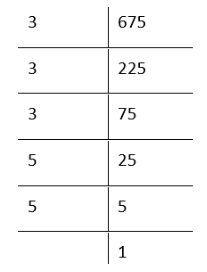
By prime factorisation,
675 = 5 × 3 × 3 × 5 × 5
Grouping the factors in triplets
The prime factor 5 does not appear in a group of three. Therefore, 675 is not a perfect cube.
To make it a perfect cube, we need one more 5. In that case
675 × 5 = \(\underline{3 \times 3 \times 3} \times \underline{5 \times 5 \times 5} \)
= 3³× 5³
Bylaws of exponents
= (3×5)³
By laws of exponents
= 15³
∴ 3375 which is a perfect cube.
Hence, the smallest number by which 675 must be multiplied to obtain a perfect cube is 5.
The resulting perfect cube is 3375 (= 15³)
5. 100
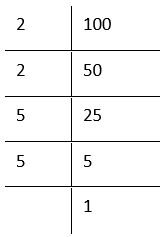
By prime factorisation,
100 = 2 × 2 × 5 × 5
Grouping the factors in triplets
The prime factors 2 and 5 do not appear in a group of three. Therefore, 100 is not a perfect cube.
To make it a perfect cube, we need one 2 and one 5 more. In that case,
100 × 2 × 5 = \(\underline{2 \times 2 \times 2} \times \underline{5 \times 5 \times 5} \)
= 2³ × 5³
Bylaws of exponents 2
= (2 × 5)³
Bylaws of exponents
= 10³
∴ 1000 which is a perfect cube.
Hence, the smallest number by which 100 must be multiplied to obtain a perfect cube is 2× 5 = 10
The resulting perfect is 1000 (= 10³ )
Question 3. Find the smallest number by which each of the following numbers must be divided to obtain a perfect cube.
Solution:
1. 81

By prime factorisation
81 =\(\underline{3 \times 3 \times 3}\times\) 3
Grouping the factors in triplets
In the above factorization, 3 remains after grouping the 3’s in triplets. Therefore,
81 is not a perfect cube. If we divide the number by 3, then in the prime factorization of the quotient, this 3 will not remain. In that case,
81 ÷ 3 = \(\underline{3 \times 3 \times 3}\)
= 3³
By laws of exponents which is a perfect cube
Hence, the smallest whole number by which 81 must be divided to obtain a perfect cube is 3.
The resulting ideal cube is 27 (= 3³)
2. 128

By prime factorisation,
128 = \(\underline{2 \times 2 \times 2} \times \underline{2 \times 2 \times 2}\)
Grouping the factors in triplets
In the above factorization, 2 remains after grouping’ the 2’s in triplets.
Therefore, 128 is not a perfect cube. If we divide the number by 2, then in the prime factorization ofthe quotient, this 2 will not remain. In that case,
128 ÷ 2 = \(\underline{2 \times 2 \times 2} \times \underline{2 \times 2 \times 2}\)
= 2³ × 2³
= (2 × 2)³
Bylaws of exponents
= 4³, which is a perfect cube.
Hence, the smallest whole number by which 128 must be divided to obtain a perfect cube is 2
The resulting ideal cube is 64 (= 4³)
3. 135
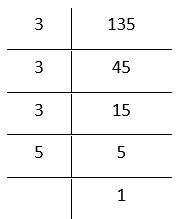
By prime factorisation,
135 = \(\underline{3 \times 3 \times 3} \times 5\)
Grouping the factors in triplets.
The prime factor 5 does not appear in a group of three. So 135 is not a perfect cube
In the factorisation 5 appears only once. If we (u) 704 divide 135 by 5, then the prime factorization of the quotient, will not contain 5.
In that case
135 ÷ 5 = \(\underline{3 \times 3 \times 3}\)
Grouping the factors in triplets
= 27
Bylaws of exponents, which is a perfect cube.
Hence, the smallest whole number by which 135 must be divided to obtain a perfect cube is 5
The resulting perfect cube is 27 (= 33)
4. 192

By prime factorisation,
192 = \(\underline{2 \times 2 \times 2} \times \underline{2 \times 2 \times 2} \) × 3
Grouping the factors in triplets
The prime factor 3 does not appear in a group of three. So 192 is not a perfect cube. In the factorization of 192, 3 appears only once. So if we divide the number by 3, then the prime factorization of the quotient will not contain 3.
.In that case,
192 ÷ 3 = \(\underline{2 \times 2 \times 2} \times \underline{2 \times 2 \times 2} \) × 3
= 2³ × 2³
= (2 × 2)³
Bylaws of exponents
= 4³ = 64
Which is a perfect cube.
Hence, the smallest whole number by which 192 must be divided to obtain a perfect cube is 3.
The resulting perfect cube is 64 (= 4³)
5. 704
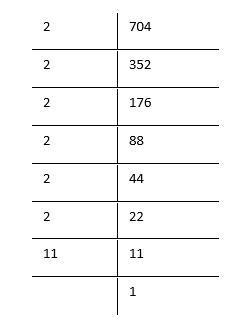
By prime factorisation,
704 = \(\underline{2 \times 2 \times 2} \times \underline{2 \times 2 \times 2} \) × 11
Grouping the factors in triplets
The prime factor 11 does not appear in the group of three.
So, 704 is not a perfect cube.
In the factorization 11 appears only one time.
So if we divide 704 by 11, then the prime factorization of the quotient will not contain 11. In that case
704 ÷ 11 = 2 × 2 × 2 × 2 × 2 × 2
Grouping the factors in triplets
2³ × 2³
Bylaws of exponents
= (2 × 2)³
= 4³
= 64
Which is a perfect cube.
Hence, the smallest whole number by which 704 must be divided to obtain a perfect cube is 11.
The resulting perfect cube is 64 (= 4³).
Question 4. Parikshit makes a cuboid of plasticine of sides 5 cm, 2 How many such cuboids will he need to form a cube? cm, 5 cm.
Solution:
Volume of a cuboid
= 5 × 2 × 5 cm³
Since there is only one 2 and only two 5’s in the prime factorization, so, we need 2 × 2 × 5, i.e.t 20 to make a perfect cube.
Therefore, we need 20 such cuboids to make a cube.
The cube root is the inverse operation of finding a cube.
2³ = 8 ⇒ 2 is the cube root of 8.
The symbol denotes the cube root. Thus,\(\sqrt[3]{8}=2\)
Cube Root Through Prime Factorisation Method
We express the given number into product of its prime factors and make triplets (groups of three) of similar factors. Then, we take one factor from each triplet and multiply. The product so obtained gives the cube root of the given number.
Question 1. State true or false: for any integer m, m²< m³. Why?
Solution:
False, if m is a negative integer.
True, if m is a positive integer (natural number).
Verification. Let us take a negative integer m =-1. Then,
m²= (- 1)2 = (- 1)² × (-1) = 1
m³ = (_ 1)3 = (- 1)³ × (-1) × (-1)
= – 1
Clearly, m² > m³
Hence, the given statement is false if m is a negative integer.
We get the same inference for m = – 2, -3,-4, etc.
Again, let us take a positive integer(natural number) m = 2. Then,
m² = (2)² = 2 × 2 = 4
m³ = (2)³ = 2 × 2 × 2 = 8
Clearly, m² < m³
Hence, the given statement is true if m is a positive integer (natural number).
We get the same inference for m = 3, 4,5… etc
Cube Root of a Cube Number Steps
Question 1. Find the cubit root of each of the foUouiu# numbers by prime factorization method :
Solution:
1. 64
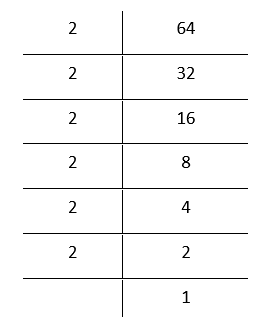
The prime factorization of 64 is
= \(\underline{2 \times 2 \times 2} \times \underline {2\times 2 \times 2}\)
Grouping the factors in triplets
= 2³× 2³
= (2 × 2)³
= 4³
Bylaws of exponents
∴ \(\sqrt[3]{64}\) = 2 × 2
2.512
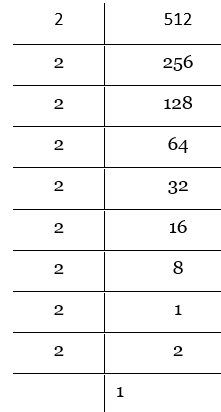
The prime factorisation of 512 is
⇒ \(\underline{2 \times 2 \times 2} \times \underline{2 \times 2 \times 2} \times \underline{2 \times 2 \times 2}\)
Grouping the factors in triplets
= 2³× 2³ × 2³
= (2 × 2 ×2)³
= 8³
Bylaws of exponents
∴ \(\sqrt[3]{512}\) = 2 × 2 ×2
= 8³
3. 10648
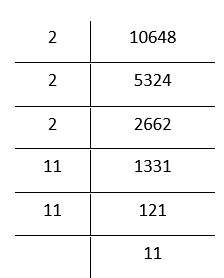
Prime factorization of 10648 is
⇒ \(\underline{2 \times 2 \times 2} \times \underline{11 \times 11 \times 11} \)
Grouping the factors in triplets
= 2³ x 11³
= (2 × 11)³
∴ \(\sqrt[3]{10648}\) = 2 × 11
= 22³
4. 27000

Prime factorisation of 27000 is
⇒ \(\underline{2 \times 2 \times 2} \times \underline{3 \times 3 \times 3 } \times \underline{5 \times 5 \times 5 } \times \underline{5 \times 5}\)
Grouping the factors in triplets
= 2³ × 3³ × 5³
= (2 × 3 × 5)³
Bylaws of exponents
= 30³
∴ \(\sqrt[3]{27000}\) = 2×3 × 5
= 30
5. 15625

The prime factorization of 15625 is
⇒ \(\underline{5 \times 5 \times 5} \times \underline{5 \times 5 \times 5 }\)
Grouping the factors in triplets
= 5³ × 5³
= (5 × 5)³
Bylaws of exponents
= 25³
∴ \(\sqrt[3]{15625}\) = 5 × 5
= 25
6. 13824

Prime factorization of 13824 is
⇒ \(\underline{2 \times 2 \times 2}\times \underline{2 \times 2 \times 2} \times \underline{2 \times 2 \times 2} \times \underline{3 \times 3 \times 3}\)
Grouping the factors in triplets
= 2³ × 2³× 2³ × 3³
=(2× 2 × 2 × 3)³
Bylaws of exponents
= 24³
∴ \(\sqrt[3]{13824}\) = 2× 2 × 2 × 3
= 24
7. 1110592

Prime factorisation of 110592 is
⇒ \(\underline{2 \times 2 \times 2}\)× \(\underline{2 \times 2 \times 2}\) × \(\underline{2 \times 2 \times 2}\) × \(\underline{2 \times 2 \times 2}\) × \(\underline{3 \times 3 \times 3}\)
Grouping the factors into triplets
= 2³ × 2³ × 2³ × 2³ × 3
= (2 × 2 × 2 × 2 ×3)³
Bylaws of exponents
= 48³
∴ \(\sqrt[3]{110592}\) =2 × 2 × 2 × 2 ×3
8. 46656
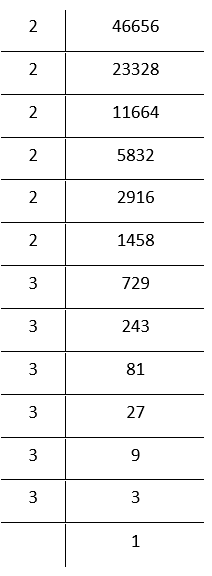
Prime factorization of 46656 is
⇒ \(\underline{2 \times 2 \times 2} \times \underline{2 \times 2 \times 2} \times \underline{3 \times 3 \times 3} \times \underline{3 \times 3 \times 3}\)
Grouping the factors in triplets
= 2³× 2³ × 3³ × 3³
= (2 × 2 × 3 × 3)³
Bylaws of exponents
= 36³
∴ \(\sqrt[3]{46656}\) = 2 × 2 × 3 × 3
=36
9. 175616
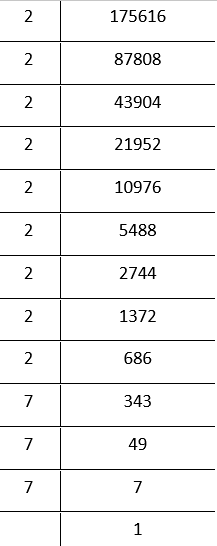
Prime factorisation of 175616 is
⇒ \(\underline{2 \times 2 \times 2 \times} \times \underline{2 \times 2 \times 2 \times} \times \underline{2 \times 2 \times 2 \times} \times \underline{7 \times 7 \times 7}\)
Grouping the factors in triplets
= 2³ × 2³ × 2³ × 7³
= (2 × 2 × 2 × 7)³
Bylaws of exponents
= 56³
∴ \(\sqrt[3]{175616}\) = 2 × 2 × 2 × 7
= 56
10. 91125

Prime factorization of 91125 is
⇒ \(\underline{3 \times 3 \times 3 \times} \times \underline{3 \times 3 \times 3 \times} \times \underline{5 \times 5 \times 5}\)
Grouping the factors in triplets
= 3³ ×3³ × 5³
= (3 × 3× 5)³
Bylaws of exponents
= 45³
∴ \(\sqrt[3]{91125}\) =3 × 3× 5
= 45
Question 1. Which of the following numbers is a perfect cube?
Solution: 1. 125
125 = 5 × 5 × 5 = 5³
Question 2. Which of the following numbers is a cube number?
Solution: 1.1000
1000 = 10 × 10 × 10 = 10³
Question 3. Which of the following numbers is not a perfect cube?
Solution: 4. 100
100 = 2 ×2 × 5 ×5
= 2² × 5².
Question 4. Which of the following numbers is not a cube number?
Solution: 1. 10000
10000 = 2 × 2 ×2 × 2 ×5 ×5× 5 ×5
= 24 × 54
= 23× 2 × 53 × 5
Question 5. The cube of an odd natural number is
Solution: 2. Odd
3 × 3 × 3 = 27 (odd)
Question 6. The cube of an even natural number is
6 × 6 × 6 = 216 (even)
Question 7. The one digit of the cube of the number 111 is
Solution: 1. 1
1 × 1 × 1 = 1
Question 8. The one digit of the cube of the number 242 is
Solution: 4. 8
2 × 2 × 2= 8.
Question 9. The one digit of the cube of the number 123 is
Solution: 4. 7
3 × 3 × 3 =2\(\underline{7}\)
Question 10. The one’s digit of the cube of the number 144 is
Solution: 4. 4
4 × 4 ×4 = 6\(\underline{4}\)
Question 11. The one’s digit of the cube of the number 50 is
Solution: 2. 0
0 × 0 × 0 = 0
Question 12. The one digit of the cube of the number 326 is
Solution: 3. 3
6 × 6 × 6 = 21\(\underline{6}\)
Question 13. The one digit of the cube of the number 325 is
Solution: 2. 5
5× 5× 5= 12\(\underline{5}\)
Question 14. The one digit of the cube of the number 347 is
Solution: 1. 3
7×7×7 = 34\(\underline{3}\)
Question 15. The one digit of the cube of the number 68 is
Solution: 2. 2
8× 8 ×8 = 51\(\underline{2}\)
Question 16. The one digit of the cube of the number 249 is
Solution: 3. 9
9 × 9 × 9 = 72\(\underline{9}\)
Question 17. What is the one’s digit in the cube root of the cube number 1331?
Solution: 1. 1
1 × 1 × 1 = 1
Question 18. What is the one digit in the cube root of the cube number 1000000?
Solution: 1. 0
0 ×0 × 0 = 0
Question 19. What is the one’s digit in the cube root of the cube number 1728?
Solution: 2. 2
2 × 2 × 2 = \(\underline{8}\)
Question 20. What is the one’s digit in the cube root, of the cube number 2197′?
Solution: 3. 3
3× 3 × 3 = 2\(\underline{7}\)
Question 21. What is t lie one’s digit, in the cube root, of the cube number 2744?
Solution: 4. 4
4 × 4 × 4 = 6\(\underline{4}\)
Question 22. What is the one’s digit in the cube root of the cube number 3375?
Solution: 3. 5
5 × 5 × 5 = 12\(\underline{5}\)
Question 23. What is the one’s digit in the cube root of the cube number 4096?
Solution: 2. 6
6 × 6 × 6 = 21\(\underline{6}\).
Question 24. What is the one’s digit in the cube root of the cube number 4913?
Solution: 1. 7
7 × 7 ×7 = 34\(\underline{3}\)
Question 25. What is the one’s digit in the cube root of the cube number 5832?
Solution: 4. 8
8 × 8 × 8 = 51\(\underline{2}\)
Question 26. What is the one’s digit in the cube root of the cube number 6859?
Solution: 3. 9
8 × 8 × 8 = 51\(\underline{2}\)
Question 27. What, is the one’s digit in the cube root of the cube number 8000 ?
Solution: 1. 0
0 × 0 × 0 = 0.
Question 28. The number of zeroes at the end of the cube of the number 20 is
Solution: 3. 3
Number of zeroes at the end of the number 20 = 1
Number of zeroes at the end of its cube = 3 × 1 = 3
Question 29. The number of zeroes at the end of the cube root of the cube number 1000 is
Solution: 1. 1
The number of zeroes at the end of the cube = 3
Number of zeroes at the end of the cube root = \(\frac{3}{3}\)
= 1
Question 30. The number of zeroes at the end of the cube of the number 100 is
Solution: 4. 6
Number of zeroes at the end of the number 100 = 2
Number of zeroes at the end of its cube = 3 × 2
= 6
Question 31. The number of zeroes at the end of the cube root Of the cube number 8000000 in
Solution: 2. 2
The number of zeroes at the end of the cube = 6
Number of zeroes at the end of the cube root =\(\frac{6}{3}\)
= 2
Question 32. Find the smallest number by which the number 108 must be multiplied to obtain a perfect, cube. ,
Solution: 1. 2
108 = 2 × 2 × 3 × 3 × 3
= 2 × 2 × 3³
Question 33. Find the smallest number by which the number 250 must be divided to obtain a perfect cube.
Solution: 1. 3
250 = 5 ×5 × 5 × 2 = 5³ × 2
Question 34. Find the smallest number by which the number 72 must be multiplied to obtain a perfect cube.
Solution: 2. 3
72 = 2 × 2 × 2 × 3 × 3
= 2³ × 3 × 3
Question 35. Find the smallest number by which the number 375 must be divided to obtain a perfect cube.
Solution: 2. 3
375 = 3 × 5 × 5 × 5
= 3× 53.
Question 36. Find the smallest number by which the number 100 must be multiplied to obtain a perfect cube.
Solution: 4. 10
100 = 2 × 2 ×5 × 5.
Question 37. Find the smallest number by which the number 10000 must be divided to obtain a perfect cube.
Solution: 3. 10
10000 = 2 × 2 × 2 × 2 ×5×5 × 5 × 5
= 2³ × 2 × 5³× 5
Question 38. Find the smallest number by which the number 200 must be multiplied to obtain a perfect cube.
Solution: 3. 5
200 =2 × 2 × 2 × 5 × 5
= 2³ ×5 × 5
Question 39. Find the smallest number by which the number 625 must be divided to obtain a perfect cube.
Solution: 2. 5
625 = 5 × 5 × 5 ×5
= 5³ × 5.
Question 40. Kind the smallest number by which (bo number 128 must the multiplied to obtain a perfect cube.
Solution: 2. 4
128 =2 × 2 × 2 × 2 × 2 × 2 × 2
= 2³ ×2³ × 2
Question 41. Find the smallest number bv which the number 250 must be divided to obtain a perfect cube.
Solution: 2. 4
256 = 2 × 2× 2× 2 × 2× 2 × 2×2
= 2³ × 2³ × 2 × 2.
Question 42. Find the smallest number by which the number 30 must be multiplied to obtain a perfect cube.
Solution: 1. 6
36 = 2 × 2 × 3 × 3
Question 43. Find the smallest number by which the number 1290 must be divided to obtain a perfect cube.
Solution: 1. 6
1296 = 2 × 2× 2 × 2 × 3 × 3
= 2³× 2 ×3³× 3
Question 44. Find the smallest number by which the number 392 must be multiplied to obtain a perfect cube.
Solution: 3. 7
392 = 2 × 2 × 2 × 7× 7
Question 45. Find the smallest number by which the number 2401 must be divided to obtain a perfect cube.
Solution: 1. 1
2401 = 7 × 7 × 7 × 7
= 7³ × 7
Question 46. Find the smallest number by which the number 121 must be multiplied to obtain a perfect cube.
Solution: 3.11
121 = 11× 11
Question 47. Find the smallest number by which the number 88 must be divided to obtain a perfect cube.
Solution: 1.11
88 = 2 × 2 ×2 × 11
= 2³ ×11
Question 48. The volume of a cube is 64 cm3. The edge of the cube is
Solution: 1. 4 cm
Edge = \(\sqrt[3]{64}=\sqrt[3]{2 \times 2 \times 2 \times 2 \times 2 \times 2}\)
= \(\sqrt[3]{2^3 \times 2^3}\)
= 2 × 2
= 4.
Question 49. Apala makes a cuboid of plasticine with sides 5 cm, 4 cm, 2 cm. How many such cuboids will be needed to form a cube?
Solution: 2. 25
Volume = 5 × 4 × 2
= 5 × 2× 2 × 2
= 5 ×2³
Question 50. Which of the following is false?
Solution: 4. There is no perfect cube that ends with 8.
1728 = 12 × 12 × 12
= 12³
There are four perfect cubes between 1 and 100 – False
2. Ifa2 ends in 9, then a3 ends in 9 – False
3. Ifa2 ends in 5, then a3 ends in 25 – False
4. 999 is not a perfect cube – True
5. Cube roots of 1 are + 1 and -1 – False
6. Cube of any odd number is even – False
7. A perfect cube does not end with two zeros – True
8. If the square of a number ends with 5, then its cube ends with 25. – False
⇒ 15² = 225, 15³= 3375
9. There is no perfect cube that ends – False
⇒ 12³ = 1728
10. The cube of a two-digit number may be a three-digit number – False
⇒ 10³ = 1000, 99³= 970299
11. The cube of a two-digit number may have seven or more digits -False
⇒ 10³ = 1000, 99³ = 970299
12. The cube of a single-digit number may be a single-digit number – True
⇒ 1³ = 1; 2³ = 8
1. \(\sqrt[3]{x}\)represents the Cube root of the number x
2. 1 cm³ 10³ mm³
3. The cube of a number ending in 9 will end in the digit → 9
4. The cube of 100 will have zeros 6 at the end
5. There are 8 perfect cubes between 1 and 1000.
6. Find the value of \(\sqrt[3]{125} \times \sqrt[3]{-64}\) → 20
7. Find the least number by which 72 should be multiplied to make it a perfect cube → 3
8. Find the least number by which 72 should be divided to make it a perfect cube → 9
9. Find(1.1)³→ 1.331
10. Find the number whose cube is 64000 → 40
1. We usually compare two quantities by division, i.e., by using fractions. Comparison by division is called ratio.
Note that two quantities can be compared only when they have the same units. A ratio has no unit.
However, if the two quantities are not in the same units, we convert them into the same units before comparing.
2. Two quantities can also be compared using percentages. By percentage, we mean a fraction where the denominator is 100. The numerator of the fraction is called the rate percent.
For example: \(\frac{1}{5}\) means 5%. The symbol % is often used to express ‘percent’ (p. c.).
3. To convert the ratio into a percentage, we convert it into a fraction whose denominator is 100. [or we multiply by 100 and employ the % sign.]
4. To convert percentages in \(\frac{5}{100}\) to fractions, we divide the numerator by 100 and express it in the lowest form.
For example : 5% =\(\frac{1}{20}\)
Read and Learn More NCERT Solutions For Class 8 Maths
.
5. In the unitary method, we find the value of one unit from the given value of some units and then we find the value of the required number of units.
Question 1. In primary school, the parents were asked about the number of hours they spend per day helping their children to do homework. 90 parents helped for hour to \(\frac{1}{2}\) hours to 1 \(\frac{1}{2}\) . The distribution of parents according to the time for which, they said they helped is given in the adjoining figure; 20% helped for more than 1\(\frac{1}{2}\) ho per day; 30% helped for \(\frac{1}{2}\) an hour to 1 \(\frac{1}{2}\) hours, 50% did not help at all.
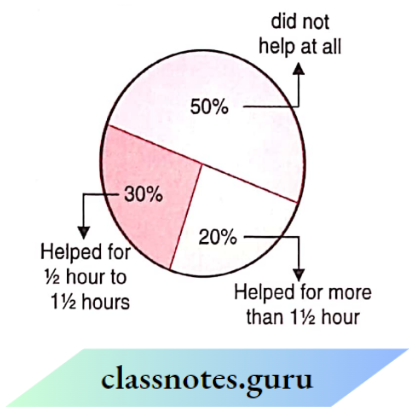
Using this, answer the following:
Solution:
1. According to the question
⇒ \(\frac{30}{100}\) of number of parents surveyed = 90
Number of parents surveyed = 90
Number of parents surveyed
= \(\frac{90 \times 100}{30}\)
= 300
Hence, 300 parents were surveyed.
2. A number of those parents said that they did not help
= 50% of 300
= \(300 \times \frac{50}{100}\)
= 150
Hence, 150 parents said that they did 30% not help.
3. A number of those parents said that they helped for more than 1\(\frac{1}{2}\) hour
= 20% of 300 = \(300 \times \frac{20}{100}\)
= 60
Hence, 60 parents said that they helped for more than 1/[latxe]\frac{1}{2}[/latex] hours
Note: ‘Of’ means multiplication
Question 1. Find the ratio of the following:
Solution:
1. The speed ofa a cycle 15 km per hour to the speed of a scooter 30 km per hour
= 15 km per hour: 30 km per hour
= 15: 30
= \(\frac{15}{30}=\frac{1}{2}\) Or 1:2
2. 5 m to 10 km
10 km = 10 × 1000 m = 10000 m
∴Ratio of 5 m to 10 km
= 5 m: 10000 m
= 5: 10000
⇒ \(\frac{5}{10000}=\frac{1}{2000}\)
= 1:20000
3. 50 paise to ₹ 5
₹ 5 = 5× 100 = 500 paise
A Ratio of 50 paise to ₹ 5
= 50 paise : 500 paise
= 50: 500
= \(\frac{50}{500}=\frac{1}{10}\) Or 1:10
Question 2. Convert the following ratios to percentages
Solution:
1. 3: 4
= \(\frac{3}{4}=\frac{3}{4} \times \frac{25}{25}\)
Making denominator 100
= \(\frac{75}{100}=75 \%\)
Aliter:
⇒ \(3: 4=\frac{3}{4} \times 100 \%\)
= 75 %
2. 2:3
= \(\frac{2}{3}=\frac{2}{3} \times \frac{100}{100}\)
= \(66 \frac{2}{3} \%\)
Aliter:
2: 3 = \(\frac{2}{3} \times 100 \%\)
= \(\frac{200}{3} \%=66 \frac{2}{3} \%\)
Question 3. 72% of 25 students are interested in mathematics. How many are not interested in mathematics?
Solution:
Total number of students = 25
Percentage of students interested in Mathematics s = 72%
Percentage of students who are not interested in Mathematics
= (100 – 72)% = 28%
Number of those students who are not interested in Mathematics
= 28% of 25
= \(\frac{28}{100} \times 25\)
= 7
Hence, 7 students are not interested in or 1: 10 Mathematics.
Question 4. A football team won 10 matches out ofthe total number of matches they played. Iftheir win percentage was 40, then how many matches did they play in all?
Solution:
If 40 matches were won, then the total number of matches played = 100
∴ If 1 match was won, then the total number of matches played
=\(\frac{100}{40}\)
If 10 matches were won, then the total number of matches played
= \(\frac{100}{40} \times 10\)
= 25
Hence, they played 25 matches in all.
Aliter:
According to the question,
40% of (total number of matches) = 10
⇒ \(\frac{40}{100} \times \text { (total number of matches) }\)=10
Total number of matches = \(\frac{10 \times 100}{40}\) = 25
Hence, they played 25 matches in all.
Question 5. If Chameli had ₹ 600 left after spending 75% of her money, how much did she have in the beginning ?’
Solution:
Percentage of money spent = 75%
Percentage of money left = (100- 75)% = 25%
∴ If Chameli had ₹ 25 left, then the money she had in the beginning
= 100
∴ If Chameli had ₹1 left, then the money she had in the beginning
= \(₹ \frac{100}{25}\)
∴ If Chameli has v600 left, then the money she had in the beginning
= \(₹ \frac{100}{25} \times 600\)
= ₹ 24000
Hence, the money she had in the beginning was ₹ 2400.
Aliter :
According to this question,
25% of total money = ₹ 600
⇒ \(\frac{25}{100}\) of total money = ₹ 600
⇒ \(₹ \frac{600 \times 100}{25}\)
= ₹ 2400.
Hence, the money she had in the beginning was? 2400
Question 6. If 60% of people in a city like cricket, 30% like football and, the remaining like other games, then what percent of the people like other games? If the total number of people is 50 lakh, find the exact number who like each type of game.
Solution:
Percentage of people who like cricket = 60%
Percentage of people who like football = 30%
∴Percentage of people who like other games
= [100 -(60 +30)]%
= (100-90)% = 10%.
Total number of people = 50 lakh
= 50,00,000
∴ Number of people who like cricket
= 60% of 50,00,000
= \(50,00,000 \times \frac{60}{100}\)
= 30,00,000 = 30 lakh
Number of people who like football
= 30% of 50,00,000
= \(50,00,000 \times \frac{30}{100}\)
Number of people who like the other games
= 10% of 50,00,000
= \(50,00,000 \times \frac{10}{100}\)
= 5,00,000 = 5 lakh
Discount = Marked Price – Sale Price
Discount per cent = \(\frac{\text { Discount }}{\text { Marked Price }} \times 100 \%\)
Question 1. 4 shop gives 20% discount. What Would the sale price ofeach of these be?
Solution:
1. A dress marked at ₹120
Marked price ofthe dress = ₹120
Discount rate= 20%
,
∴ Discount = 20% of ₹ 120
20 MarkedDiscountprice × 100
=\(₹ \frac{20}{100} \times 120\)
= ₹ 24
∴ Sale price ofthe dress x 100 % = 4%.
= Marked price – Discount
= ₹ 120 – ₹ 24 = ₹ 96
2. A pair of shoes marked at ₹ 750
Marked price ofthe pair ofshoes= ₹ 750
Discount rate = 20%
Discounts 20% of ₹ 750
= \(₹ \frac{20}{100} \times 750\)
= ₹150
∴ Sale price ofthe pair of shoes
= Marked price – Discount
= ₹ 750 -₹ 150
= ₹600
3. A bag marked at ₹ 250
The marked price of the bag =₹ 250
Discount rate = 20%
Discount = 20% of ₹ 250
= \(₹ \frac{20}{100} \times 250\)
= ₹50
∴ The sale price of the bag
= Marked price – Discount
=₹250 – ₹ 50 =₹200.
Question 2. If the table marked at f 15,000 is * available for f14, 400. Find the discount given £ and the discount percent.
Solution:
Marked price ofthe table =₹ 15,000
Sale price ofthe table = ₹ 14,400
∴ Discount given
= Marked price – Sale price
= ₹ 15,000 – ₹14,400
= ₹ 600
∴ Discount per cent
= \(\left(\frac{\text { Discount }}{\text { Marked price }} \times 100\right) \% \)
= \(\left(\frac{600}{15000} \times 100\right) \%=4 \%\)
Question 3. An almirah is sold at ₹5,225 after allowing a discount of 5%. Find its marked price.
Solution:
Let the marked price bet x.
Discount rate = 5%
Discount = 5% of ₹ x
=\(₹ \frac{5}{100} \times x=₹ \frac{x}{20}\)
∴ Sale price
= Marked price -Discount
= \(₹ x-₹ \frac{x}{20}=₹ \frac{19 x}{20}\)
According to the question,
∴ \(\frac{19 x}{20}=5225\)
x = \(\frac{5225 \times 20}{19}\)
x = ₹ 5500
Hence, the marked price of the almirah is ₹5500
Question 4. Try estimating 20% of the same bill amount.
Solution:
Your bill in a shop is ₹ 577.80.
1. Round off the bill to the nearest tens of ₹ 577.80, i.e., to ₹ 580.
2. Find 20% of this,
⇒ \(₹ \frac{20}{100} \times 580\)
= ₹ 116
3. Therefore estimated 20% of the same bill amount is ₹116 or ₹120 (rounded off to the nearest tens).
Question 5. Try finding 15% of ₹ 375.
Solution:
Find 10% of ₹ 375, i.e.
⇒ ₹\(₹ \frac{10}{100} \times 375\)
= ₹ 37.5
= ₹ 40
(rounded off to the nearest tens)
2. Take half of this, i.e \(\frac{1}{2} \times ₹ 40\)
= ₹ 20
(3) Add (2) and (1) to get ₹ 60.
Therefore, an estimated 15% of 7 375 is
= 60
Sales tax was charged at a specified rate on the sale price of an item by the state government and was added to the bill amount. It is different for different items and also for different states.
Question 1. Find the buying price of each of the following when 5%STis added to the purchase
Solution:
1. Cost of the towel
Rate of ST = 5%
∴ ST =5% of 7 50
=₹ \(\frac{5}{100} \times 50\)
= ₹ 2.50
∴ Buying price of the towel
= Cost of the towel + ST
= ₹ 50 + ₹ 2.50 =₹ 52.50.
2. The cost of two bars of soap
= ₹35 × 2 = ₹ 70
Rate of ST= 5%
ST = 5% of ₹ 70
= \(₹ \frac{5}{100} \times 70\)
= ₹ 3.50
∴ Buying price of two bars of soap
= Cost of two bars of soap + ST
= ₹ 70 +₹ 3.50 = ₹ 73.50
3. Cost of 5 kg of flour
= ₹ 15 × 5 = ₹ 75
Rate of ST = 5%
ST = 5% of ₹ 75
= \(₹ \frac{5}{100} \times 75\)
= ₹ 3.75
∴ The buying price of 5 kg of flour + ST
= Cost of 5 kg of flour + ST
= ₹ 75 +₹ 3.75
=₹ 78.75.
Question 2. If 8% is included in the prices, find the original price of
Solution:
1. When the price of a TV including
VAT is ₹108,
original price = ₹ 100
When the price of the TV including VAT is
₹ 1, original price = ₹ \( \frac{100}{108}\)
The price of a TV including VAT is ₹ 13500,
Original price = \(₹ \frac{100}{108} .\)
= ₹ 12500
Hence, the original price of the TV Is ₹ 12500.
Aliter:
Price of TV including VAT
= ₹ 13500
Rate of VAT = 8%
Let, the original price of the TV be ₹x
Then,
x+8 % of x =₹ 13500
⇒ \(x+\frac{8}{100} x =₹ 13500 \)
⇒ 1+ \(\frac{8}{100}\)x =₹ 13500
⇒ \(\frac{108}{100} x =₹ 13500\)
= ₹ \(\frac{13500 \times 100}{108}\)
Hence, the original price of the T.V. is ₹12500.
2. When the price of a shampoo bottle including VAT is ₹ 108,
Original price = ₹ 100
When the price of a shampoo bottle including VAT is ₹1, the original price
= \(₹ \frac{100}{108} .\)
∴ The price of a shampoo bottle including VAT is? 180,
Original price = \(=₹ \frac{100}{108} \times 180 \)
⇒ \(₹ \frac{100 \times 5}{3}=₹ \frac{500}{3}\)
=\(₹ 166 \frac{2}{3}\)
Hence, the original price ofthe shampoo Hence, the original price ofthe shampoo bottle is \(166 \frac{2}{3}\)
Alitor: Price of shampoo bot t lo including
VAT = ₹ 180
Rate of VAT = 8%
Let the original price of shampoo bottle be ₹x
Then,
x+ 8%of x = ₹180
⇒ \(x+\frac{8}{100} x=₹ 180\)
⇒ \(\left(1+\frac{8}{100}\right) x=₹ 180\)
⇒ \(\frac{108}{100} x=₹ 180\)
x =\(₹ \frac{180 \times 100}{108}\)
x = \(₹ \frac{500}{3}=₹ 166 \frac{2}{3}\)
Hence, the original price ofthe shampoo bottle is \(166 \frac{2}{3}\)
Question 1. During a sale, a shop offered a discount of 10% on the marked prices of all the items. W7iat would a customer have to pay for a pair of jeans marked at ₹ 1450 and two shirts marked at f850 each
Solution:
For a pair of jeans
Marked price = ₹ 1450
Discount rate = 10%
Discount = 10% of marked price
= 10% of ₹ 1450
= \(₹ \frac{10}{100} \times 1450\)
= ₹ 145
Sale price – Marked price – Discount
= ₹1450-₹ 145
= ₹ 1305
For two shirts
Marked price =₹ 850 × 2 = ₹ 1700
Discount rate = 10%
Discount = 10% of marked price
= 10% of ₹ 1700
=₹ \(\frac{10}{100} \times 1700=₹ 170\)
Sale price
= Marked price – Discount
= ₹1700 – ₹70 =₹1530
Total payment made by the customer
= ₹ 1305 + ₹ 1530 =₹ 2835
Hence, the customer will have to pay. 2835 for a pair of jeans and two shirts.
Question 2. The price ofa W is f13,000. The sales tax charged on it is at the rate of 12%. Find the amount that Vinod will have to pay if he buys it
Solution:
Price of TV = ₹ 13,000
Sales tax charged on it
= 12% of ₹ 13,000
= \(₹ \frac{12}{100} \times 13,000\)
= ₹ 1560
Amount to be paid
= Price + Sales Tax
= ₹ 13,000 + ₹ 1,560
= ₹14,560.
Hence, the amount that Vinod will haveto pay for the TV if he buys it is ₹14,560
Question 3. Arun bought a pair of skates at a sale where the discount given was 20%. If the amount he pays is ₹ 1600, find the marked price
Solution:
Let the marked price of the pair of 6 shoes be ₹ 100.
Kate of discount = 20
Discount = 20% of ₹ 100
= ₹ \(\frac{12}{100} \times 100\)
=₹ 20
Amount paid = Marked price -Discount
= ₹ 100 – ₹20 – = ₹ 80
If the amount paid is ₹80,
Then the marked price – \(₹ \frac{100}{80}\)
If the amount paid is ₹ 1, then the marked price = \(₹ \frac{100}{80} \times 1600\)
= ₹ 2000
Hence, the marked price of the pair of shoes is ₹ 2000.
Question 4. I purchased a hair dryer for f 5,400 including 8% VAT. Find the price before it was added,
Solution:
Price of hair-dryer including VAT
= ₹ 5400
VAT rate = 8%
Let the original price be ₹ 100
∴ VAT = ₹ 8
Price including VAT = Original price + VAT
= ₹100 + ₹ 8
= ₹ 108
If the price including VAT is ₹108, then
Original price = ₹ 100
If the price including VAT is ₹ 1, then
Orginalprice = \(₹ \frac{100}{108}\)
If the price including VAT is ₹5,400, then
Original price = ₹ \(\frac{100}{108} \times 5,400\)
= ₹ 5000
Hence, ‘the price before VAT was added is ₹5,000
Question 5. An article was purchased for ₹1239 including a GST of 18%. Find the price of the article before GST was added,
Solution:
Let the original price of the article be 100. GST Rate = 18% ,
Price after GST is included
= ₹(100 + 18) = ₹118
If the selling price is? 118 then original price = ₹100
If the selling price is ₹ 1, then
Original Price = \(₹ \frac{100}{108} \times 5,400\)
If the selling price is ₹ 1239, then
original price = \(₹ \frac{100}{118} \times 1239\)
= 100 × 10.5
= ₹ 1050
Hence, the price ofthe article before GST was added is? 1050
1. Interest:
Interest is the extra money paid by institutions like banks or post offices on money that is deposited (kept) with them. Interest is also paid by people when they borrow money. The money deposited or borrowed is called the principal. Interest is generally given in percent for one year.
2. Simple interest (SI):
The interest is called simple when the principal does not change.
3. The formula for simple interest:
Simple interest on a principal of 1 P at R% rate of interest per year for T years is given by
Simple Interest = \(\frac{\text { Principal } \times \text { Rate } \times \text { Time }}{100}\)
SI = \(\frac{\text { P R T }}{100}\)
4. Amount :
Amount (A)= Principal (P) + Simple Interest(SI)
Question 1. Find interest and amount to be paid on 115,000 at 5% per annum after 2 years
Solution:
Interest on₹ 100 for 1 year is = 5
Interest on ₹ for 1 year is
= \(₹ \frac{5}{100}\)
Interest On ₹ for 1 year is
= \(₹ \frac{5}{100} \times 15,000\)
Interest on ₹ 15000 for 2 years is
= \(₹ \frac{5 \times 15,000 \times 2}{100}\)
= ₹ 1,500
∴ Amount = Principal + Interest
= ₹ 15,000 + ₹ 1,500
= ₹ 16,500
Aliter:
Here, P = ₹ 15,000
R = 5% per annum
T = 2 years
∴ \(\text { S.I. }=\frac{\text { PRT }}{1000}\)
= \(₹ \frac{15000 \times 5 \times 2}{100}\)
₹ 1500
Amount = Principal (P) + SimpleInterest (SI)
= ₹ 15000 + ₹ 1500
= ₹ 1,500 = ₹ 16500
A = \(\mathrm{P}\left(1+\frac{\mathrm{R}}{100}\right)^n\)
where P = Principal
R = Rate of interest per annum compounded annually
n = Number of years
A = Amount
CI = A-P
Question 1. Find Cl on a sum of ₹ 8000 for 2 years at 5% per annum compounded annually.
Solution:
Here,
P =₹ 8000
R = 5%p.a.
n = 2 years
A = \(\mathrm{P}\left(1+\frac{\mathrm{R}}{100}\right)^n\)
= \(8000\left(1+\frac{5}{100}\right)^2\)
= \(8000\left(1+\frac{1}{20}\right)^2\)
= \(8000\left(\frac{21}{20}\right)^2 \)
= \(8000 \times \frac{21}{20} \times \frac{21}{20}\)
= 20 × 21 × 21
=₹ 8820
Cl = A – P
= ₹ 8820 – ₹ 8000
= ₹ 820.
∴ Hence, the compound interest is ₹ 820
We use the compound interest formula to find
Note: For increase, R is positive and for decrease, R is negative.
Question 1. A machinery worth f 10,500 depreciated by 5%. Find its value after one year.
Solution:
P = ₹ 10,500
R = -5% per annum
There is depreciation
n = year
A = \(P\left(1-\frac{R}{100}\right)^n \)
= \(10,500\left(1-\frac{5}{100}\right)\)
= \(10,500\left(1-\frac{1}{20}\right) \)
= \(10,500 \times \frac{19}{20}\)
= 9,975
Hence value after 1 year is ₹ 9,975.
Question 2. Find the population ofa city after 2 years, which is at present 12 lacks, if the rate of increase is 4%.
Solution:
P = 12,00,000
R = 4% per annum
n = 2years
A = \(P\left(1+\frac{R}{100}\right)^n\)
= \(12,00,000\left(1+\frac{4}{100}\right)^2 \)
= \(12,00,000\left(1+\frac{1}{25}\right)^2\)
= \(12,00,000\left(\frac{26}{25}\right)^2 \)
= \(12,00,000 \times \frac{26}{25} \times \frac{26}{25} \)
= 12,97,920
Hence, the population of the city after 2 years is 12,97,920
Question 3. Calculate the amount and compound interest on
Solution:
1. By using year-by-year calculation
Here, P =₹ 10800
R = ₹ 12% per annum
T = ₹ year
SI on ₹ 10,800 at \(12 \frac{1}{2}\) per annum for
= \(10,800 \times \frac{25}{2} \times \frac{1}{100}\)
= ₹ 1,350
∴ Amount at the end of 1st year
= ₹ 10,800 + ₹ 1,350 (A = P + SI)
= ₹ 12,150
= Principal for 2nd year.
SI on ₹ 12,150 at \(12 \frac{1}{2} \% \)per annum
For 1 year = \(\frac{\text { PRT }}{100}\)
=’\(12,150 \times \frac{25}{2} \times \frac{1}{100}\)
= ₹ 1,518.75
∴Amount at the end of the 2nd year
= ₹ 12,150+ ₹ 1,518.75
= ₹ 13,608.75
= Principal for 3rd year
SI on ₹ 13,668.75 at 12\(\frac{1}{2}\)% per annum
For 1year =\(\frac{P R T}{100}\)
=\(13,668.75 \times \frac{25}{2} \times \frac{1}{100} \)
=\(13,668.75 \times \frac{1}{8}\)
= ₹1,708.59
Amount at the end of the year
= ₹13,668.75 + ₹ 1,708.59
=₹ 15,377.34
This is the required amount. Now, CI = ₹15,377.34 – ₹ 10,800
= ₹ 4,577.34
By using the compound interest formula
P = ₹ 10,800
R = 12\(\frac{1}{2}\) per annum
= \(\frac{25}{2}\)% per annum
n = 3 years
A = \(\mathrm{P}\left(1+\frac{\mathrm{R}}{100}\right)^n \)
= \(10,800\left(1+\frac{25}{2 \times 100}\right)^3 \)
= \(10,800\left(1+\frac{1}{8}\right)^3\)
= \(10,800\left(\frac{9}{8}\right)^3\)
= \(10,800 \times \frac{9}{8} \times \frac{9}{8} \times \frac{9}{8}\)
= ₹ 15,377.34
2. By using year-by-year calculation
Here
P = ₹ 18000
R = ₹ 10% per annum
T = ₹ year
SI on ₹ 18,000 at 10% p.a. for 1 year
= \(\frac{\mathrm{PRT}}{100}\)
= \(\frac{18,000 \times 10 \times 1}{100}\)
= ₹ 1,800
∴ Amount at the end of the year
= ₹ 18,000 + ₹ 1,800
= ₹ 19,800
= Principal for 2nd year
SI on ₹ 19,800 at 10% p.a. for 1 year
= \(\frac{19,800 \times 10 \times 1}{100}\)
= ₹ 1,980
Amount at the end of 2nd year
= ₹ 19,800 + ₹1,980
= ₹ 21,780
= Principal for 3rd year
SI on ₹ 21,780 at 10% p.a. for \(\frac{1}{2}\)year
⇒ \(\frac{\mathrm{PRT}}{100}=\frac{21,780 \times 10 \times 1}{2 \times 100}\)
= ₹1089
∴ Amount at the end of \(2 \frac{1}{2}\) year
= ₹ 21,780 +₹1,089
= ₹ 22,869
This is the required amount.
Now, CI = ₹ 22,869 – ₹ 18,000
= ₹ 4,869
By using the compound interest formula
P = ₹ 18,000
R = 10% p.a.
n = 2 years
A = \(P\left(1+\frac{R}{100}\right)^n \)
= \(18,000\left(1+\frac{10}{100}\right)^2 \)
= \(18,000\left(1+\frac{1}{10}\right)^2 \)
= \(18,000\left(\frac{11}{10}\right)^2\)
=18,000 × \(\frac{11}{10} \times \frac{11}{10}\)
=₹ 21,780
SI on? 21,780 at 10% p.a. for \(\frac{1}{2}\) year
=\(\frac{21,780 \times 10 \times 1}{2 \times 100}\)
= ₹ 1089
Amount at the end of \(\frac{1}{2}\) years
= ₹21,780 + ₹ 1,089
= ₹ 22,869
Cl = A- P
= ₹22,869- ₹ 18,000
= ₹ 4,869
3. By using half-year by half-year calculation
Here, P = ₹ 62500
R = 8% per annum
= \(\frac{8}{2}\) per half-year
T = 1 year
∴ SI on ₹ 62,500 at 8% p.a. for 1st half year
= \(\frac{P R T}{100} \)
= \(\frac{62,500 \times 8 \times 1}{2 \times 100}=\frac{62500}{25}\)
= ₹ 2,500
∴ Amount at the end of 1st half-year
= ₹ 62,500 +₹ 2,500
= ₹65,000
= Principal for 2nd half year ₹ 65,000 at 8% p.a. for 2nd half-year
= \(\frac{P R T}{100}\)
= \(\frac{65,000 \times 8 \times 1}{2 \times 100}\)
= ₹2,600
Amount at the end of 2nd halfyear
= ₹ 65,000 + ₹ 2,600
= ₹ 67,600
= Principal for 3rd halfyear
SI on ₹ 67,600 at 8% p.a. for 3rd half-year
= \(\frac{P R T}{100} \)
⇒ \(\frac{67,600 \times 8 \times 1}{2 \times 100}\)
= ₹ 24704
∴ Amount at the end of 3rd half-year
= ₹ 67,600 + ₹ 2,704
= ₹ 70,304
This is the required amount.
Now, Cl = Amount – Principal
= ₹ 70,304 – ₹ 62,500
= ₹7,804
Cl = ₹ 2,500 + ₹ 2,600 +₹ 2,704
= ₹ 7,804
By using the compound interest 2 formula
P =₹ 62,500
= \(\frac{1}{2} \times 8 \% \text { per half year } \)
= 4% per half-year
n = \(1 \frac{1}{2} \text { year } \)
= \(1 \frac{1}{2} \times 2 \text { half years }\)
3 half years
A =\(\mathrm{P}\left(1+\frac{\mathrm{R}}{100}\right)^n \)
= \(62,500\left(1+\frac{4}{100}\right)^3 \)
= \(62,500\left(1+\frac{1}{25}\right)^3 \)
= \(62,500\left(\frac{26}{25}\right)^3 \)
= \(62,500 \times \frac{26}{25} \times \frac{26}{25} \times \frac{26}{25}\)
= \(4\times 26 \times 676\)
= 4 × 26 × 676
= ₹ 70,304
Cl = A- P = ₹ 70,304- ₹ 62,500
=₹ 7804.
By using the compound interest formula
P =₹ 62,500
R = 8%p.a
= \(\frac{1}{2} \times 8 \% \text { per half year }\)
1% per half-year
n =\(\frac{1}{2}\)
= 1 \(\frac{1}{2} \times 2\)
= 3 half years
A = \(P\left(1+\frac{R}{100}\right)^n\)
= \(62,500\left(1+\frac{4}{100}\right)^3 \)
= \(62,500\left(1+\frac{1}{25}\right)^3\)
= \(62,500\left(\frac{26}{25}\right)^3\)
=\(62,500 \times \frac{26}{25} \times \frac{26}{25} \times \frac{26}{25}\)
4. By using the compound interest formula
P = ₹ 8,000
R = 9% p.a.
= \(\frac{9}{2}\) % per half-year
= \(8,000\left(1+\frac{9}{2 \times 100}\right)^2\)
= \(8,000\left(1+\frac{9}{200}\right)^2\)
=\(8,000\left(\frac{209}{200}\right)^2 \)
= \(8,000 \times \frac{209}{200} \times \frac{209}{200} \)
\(=\frac{209 \times 209}{5}\)= 4 × 26× 676
= ₹ 70,304
Cl = A- P = ₹ 70,304 – ₹ 62,500
= ₹ 7804
By using compound interest formula
P=8000
R=9%p.a
=\(\frac{9}{2} \%\)per halfyear
n=1 year = 1 × 2 half-year
= 2 half years
∴ A =\(\mathrm{P}\left(1+\frac{\mathrm{R}}{100}\right)^n\)
= \(8,000\left(1+\frac{9}{2 \times 100}\right)^2\)
= \(8,000\left(1+\frac{9}{200}\right)^2 \)
= \(8,000\left(\frac{209}{200}\right)^2\)
= \(8,000 \times \frac{209}{200} \times \frac{209}{200} \)
=\(\frac{209 \times 209}{5}\)
= ₹8,736.20
Cl = A-P
= ₹ 8,736.20 – ₹8,000
=₹ 736.20
5. By using the compound interest formula
P = ₹ 10,000
= 8% per annum
= \(\frac{8}{2}\) per half-year
= 4 % per half-year
n = year = 1 × 2 half years
= 2 half years
= \(P\left(1+\frac{R}{100}\right)^n \)
= \(10,000\left(1+\frac{4}{100}\right)^2 \)
=\(10,000\left(1+\frac{1}{25}\right)^2 \)
= \(10,000 \times \frac{26}{25} \times \frac{26}{25}\)
16 × 26 × 26
= ₹ 10,816
∴ Cl = A-P
= ₹ 10,816 – ₹ 10,000
= ₹ 816
Question 4. Kamala borrowed ₹26,400from a Bank to buy a scooter at a rate of 15% p.a. compounded yearly. What amount will she pay at the end of the year and 4 months to clear the loan
(Hint: Find A for 2 years, interest is compounded yearly and then find SI on the 2nd year amount for \(\frac{4}{12}\)
Solution:
P = ₹ 26,400
R = 15% p.a.
n = 2 years
A = \(P\left(1+\frac{R}{100}\right)^n \)
= \(26,400\left(1+\frac{15}{100}\right)^2 \)
= \(26,400\left(1+\frac{3}{20}\right)^2 \)
= \(26,400\left(\frac{23}{20}\right)^2\)
= \(26,400 \times \frac{23}{20} \times \frac{23}{20}\)
= \(66 \times 23 \times 23 \)
= ₹ 34,914
S.I. on X 34,914 at 15% p.a. for 4 months
=\(\text { (i.e., } \left.\frac{4}{12} \text { year, i.e., } \frac{1}{3} \text { year }\right) \)
= \(\frac{\mathrm{P} \times \mathrm{R} \times \mathrm{T}}{100} \)
= \(34,914 \times \frac{15}{100} \times \frac{1}{3} \)
= \(\frac{34,914 \times 15 \times 1}{3 \times 100}\)
= 1,745.70
Required amount
= ₹ 34,914 +₹ 1,745.70
= ₹ 36,659.70
Hence, the amount that Kavita will pay is ₹ 36,659.70.
Question 1. The population of the place increased to 54,000 in 2003 at a rate of 5% per annum. Find the population in 2001. What, would be its population in 2005?
Solution:
1. Let the population in 2001 be P.
R = 5% p.a.
n = 2 years
A = \(P\left(1+\frac{R}{100}\right)^n=P\left(1+\frac{5}{100}\right)^2 \)
= \(P\left(1+\frac{1}{20}\right)^2=P\left(\frac{21}{20}\right)^2\)
According to the question
⇒ \(\mathrm{P}\left(\frac{21}{20}\right)^2=54,000\)
P = \(54,000\left(\frac{20}{21}\right)^2\)
= \(54,000 \times \frac{20}{21} \times \frac{20}{21} \)
= 48,980(approx.)
Hence, the population in 2001 was 48,980 (approx.)
Initial population in 2003
(P) = 54,000
R = 5% p.a.
n = 2 years (2005 – 2003 = 2)
A=\(\left(1+\frac{R}{100}\right)^n\)
= \(54,000 \times \frac{20}{21} \times \frac{20}{21}\)
= \(54,000\left(1+\frac{1}{20}\right)^2\)
= \(54,000\left(\frac{21}{20}\right)^2\)
= \(54,000 \times \frac{21}{20} \times \frac{21}{20}\)
=\(135 \times 21 \times 21=59,535\)
Hence, the population in 2005 would be 59,535. .1
Question 2. In a Laboratory, the count of bacteria in a certain experiment was increasing at the rate of 2.5% per hour. Find the bacteria at the end of2 hours, if the count was initially 5,06,000
Solution:
The initial count of bacteria
(P) = 5,06,000
R = 2.5% per hour
n = 2 hours
=\(\mathrm{P}\left(1+\frac{\mathrm{R}}{100}\right)^n \)
=\(5,06,000\left(1+\frac{2.5}{100}\right)^2 \)
= \(5,06,000\left(1+\frac{1}{40}\right)^2 \)
= \(5,06,000\left(\frac{41}{40}\right)^2 \)
= \(5,06,000 \times \frac{41}{40} \times \frac{41}{40} \)
= \(\frac{1265}{4} \times 41 \times 41\)
= 531616.25
= 5,31,616 (approx.)
Hence, the bacteria count at the end UJ of 2 hours is 5,31,616 (approx.).
Question 3. A scooter was bought at ₹42,000. Its value depreciated at the rate of 8% per annum. Find its value after one year.
Solution:

Initial value of the scooter
P =₹ 42,000
R = -8% per annum
I v There is depreciation
A = \(P\left(1-\frac{R}{100}\right)^n \)
=\(42,000\left(1-\frac{8}{100}\right)^1\)
= \(42,000\left(1-\frac{2}{25}\right)\)
= \(42,000 \times \frac{23}{25}\)
= \(1680 \times 23=₹ 38,640\)
= 1680 × 23 = ₹ 38,640
Hence, its value after 1 year is ₹ 38,640.
Question 1. The ratio of 50 paise to ₹ 1 is
Solution: 1. 1:2
1 = 100 paise
50paise : 100 paise or 50 : 100 or 1:2
Question 2. The ratio of 10 m to 1 km is
Solution: 3.1:100
1 km = 1000 m
10 m: 1000 m or 10: 1000 or 1: 100
Question 3. The ratio of 10 km per hour to 30 km per hour is
Solution: 3. 1: 3
10 : 30 = 1:3
Question 4. The ratio 1: 4 converted to percentage is
Solution: 2. 25%
1: 4 = \(\frac{1}{4} \times 100 \%=25 \% \text {. }\)
Question 5. The ratio 4:25 converted to percentage is
Solution: 3. 16%
4: 25 = \(\frac{4}{25} \times 100 \%=16 \%\)
Question 6. The fraction ^ converted to a percentage is
Solution: 3.40%
⇒ \(\frac{2}{5}\) = \(\frac{2}{5} \times 100 \%=40 \% \text {. }\)
Question 7. The fraction\(\frac{1}{8}\) converted to percentage
Solution: 1. 8
⇒ \(\frac{1}{8}=\frac{1}{8} \times 100 \%=12 \frac{1}{2} \%\)
Question 8. Out of 40 students in a class, 25% passed. How many students passed?
Solution: 2.10
Out of 100, passed = 25
Out of40, passed =\(\frac{25}{100} \times 40\)
⇒ \(25 \% \text { of } 40=\frac{25}{100} \times 40\)
= 10
Question 9. Out of 100 students in a class, 30% like to watch T.V. How many students like to watch T.V.?
Solution: 4.30
Number of students who like to watch
TV =30% of\(100=\frac{30}{100} \times 100\)
= 30
Question 10. There are 50 students in a class of which 40 are boys and the rest are girls. The ratio of the number of boys and the number of girls is
Solution: 3. 4:1
Number of Girls = 50 – 40 – 10
Required ratio = 40 : 10 = 4 : 1
Question 11. 40% of 50 students in a class are good at Science. How many students are not good at Science?
Solution: 2. 30
Out of 100, good at Science = 40
Out of 50, good at Science
Number of students good at science
= \(40 \% \text { of } 50=\frac{40}{100} \times 50=20\)
Or
Number of students good at science
= 40% of 50
= \(40 \% \text { of } 50=\frac{40}{100} \times 50=20\)
Number of students not good at science
= 50-20 = 30
Question 12. Apala has ₹ 200 with her. She spent 80% amount she had. How much money is left with her?
Solution: 4.40
Out of 100, money spent =? 80
Out of? 200, money spent
= \(\frac{80}{100} \times 200\)
Money spent = 80% of₹ 200
= \(200 \times \frac{80}{100}\)
= ₹ 160
Money left = ₹ 200 – ₹ 160
= ₹ 40.
Question 13. A toy marked at t 40 is available for 132. What percent discount is given on the marked price?
Solution: 2.20%
Discount = ₹ 40 – ₹ 32 = ?8
Discount on ₹ 40 = ? 8
Discount on ₹ 100
⇒\(\frac{80}{40}\) x100
= ₹ 20
Question 14. Find the simple interest on? 1000 for 2 years at 8% per annum.
Solution: 4. ₹ 60
S.I = \(\frac{1000 \times 2 \times 8}{100}\)
= ₹ 160
Question 15. A sofa-set was bought for l 10000. Its value depreciated at the rate of 10% per annum. Find its value after one year.
Solution: 2. ₹19000
Depreciation in 1 year =\(10000 \times \frac{10}{100}\)
= 1000
Value after 1 year
= 10000 – 1000 =₹ 9000.
Question 16. There are 1275 trees in Chaudhary Farm. Out of these 36% trees are of fruits. How many trees of fruits are there in Chaudhary Farm?
Solution: 1.459
Required number = \(\frac{1275 \times 36}{100}\)
= 459
Question 17. The quantity of protein in a particular variety of pulse is 25%. Find the amount of protein in 4 kg of pulse.
Solution: 1. 1 kg
Amount of protein =\(4 \times \frac{25}{100}\)
= 1kg
Question 18. In a mixture, the amount of zinc is 45%. Find the amount of zinc in the 400 g mixture.
Solution: 3. 180 g
Amount of zinc =\(400\times \frac{45}{100}\)
= 80kg
Question 19. In a school out of 340 students, 55% of students are of Science. The remaining students are of Commerce. Find the number of students of Commerce.
Solution: 2. 153
Number of Science students
= \(340 \times \frac{55}{100}\) = 187
Number of students of Commerce
= 340 – 187 = 153
Question 20. The salary of Manish is ₹ 10000. His salary gets increased by 10%. Find his increased salary.
Solution: 2.₹ 11000
Increase in salary
= ₹ \(10000 \times \frac{10}{100}=₹ 1000\)
Question 21. A shopkeeper purchased 2 refrigerators for ₹ 9800 and ₹ 8200 respectively. He sold them for ₹ 16920. Find loss%.
Solution: 4.6%
Total C.P. =₹ 9800 + ₹ 8200 = ₹18000
S.P. = ₹ 16920
Loss = ₹18000 – ₹16920 = ₹1080
=\(\frac{1080}{18000} \times 100 \%=6 \%\)
Question 22. In selling a plot of land for ₹ 61200, a profit of 20% is made. The cost price of the plot is
Solution: 1. ₹ 51000
If S.P. is ₹120(100 + 20),
C.P. =₹ 100
If S.P. is ₹ 61200,
C.P =\(\frac{100}{120} \times 61200\)
= ₹ 51000
Question 23. The simple interest on X 2000 for 4 years is ? 400. The rate percent of interest is
1. \(\frac{2000 \times 100}{400 \times 4}\)
2. \(\frac{400 \times 4}{2000 \times 10} \)
3. \(\frac{400 \times 100}{2000 \times 4}\)
4. \( \frac{2000 \times 4}{400 \times 100} \)
Solution: 3.\(\frac{400 \times 100}{2000 \times 4}\)
⇒ \(\frac{2000 \times 4 \times \mathrm{R}}{100}=400\)
R= \(\frac{400 \times 100}{2000 \times 4}\)
Question 24. The simple interest of ₹ 500 at the rate of 5% is ₹ 100. This interest is of the time
Solution: 2. 4 years
⇒ \(\frac{500 \times 5 \times \mathrm{T}}{100}=100\)
⇒ \(\mathrm{T}=\frac{100 \times 100}{500 \times 5}=4\)
Question 25. The S.I. of ₹ 100 for 1 year at the rate of 3 paise per rupee per month is
Solution: 2.₹ 36
S.I. = 100 × 1 × (3 × 12)
= 3600 paise
= ₹ 36
1. VAT is always calculated on the selling price – True
2. A machinery worth .₹ P is depreciated by R% per annum. Its value after 1 year will be \(\mathrm{P}\left(1+\frac{\mathrm{R}}{100}\right)\)– False
3. Comparison of two quantities by division is called ratio-True
1. The overhead changes are added to → CP
2. If the conversion period is not specified, then it is taken as → Oneyear
3. If a discount of ₹ 4y is available on the market price of ₹ 8y, then the discount percent – 50%
4. If — % of a number is 154, then the number is → 4900
5. Find 10% of [100- 20% of 300] → 4
6. Explain 0.1234 as a percentage → 12.34
7 A jacket work for? 4000 is offered for sale at? 3600. What per cent discount is offered during the sale → 10%
8. Apala got 100 marks out of 200 and Meenu got 120 works out of 300. Whose performance is better → Apalas.
1. The numbers expressed as the product of the number with itself are called square numbers or perfect squares.
For example, 1 = 1×1 = 1²
4 = 2 ×2 = 2²
9 = 3 × 3 = 3²
16 = 4 × 4 = 4²
25 = 5 × 5 = 5²………………..
2. If a natural number m can be expressed as n², where n is also a natural number, then m is called a square number.
For example, 100 is the square of 10, as
Read and Learn More NCERT Solutions For Class 8 Maths
100 – 10 × 10 – 10².
So, 100 is a square number.
121 is the square of 11, as
121 – 11 × 11 = n²
So, 121 is a square number.
Question 1. Consider the following numbers and their squares.
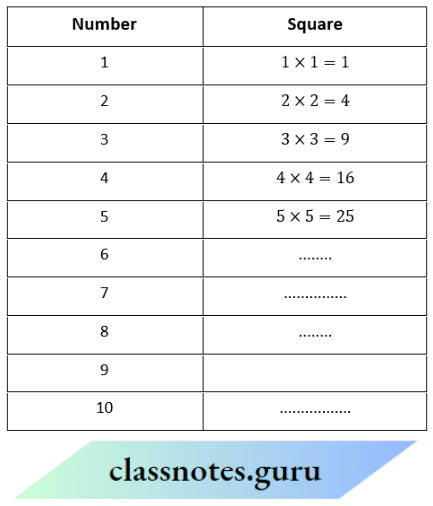
From the above table, can we list the square numbers between 1 and 100? Are there any natural square numbers up to 100 left out ? From the above table, can we enlist the square numbers between 1 and 100? Are there any natural square numbers up to 100 left out?
Solution:
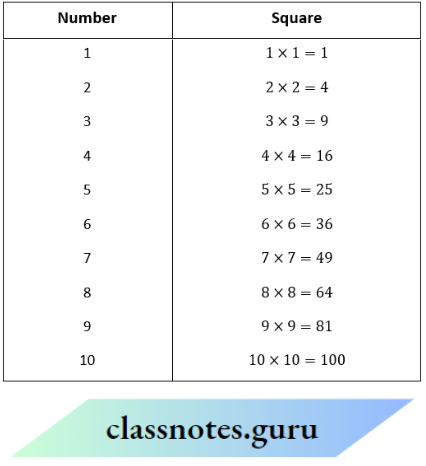
From the above table, we can list the square numbers between 1 and 100.
Such numbers are listed below:
4, 9, 16, 25, 36, 49, 64, and 81. Also, we see that no natural square numbers up to 100 are left out.
NCERT solutions for class 8 maths chapter 5
Question 2. Find the perfect square numbers between
Solution:
1. We know that 5²= 5 × 5 = 25, 6²= 6 × 6 = 36 and 7² = 7 × 7 = 49.
So, the perfect square number between 30 and 40 is 36.
2. We know that 7² = 7 × 7 = 49, and 8² = 8 × 8 = 64.
So there is no perfect square number between 50 and 60.
Question 1. Can we say that if a number ends in 0, 1, 4, 5, 6, or 9, then it must be a square number? Think about it,
Solution:
If a number ends with the digit 0, 1, 4, 5, 6, or 9 at its unit’s place, then it is not necessarily a square number.
For example:
The numbers 10, 21, 34, 325, 146, and 209 are not square numbers, although they end with 0, 1, 4, 5, 6, and 9 , respectively, at their unit’s places.
Note 1: The non-perfect, square numbers end with the digit 2, 3, 7, or 8. i.e., if a number ends with the digit 2, 3, 7, or 8 at its unit place, then it is necessarily a non-perfect square number.
Examples: 32, 42, 43, 53, 63
Note 2: If a number ends with an odd number of zeros at the end, then it is necessarily a non-perfect square number.
Examples: 70, 690, 1430
Question 2. Can we say whether the following numbers are perfect squares? How do we know?
Write five numbers which you can decide by looking at their unit’s digit that they are not square numbers.
Solution:
1. 1057
The number 1057 is not a perfect square because it ends with 7 at the unit’s place whereas the square numbers end with 0, 1, 4, 5, 6, or 9 only at the unit’s place.
2. 23453
The number 23453 is not a perfect square because it ends with 3 at the unit’s place whereas the square numbers end with 0, 1, 4, 5, 6, or 9 only at the unit’s place.
3. 7928
The number 7928 is not a perfect square because it ends with 8 at the unit’s place, whereas the square numbers end with 0, 1, 4, 5, 6, or 9 only at the unit’s place.
4. 222222
The number 222222 is not a perfect square because it ends with 2 at the unit’s place, whereas the square numbers end with 0, 1, 4, 5, 6, or 9 only at the unit’s place.
5. 1069
The number 1069 ends with 9 at the unit’s place. But we cannot say that 1069 is a perfect square number. It may or may not be a square number.
Also, 30 × 30 = 900
31 × 31 = 961
32 × 32 = 1024
33 × 33 = 1089
This shows that there is no natural number lying between 1024 and 1089 that is a square number.
As 1024 < 1069 < 1089, i.e., the number 1069 lies between 1024 and 1089, so 1069 is not a square number.
4. The number 2061 ends with 1 at the unit’s place. But we cannot say that 2061 is a perfect square number. It may or may not be a perfect square number.
Also, 45 × 45 = 2025
46 × 46 = 2116
This shows that there is no natural number lying between 2025 and 2116 that is a square number. Since 2025 < 2061 < 2116, i.e., the number 2061 lies between 2025 and 2116, therefore 2061 is not a square number.
The number 2061 ends with 1 at & the unit’s place. But we cannot say that 2061 is a perfect square number. It may or may not be an O-perfect square number.
Also, 45 × 45 = 2025
46 ×46 = 2116
This shows that there is no natural number lying between 2025 and 2116 that is a square number. Since 2025 < 2061 < 2116, i.e., the number 2061 lies between 2025 and 2116, therefore 2061 is not a square number.
Question 3. Write five numbers that you can decide by looking at their unit’s digit that they are not square numbers.
Solution:
The five numbers that we can decide by looking at their one digit that they are not square numbers are 1032, 453, 5567, 13258, and 13293.
[Note that the non-perfect square numbers end with the digits 2, 3, 7, or 8 at the unit’s place]
Question 4. Write five numbers that you can not decide just by looking at their unit digit (or unit place) whether they are square numbers or not
Solution:
100000, 3246, 56556, 12331, and 799
Note that the numbers ending with the digits 0, 1, 4, 5, 6, or 9 at the unit’s place may or may not be perfect square numbers.
Question 5. Which of 123², 77², 82², 161², and 109²would end with the digit 1?
Solution:
We know that if a number has 1 or 1 is 9 in the unit’s place, then its square ends with the digit 1.
So, 161² and 109² would end with the digit 1
Question 6. Write the next two square numbers respectively. after 441, which ends in ,1 and their corresponding numbers
Solution:
From Table 1 on page 91. We find that 441 = 21 x 21= 21s. So, the next two square numbers that end in are
29² (= 841) and 31² ( = 961) and their corresponding numbers are 29 and 31respectively.
[Note that if a number has 1 or 9 in the unit’s place, then its square ends with the digit 1.]
Class 8 maths chapter 5 question answer
Question 7. Which of the following numbers has the digit 6 at the unit place?
Solution:
Note that when a square number ends with digit 6, then the number whose square it is will have either 4 or 6 in the unit’s place. So,
1. The digit at the unit’s place = 9
∴ 19² would not have 6 in place.
2. The digit at the unit’s place = 4
∴ 24² would have 6 at the unit’s place.
3. The digit at the unit’s place = 6
∴ 26² would have 6 at the unit place
Question 8. Can you find more such rules by observing the numbers and their squares
Solution:
Yes; We can find more such rules by observing the numbers and their squares
These are as follows:
Question 9. What will be the one digit in the square of the following number?
Solution:
1. 1234
Ending digit = 4 and 4² = 4× 4 = 16
∴ The one digit in the square of the number 1234 will be 6.
2. 26387
Ending digit = 7 and 7² = 7 × 7 = 49
∴ The one digit in the square of the number 26387 will be 9.
3. 52698
Ending digit = 8 and 8² = 8×8 = 64
∴ The one digit in the square of the number 52698 will be 4.
4. 99880
Ending digit = 0 and 0² = 0×0 = 0
∴ The one digit in the square of the number 99880 will be 0.
5. 21222
Ending digit = 2 and 2² = 2×2 = 4
∴ The one’s digit in the square of the number 21222 will be 4
6. 9106
Ending digit = 6 and 6² = 6 × 6 = 36
∴ The one’s digit in the square of the number 9106 will be 6
Question 10. If a number contains 3 zeros at the end, how many zeros will its square have? What do you notice about the number of zeros at the end of the number and the number of zeros at the end of its square? Can we say that square numbers can only have an even number of zeros at the end?
Solution:
If a number contains 3 zeros at the end, then its square will have 3 × 2 = 6 zeros at the end
The number of zeros at the end of a number
=\(\frac{1}{2}\) ×The number of zeros at the end of its square.
Yes; we can say that square numbers can only have an even number of zeros at the end.
Question 11. With numbers and their squares. What can you say about the squares of even numbers and squares of odd numbers?
Solution:
Question 12. Square of which of the following numbers would be an odd number/an even number? Why?
Solution:
1. 727
The square of 727 will be an odd number because the number 727 is odd
2. 158
The square of 158 will be an even number because be a number
∴ 158 is an even number
3. 269
The square of 269 will be an odd number because the number ‘
∴ 269 is an odd number
4. 1980
The squares of 1980 will be an even number because the number
∴ 1980 is an even number
Question 13. What will be the number of zeros in the square of the following numbers?
Solution:
1. 60
Number of zeros at the end of (the number 60 = 1)
∴ The number of zeros in the square of (be number 60 will be 2 ×1 = 2.
2. 400
Number of zeros at the end of the number 400 = 2
∴ The number of zeros in the square of the number 400 will be 2 × 2 = 4
Note that the number of zeros at the end of the square of a number = 2 × the number of zeros at the end of that number
1. A triangular number is one whose dot patterns can be arranged as triangles. If we combine two consecutive triangular numbers, we get a square number.
2. There are 2n non-perfect square numbers between the squares of the numbers n and (n + 1), which is 1 less than the difference of two squares.
3. The sum of the first n odd natural numbers is n².
4. We can express the square of any odd number as the sum of two consecutive positive integers
Note: \(n^2=\frac{n^2-1}{2}+\frac{n^2+1}{2}\)
Example: \((11)^2=\frac{121-1}{2}+\frac{121+1}{2}\)
= 60 + 61
=121
5. If (n + 1) and (n – 1) are two consecutive even or odd natural numbers, then (n + 1) x (n – 1) = n² – 1
Question 1. How many numbers are there between 6² and 7²
Solution:
Let n = 6
Then, n + 1 = 6 + 1 = 7
∴ There are 2n = 2 × 6 = 12
Nonperfect square numbers between 62 and 72
Question 2. Check for n = 5, n = 6, n = 7 etc., and verify
Solution:
1. n = 5
.’. n + 1 = 6
There are 2n = 2 × 5 = 10 non perfect square numbers between 5² and 6²
These are 26, 27, 28, 29, 30, 31, 32, 33, 34, and 35.
2. n = 6
n + 1 = 7
There are 2n = 2 × 6 = 12 non-perfect square numbers between 62 and 72.
These are 37, 38, 39, 40, 41, 42, 43,44, 45, 46, 47, and 48
3. n = 7
n + 1 = 8
There are 2n = 2 × 7 = 14
Non-perfect square numbers between 7² and 8².
These are 50, 51, 52, 53, 54, 55, 56, 57, 58, 59, 60, 61, 6,2 and 63
Question 3. How many natural numbers lie between 9² and 10² Between 11² and 12²
Solution:
1. Here, n = 9
2n = 2 × 9 = 18.
So, 18 natural numbers lie between 9² and 10².
2. Here, n = 11
2n = 2 × 11 = 22.
So, 22 natural numbers lie between 11² and 12²
Class 8, chapter 5, squares and square roots
Question 4. How many non-square numbers lie between the following pairs of numbers?
Solution:
1. Here, n = 100
∴ 2n = 2 × 100 = 200.
So, 200 non-square numbers lie between the pair of numbers 100² and 101²
2. Here, n = 90
∴ 2n = 2×90 = 180.
So, 180 non-square numbers lie between the pair of numbers 90² and 91².
3. Here, n = 1000
∴ 2n = 2 × 1000 = 2000.
So, 2000 non-square numbers lie between the pair of numbers 1000² and 1001²
Question 5. 1 + 3 + 5 + 7 […] = 16 = 42 1+3 + 5 + 7+ 9[..]= 25 = 52 1+3 + 5+7 + 9 + 11 […] =36 = 62
Solution:
⇒ 1 + 3 + 5 + 7
[Sum of the first four odd numbers]
= 16 = 4²
⇒ 1 +3 + 5 + 7 + 9
[Sum of the first five odd numbers]
= 25
= 5²
1 + 3 + 5 + 7 + 9+11
[Sum of the first six odd numbers]
= 36
= 36
Question 6. Find whether each of the following numbers is a perfect square or not.
Solution:
1. Successively subtract consecutive odd natural numbers starting with l. i.e .. 1. 3, 5, 7. 5), … from 121.
121 – 1 = 120
120 – 3 = 117
117 – 5 = 112
112 – 7 = 105
105 – 9 = 96
96 – 11 = 85
85 – 13 = 72
72 – 15 = 57
57 – 17 = 40
40 – 19 = 21
21 – 21 = 0
This means that
121 = 1 + 3 + 5 + 7 + 9 + 11 + 13 + 15 + 17 + 19 + 21
i.e., we can express 121 as the sum of consecutive odd numbers starting with 1.
∴ 121 is a perfect square number. number.
2. Successively subtract consecutive odd natural numbers starting with 1, i.e., 1, 3, 5, 7, 9, … from 55.
55 – 1 = 54
54 – 3 = 51
51 – 5 = 46
46 – 7 = 39
39 – 9 = 30
30 – 11 = 19
19 – 13 = 6
6 – 15 = -9
This shows that we are not able to express 55 as the sum of consecutive odd numbers starting with 1
∴ 55 is not a perfect square number
3. Successively subtract consecutive odd natural numbers starting with 1, i.e., 1, 3, 5, 7, 9, … from 81
81 – 1 = 80
80 – 3 = 77
77 – 5 = 72
72 – 7 = 65
65 – 9 = 56
56 – 11 = 45
45 – 13 = 32
32 – 15 = 17
17 – 17 = 0
This means that
81 = 1 + 3 + 5 + 7 + 9+11 + 13 + 15 + 17.
i.e., we can express 81 as the sum of consecutive odd numbers starting with 1.
∴ 81 is a perfect square number
4. Successively subtract consecutive odd natural numbers starting with 1, i.e., 1, 3, 5, 7, 9, … from 49
49 – 1 = 48
48 – 3 = 45
45 – 5 = 40
40 – 7 = 33
33 – 9 = 24
24 – 11 = 13
13 – 13 = 0
This means that
9 = 1 + 3 + 5 + 7 + 9 + 11 + 13
We can express 49 as the sum of consecutive odd numbers starting with 1.
∴ 49 is a perfect square number.
5. Successively subtract consecutive odd natural numbers starting with 1, i.e. 3. 5. 7. 9. … from 69.
69 – 1 = 68
68 – 3 = 65
65 – 5 = 60
60 – 7 = 53
53 – 9 = 44
44 – 11= 33
33 – 13 = 20
20 – 15 = 5
5 – 17 = -12
This shows that we are not able to express 69 as the sum of consecutive odd numbers starting with 1
.
∴ 69 is not a perfect square number
Question 7. Express the following as the sum of two consecutive integers.
Solution:
1. Here, n = 21
∴ \(\frac{n^2-1}{2}=\frac{21^2-1}{2}=\frac{441-1}{2} \)
= \(\frac{440}{2}=220 \\\)
And \(\frac{n^2+1}{2}=\frac{21^2+1}{2}=\frac{441+1}{2}\)
= \(\frac{442}{2}=221 \)
∴ 21² = 220 + 221
= 441
2. Here n=13
∴ \(\frac{n^2-1}{2}=\frac{13^2-1}{2}=\frac{169-1}{2} \)
=\(\frac{168}{2}=84 \)
And \(\frac{n^2+1}{2}=\frac{13^2+1}{2}=\frac{169+1}{2} \)
= \(\frac{170}{2}=85 \)
13² = 84 + 85
= 169
3. Here n= 11
∴ \(\frac{n^2-1}{2}=\frac{11^2-1}{2}=\frac{121-1}{2}\)
= \(\frac{120}{2}=60 \)
And \(\frac{n^2+1}{2}=\frac{11^2+1}{2}=\frac{121+1}{2} \)
= \(\frac{122}{2}=61 \)
11² = 60 + 61
= 121 .
4. Here n= 19
⇒ \(\frac{n^2-1}{2}=\frac{19^2-1}{2}=\frac{361-1}{2} \)
=\(\frac{360}{2}=180 \)
And\(\frac{n^2+1}{2}=\frac{19^2+1}{2}=\frac{361+1}{2} \)
= \(\frac{362}{2}=181\)
19² = 180 + 181
= 361.
NCERT class 8 maths chapter 5 solutions PDF
Question 8. Do you think the reverse is also true, i.e., is the sum of any two consecutive positive integers is perfect square of a number? Give an example to support your answer
Solution:
No; The reverse is not always true.
For example :
1. Consider two consecutive positive integers, 3 and 4. Their sum is 3 + 4 = 7, which is not a perfect square of a number.
2. Consider two consecutive positive integer,s 8 and 9. Their sum is 8 + 9 = 17, which is not a perfect square of a number
Question 9. Write the square, making use of the above pattern.
Solution:
1. 11111²
11111²= 1234565432
2. 1111111²
1111111² = 1234567654321
Question 10. Can you find the square, of the following numbers using the above pattern?
Solution:
1. 6666667²
66666672 = 44444448888889
2. 66666667²
66666667² = 4444444488888889
Question 1. What will be the unit digit of the squares of the following numbers?
Solution:
1. Unit’s digit of 81 = 1
⇒ 1 × 1 = 1
∴ The unit digit of the square of the number 81 will be 1.
2. Unit’s digit of 272 = 2
⇒ 2 × 2 = 4
∴ The unit digit of the square of the number 272 will be 4.
3. Unit’s digit of 799 = 9
⇒ 9 × 9 = 81
∴ The unit digit of the square of the number 799 will be 1.
4. Unit’s digit of 3853 = 3
⇒ 3 × 3 = 9
∴ The unit digit of the square of the number 3853 will be 9.
5. Unit’s digit of 1234 = 4
⇒ 4 × 4 = 16
∴ The unit digit of the square of the number 1234 will be 6.
6. Unit’s digit of 26387 = 7
⇒ 7 × 7 = 49
∴ The unit digit of the square of the number 26387 will be 9.
7. Unit’s digit of 52698 = 8
⇒ 8 × 8 = 64
∴ The unit digit of the square of the number 52698 will be 4.
8. Unit’s digit of 99880 = 0
⇒ 0 × 0 = 0
∴ The unit digit of the square of the number 99880 will be 0.
9. Unit’s digit of 12796 = 6
⇒ 6 × 6 = 36
∴ The unit digit of the square of the number 12796 will be 6.
10. Unit’s digit of 55555 = 5
⇒ 5 × 5 = 25
∴ The unit digit of the square of the number 55555 will be 5.
Question 2. The following numbers are not perfect squares. Give reasons.
Solution:
1. 1057
The number 1057 is not a perfect square because it ends with 7 at the unit’s place, whereas the square numbers end with 0. I, 4. 5, 6, or 9 only at the unit’s place.
2. 23453
The number 23453 is not a perfect square because it ends with 3 at the unit’s place, whereas the square numbers end with 0, 1, 4, 5, 6, or 9 only at the unit’s place.
3.7928
The number 7928 is not a perfect square because it ends with 8 at the unit’s place, whereas the square numbers end with 0, 1, 4, 5, 6, or 9 at the unit’s place.
4. 222222
The number 222222 is not a perfect square because it ends with 2 at the unit’s place, whereas the square numbers end with 0, 1, 4, 5, 6, or 9 only at the unit’s place.
5. 64000
The number 64000 is not a square number because it has 3 (an odd number of) zeros at the en,d whereas the number of zeros at the end of a square number ending with zeros is always even
6. 89722
The number 89722 is not a square number because it ends in 2 at the unit’s plac,e whereas the square numbers end with 0, 1, 4, 5, 6, or 9 only at the unit’s place.
7. 222000
The number 222000 is not a square number because it has 3 (an odd number) zeros at the end whereas the number of zeros at the end of a square number ending with zeros is always even.
8. 505050
The number 505050 is not a square number because it has 1 (an odd number) zeros i at the end whereas the number of zeros at the end of a square number ending with zeros is always even.
Squares and square roots class 8 extra questions
Question 3. The squares of which of the following would be odd numbers?
Solution:
1. 431
431 is an odd number
∴ Its square will also be an odd number
2. 2826
2826 is an oven number
∴ Its square will not be an odd number.
3. 779
779 is an odd number
∴ Its square will be an odd number.
4. 82004
82004 is an even number
∴ Its square will not be an odd number.
[Note that the squares of odd numbers are odd numbers and the squares of even numbers are even numbers
Question 4. Observe the following pattern and find the missing digits :
Solution:
4. 100001² = 10000200001
5. 10000001² = 100000020000001
Question 5. Observe the following pattern and supply the missing numbers
Solution:
4. 1010101² = 1020304030201
5. 101010101² = 10203040504030201
Question 6. Using the given pattern, find the jJJ missing numbers
Solution:
4. 4² + 5² + 20² = 21²
5. 5² + 6²+ 30² = 31²
6. 6² + 7² + 4²= 43²
Question 7. Without adding, find the sum :
Solution:
1. 1 + 3 + 5 + 7 + 9
= Sum of the first five odd natural numbers
= 5² = 25
2. 1 + 3 + 5+ 7 + 9 + 11 + 13 + 15+17+19
= Sum of the first ten odd natural numbers
= 10² = 100
1 + 3 + 5 + 7 + 9+11+13 + 15+17+19 + 21 + 23
= Sum of the first twelve odd natural numbers
= 12² = 144.
[Note that the sum of the first n odd natural numbers is n².]
Question 8.
Solution:
1. 49 = 7 × 7 = 7²
= 1 + 3 + 5 + 7 + 9+11 + 13
2. 121 = 11 × 11 = 11²
= 1 + 3 + 5 + 7 + 9+11 + 13 + 15 + 17 + 19 + 21
Question 9. How many numbers lie between the squares of the following numbers?
Solution:
1. Here, n = 12 and n + 1 = 13
∴ 2n, = 2 × 12 = 24
So, 24 numbers lie between the squares of the numbers 12 and 13.
2. Here, n = 25 and n + 1 = 26
∴ 2n = 2 × 25 = 50
So, 50 numbers lie between squares of the numbers 25 and 26.
3. Here, n = 99 and 11+ 1 = 100
∴ 2n = 2 x 99 = 198
So, 198 numbers he between the squares of the numbers 99 and 100
.
[Note that 2n natural numbers lie between the squares of the numbers n and (n + 1
23s = (20 + 3)² = (20 + 3) (20 + 3)
= 20 (20 + 3) + 3 (20 + 3)
= 20² + 20 × 3 + 3 × 20 + 32
= 400 + 60 + 60 + 9 = 529
Other Patterns In Squares
Let 5 be a number with the unit digit 5.
Then, (a.5)² = a (a + 1) hundred + 25
Question 1. Now, can you find the square of 95?
Solution:
(95)² = 9 (9 + 1) ×100 + 25
= 9 × 10 × 100 + 25
= 9000+ 25
= 9025
Question 2. Find the. squares of Ike following numbers containing 5 in unit’s place:
Solution:
1. 15² = (1×2) hundred + 25
= 200 + 25 = 225
2. 952 = (9 ×10) hundred + 25
= 9000 + 25 = 9025
3. 1052 = (10 × 11) hundred + 25
= 11000 + 25 = 11025
4. 2052 = (20 × 21) hundred + 25
= 42000 + 25 = 42025
Class 8 maths chapter 5 MCQ
1. If a, b, and c are three numbers such that any one of the following three relations holds :
Then the numbers a, b, and c are said to form a Pythagorean triplet.
For example, 3, 4, 5 is a Pythagorean triplet because
3² + 42 = 9 + 16 = 25 = 5² .
Can you find more such triplets?
Yes, we can find more such triplets.
For example: 8, 15, 17; 9, 12, 15; 12, 35, 37, etc.
2. For any natural number m > 1, (2m, m² – 1, m² + 1) forms a Pythagorean triplet.
Try to find some more Pythagorean triplets using this form.
Some more Pythagorean triplets using this form are as follows :
6, 8, 10; taking m = 3
8, 15, 17; taking m. = 4
10, 24, 26; taking m = 5
Question 1. Find the square of the following numbers
Solution:
1. 32 = 30 + 2
⇒ 32 = 30 + 2
Therefore, 32² = (30 + 2)²
= (30 + 2) (30 + 2)
= 30(30 + 2) +2(30 + 2)
= 900 + 60 + 60 + 4
= 1024
2. 35 =30+5
⇒ 35 =30+5
Therefore, 35² = (30 + 5)²
= (30 + 5) (30 + 5)
= 30 (30 + 5) + 5 (30 + 5)
= 900+ 150+ 150 + 25
= 1225
3. 86 = 80 + 6
⇒ 86 = 80 + 6
Therefore, 86² = (80 + 6)²
= (80 + 6) (80 + 6)
= 80 (80 + 6) + 6 (80 + 6)
= 6400 + 480 + 480+36
= 7396
4. 93 = 90 + 3
⇒ 93 = 90 + 3
Therefore, 93² = (90 + 3)²
= (90 + 3) (90 + 3)
= 90 (90 + 3) + 3 (90 + 3)
= 8100 + 270+270+9
= 8649
5. 71 = 70+1
⇒ 71 = 70+1
Therefore, 71² = (70 + 1)²
= (70+ 1) (70+ 1)
= 70(70+ 1)+ 1(70+ 1)
= 4900+70 + 70+1
= 5041
6. 46 =40 + 6
⇒ 46 =40 + 6
Therefore, 46² = (40 + 6)²
= (40 + 6) (40 + 6)
= 40 (40 + 6) + 6 (40 + 6)
= 1600 + 240 + 240 + 36
= 2116
Question 2. Write a Pythagorean triplet whose one number is
Solution:
1. Let 2m. = 6
⇒ m = – = 3
m² – 1 = 3² – 1 = 9 – 1 = 8
And m² + 1 = 3² + 1 = 9 + 1 = 10
So, a Pythagorean triplet, whose one member is 6, is 6, 8, 10.
2. Let 2m = 14
⇒ m = \(\frac{14}{2}\) = 7
∴ m²- 1=7² -1 = 49 – 1= 48
and m² + 1 = 7² + 1 = 49 + 1 = 50
So, a Pythagorean triplet, whose one member is 14, is 14, 48, 50.
3. Let 2m = 16
⇒ m = \(\frac{16}{2}\)
∴ m²- 1= 8² – 1 = 64 – 1 = 63
m² + 1 = 8² + 1 = 64 + 1 = 65
So, a Pythagorean triplet, whose one number is 16, is 16, 63, 65.
4. Let 2m =18
⇒ m = \(\frac{18}{2}\)
∴ m²- 1= 9² – 1 = 81- 1 = 80
m² + 1 = 9² + 1 = 81 + 1 = 82
So, a Pythagorean triplet, whose one of the numbers is 18, is 18, 80, 82.
The square root of a number ‘a is that number which, when multiplied by itself, gives that number ‘a as a product.
Thus, if b is the square root of a;
Then b × b = a or b² = a
Symbolically, we write
b = \(\sqrt{a}\)
Note: b = \(\sqrt{a}\) ⇔ b² = a i.e., is the square root iofaaisthesquare ofb
Finding Square Roots
To /meet a number whose square is known is known as finding the square root.
Finding the square root is the inverse (opposite) operation of squaring.
There are two integral square roots of a perfect square number.
For example : 4 = (2)² = (- 2)²
∴ \(\sqrt{4}\) = 2 and – 2 both. Here, we shall take up only the positive square rootof a natural number.
Thus, \(\sqrt{4}\) = 2 (not- 2)
The positive square root of a number is denoted by the symbol V.
For example,
3² = 9
⇒ \(\sqrt{9}\)
= 3
Question 1. 11² = 121. What is the square root
Solution:
The square root of 121 is 11.
Question 2. 14² = 196. What is the square root of
Solution:
The square root of 196 is 14
Question 3.
Solution:
We subtract successive odd numbers starting from 1 from the given square number till we get zero. The number of times, we have to make subtractions, gives the square root of the given square number.
Question 1. By repeated subtraction of odd (iii) 0) numbers starting from 1, find whether the following numbers are. perfect squares or not? If the number is a perfect square then find its square root.
Solution:
1. 121
Since from 121 we subtracted successive odd numbers starting from 1 and obtained 0 at the 11th step,
∴ \(\sqrt{121}\) = 11.
2. 55
This shows that we are not able to get zero at any step while subtracting successive odd numbers starting from 1 to 55.
∴ 55 is not a perfect square
3.36
Since from 36 we subtracted successive odd numbers starting from 1 and obtained 0 at the 6th step, therefore, = 6.
4. 49
Since from 49 we subtracted successive odd numbers starting from 1 and obtained 0 at the 7th step,
∴ \(\sqrt{49}\) =7
This shows that we are not able to get zero at any step while subtracting successive odd numbers starting from 1 to 90.
∴ 90 is not a perfect square.
Class 8 maths squares and square roots worksheet
We find the prime factors of the given perfect square and arrange them in pairs. Then, we choose one factor from each pair and multiply it together. The product thus obtained gives the required square root.
Note: A square number has complete pairs of prime factors.
Question 1. What could be the possible ‘one’s’ digits of the square root of each of the following numbers?
Solution:
1. 9801
∴ 1 × 1 = 1 and 9 × 9 = 81
The possible one’s digit of the square root of the number 9801 could be 1 or 9.
2. 99856
∴ 4 × 4= 16 and 6 × 6 = 36
The possible one-digit of the square root of the number 99856 could be 4 or 6.
3. 99856
∴ 1 × 1 = 1 and 9 × 9 = 81
The possible one-digit of the square root of the number 998001 could be 1 or 9.
4. 657666025
∴ 5 × 5 = 25
The possible one digit of the square root of the number 657666025 could be 5
Question 2. Without doing any calculation, find the numbers which are surely not perfect squares.
Solution:
1. 153
The number 153 is surely not a perfect square because it ends in 3 whereas the square numbers end with 0, 1, 4, 5, 6, or 9 only.
2. 257
The number 257 is surely not a perfect square because it ends in 7 whereas the square numbers end with 0, 1, 4, 5, 6 or 9
3. 408
The number 408 is surely not a perfect square because it ends in 8 whereas the square numbers end with 0, 1, 4, 5, 6, or 9 only.
4. 441
The number 441 may be a perfect square as the square numbers end with 0, 1, 4, 5, 6, or 9 only.
Question 3. Find the square roots of 100 and 169 by the method of repeated subtraction.
Solution:
1.100
Since from 100, we subtracted successive odd numbers starting from 1 and obtained 0 at the 10th step, therefore, \(\sqrt{100}\)= 10.
2. 169
Since from 169, we subtracted successive odd numbers starting from 1 and obtained 0 at I the 13th step, therefore,\(\sqrt{169}\)= 13.
Question 4. Find the square roots of the following numbers by the Prime Factorisation Method
Solution:
1. The prime factorization of 729 is
729 = 3 × 3 × 3 × 3 × 3 × 3.

By pairing the prime factors, we get
729 = \(3 \times 3 \times 3 \times 3 \times 3 \times 3\)
So, \(\sqrt{729}=3 \times 3 \times 3\) = 27
2. The prime factorization of 400 is
400 = 2× 2× 2× 2× 5× 5.
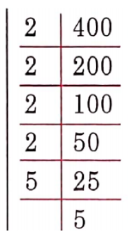
By pairing the prime factors we get
400 = \(2 \times 2 \times 2 \times 2 \times 5 \times 5\)
∴ \(\sqrt{400}=2 \times 2 \times 5\)
= 20
3. The prime factorisation 2 1764of 1764 is 2
1764 = 2 × 2 × 3×3 × 7 × 7
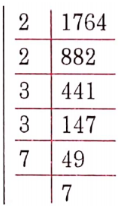
By pairing the prime factors, we get
1764 = \(2 \times 2 \times 3 \times 3 \times 7 \times 7\)
So, \(\sqrt{1764}=2 \times 3 \times 7\)
= 42
4. The prime factorization 2 512 of 4096 is
4096 = 2 × 2 × 2 × 2 × 2 × 2× 2 × 2× 2×2× 2× 2

By pairing the prime factors, we get
4096 = \(\underline{2 \times 2} \times \underline{2 \times 2} \times \underline{2 \times 2}\) × \(\underline{2 \times 2} \times \underline{2 \times 2} \times \underline{2 \times 2}\)
So, \(\sqrt{4096}=2 \times 2 \times 2 \times 2 \times 2 \times 2\)
= 64
5. The prime factorisation of 7744 is
7744 = 2 × 2× 2 × 2 × 2 × 2 ×11× 11.

By pairing the prime factors, we get
7744 = \(\underline{2 \times 2} \times \underline{2 \times 2} \times \underline{2 \times 2}\)
So,\(\sqrt{7744}=2 \times 2 \times 2 \times 11\)
6. The prime factorisation of 9604 is
9604 = 2 × 2 × 7 × 7 × 7 ×7.

By pairing the prime factors, we get
9604 = \(\underline{2 \times 2} \times \underline{7 \times 7} \times \underline{7 \times 7} \)
So, \(\sqrt{9604}=2 \times 7 \times 7=98\)
Class 8 maths chapter 5 explanation
7. The prime factorization of 5929 is
5929 = 7 × 7 × 11 × 11
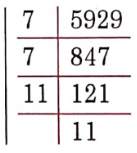
By pairing the prime factors, we get
5929 = \(\underline{7 \times 7} \times \underline{11 \times 11}\)
So, \(\sqrt{5929} =7 \times 11=77\)
8. The prime factorisation of 9216 is
9216 = 2 × 2 × 2 × 2 × 2× 2 × 2 × 2× 2 × 2 × 3 × 3

By pairing the primary factors get
9216 = \( \underline{2 \times 2} \times \underline{2 \times 2} \)
So, \(\times \underline{2 \times 2} \times \underline{2 \times 2} \times \underline{2 \times 2} \times \underline{3 \times 3}\)
⇒ \(\sqrt{9216}=2 \times 2 \times 2 \times 2 \times 2 \times 3\)
= 96
9. The prime factorization of 529 is
529 = 23 × 23.

By pairing the prime factors, we get
529 = \(\underline{23 \times 23} \)
So,\(\sqrt{529}\) = 23
10. The prime factorisation of 8100 is
8100 = 2 × 2 × 3 × 3 × 3 × 3 × 5 × 5.
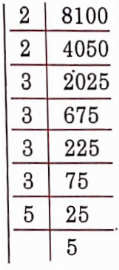
By pairing the prime factors, we get
8100 =\(\underline{2 \times 2} \times \underline{3 \times 3} \times \underline{3 \times 3} \times \underline{5 \times 5}\)
So, \(\sqrt{8100}\) = 2×3 × 3 × 5
= 90.
Question 5. For each of the following numbers, find the smallest whole number by which it should be multiplied to get a perfect square number. Also, find the square root of the square number so obtained
Solution:
1. The prime factorization of 252 is
252 = 2 × 2 × 3× 3× 7

By pairing the prime factors, we get
252= \(\underline{2 \times 2} \times \underline{3 \times 3} \times 7\)
As the prime factor 7 has no pair, 252 is not a perfect square.
If 7 gets a pair, then the number will be a perfect square. So, we multiply 252 by 7 to get
252 × 7 = \(\underline{2 \times 2} \times \underline{3 \times 3} \times \underline{7 \times 7}\)
Now each prime factor has a pair. Therefore, 252× 7 = 1764 is a perfect square. Thus the required smallest number is 7.
Also,\(\sqrt{1764}\) =2 × 3× 7
= 42
2. The prime factorisation of 180 is
180 = 2 × 2 × 3 × 3×5
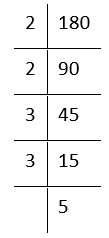
By pairing the prime factors, we get
180 = \(\underline{2 \times 2} \times \underline{3 \times 3} \times \underline{3 \times 3} \times \) x 5
As the prime factor 5 has no pair, 180 is not a perfect square.
If 5 gets a pair, then the number will be a perfect square. So, we multiply 180 by 5 to get
180 × 5= \(\underline{2 \times 2} \times \underline{3 \times 3} \times \underline{3 \times 3} \times \underline{5 \times 5}\)
Now each prime factor has a pair. Therefore, 180 × 5 = 900 is a perfect square. Thus the required smallest number is 5
Also, \(\sqrt{900}\)
= 2 × 3× 5 = 30
3. The prime factorization of 1008 is
1008 = 2 × 2 × 2×2 × 3 × 3 × 7
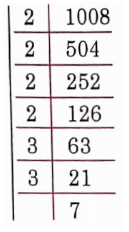
By pairing the prime factors, we get
1008 = \(\underline{2 \times 2} \times \underline{2 \times 2} \times \underline{3 \times 3} \times 7\)
As the prime factor 7 has no pair, 1008 is not a perfect square.
If 7 gets a pair, then the number wil be a perfect square. So, we multiply 1008 by 7 to get
1008 × 7 = \(\underline{2 \times 2} \times \underline{2 \times 2} \times\underline{3 \times 3} \times \underline{3 \times 3} \times \underline{7 \times 7}\)
Now each prime factor has a pair, Therefore, 1008 x 7 = 7056 is a perfect square, Thus the required smallest number is 7
Also, \(\sqrt{7056}\)
= 2 × 2 × 3× 7 = 84
4. The prime factorization of 2028
2028 = 2 × 2 × 3 × 13 × 13.
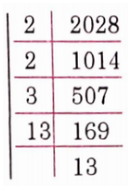
By pairing the prime factors, we get
2028 = \(\underline{2 \times 2}\) × 3 × \(\underline{13 \times 13}\)
As the prime factor 3 has no pair, 2028 is not a perfect square
If 3 gels a pair, then (.ho number will be a perfect square. So, we multiply 2028 by 3 to got
2028 × 3 = \(\underline{2 \times 2} \times \underline{3 \times 3} \times \underline{13 \times 13}\)
Now each prime factor has a pair. Therefore, 2028 x 3 = 6084 is a perfect square. Tims the required smallest number is 3.
Also,\(\sqrt{6084}\)
= 2 × 3 × 13 = 78.
5. The prime factorisation of 1458 is
1458 =2 × 3 × 3× 3 × 3 × 3 × 3
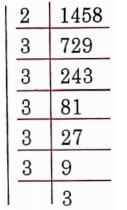
By pairing the prime 3 9 factors, we get
1458 = 2 ×\(\underline{3 \times 3} \times \underline{3 \times 3} \times \underline{3 \times 3} \times \underline{3 \times 3}\)
As the prime factor 2 has no pair,1458 is not a perfect square.
If 2 gets a pair, then the number will be a perfect square. So, we multiply 1458 by 2 to get
1458 × 2 = \(\underline{2 \times 2} \times\underline{3 \times 3} \times \underline{3 \times 3} \times \underline{3 \times 3} \times \underline{3 \times 3}\)
Now each prime factor has a pair. Therefore, 1458 x 2 = 2916 is a perfect square. Thus the required smallest number is 2
Also, \(\sqrt{2916}\)= 2 × 3 × 3 × 3
= 54
6. The prime 768 factorisation of 768 is
768 = 2 × 2 × 2 × 2 × 2 × 2 × 2 × 2 × 3.

By pairing the prime factors, we get
786= \(\underline{2 \times 2} \times\underline{2 \times 2} \times \underline{2 \times 2} \times \underline{2 \times 2}\) x 3
As the prime factor 3 has no pair, 768 is not a perfect square.
If 3 gets a pair, then the number will be a perfect square. So, we multiply 768 by 3 to get
768 × 3 = \(\underline{2 \times 2} \times\underline{2 \times 2} \times \underline{2 \times 2} \times \underline{2 \times 2} \times \underline{3 \times 3}\)
Now (the inch prime factor has a pair. Therefore, 768 x 3 = 2304 to a perfect square. Thus the required smallest number is 3.
Also, \(\sqrt{2304}\) = 2 × 2 × 2 × 2 × 3
= 48
Question 6. For each of the following numbers, find the smallest whole number by which it should be divided so as to get a perfect square. Also, find the square root of the square number so obtained
Solution:
1. The prime factorisation of 252 is
252 = 2 × 2 × 3 × 3 × 7
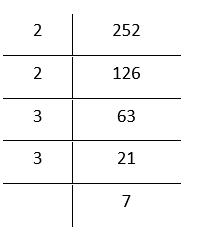
By pairing the prime factors, we get
252 = \(\underline{2 \times 2} \times\underline{3 \times 3} \times\)7
We see that the prime factor 7 has no pair. So, if we divide 252 by 7, then we get
252 ÷ 7 = \(\underline{2 \times 2} \times\underline{3 \times 3}\)
Now each prime factor has a pair.
∴ 252 ÷ 7 = 36 is a perfect square.
Thus, the required smallest number is 7
Also, \(\sqrt{36}\) = 2 × 3
= 6
2. The prime factorisation of 2925 is
2925 = 3 × 3 ×5 × 5 × 13.

By pairing the prime factors, we get
2925 = \(\underline{3 \times 3} \times\underline{5 \times 5} \times\) 13
We see that the prime factor 13 has no pair.
So, if we divide 2925 by 13, then we get
2925 ÷ 13 =\(\underline{2 \times 2} \times\underline{5 \times 5}\)
Now each prime factor has a pair.
∴ 2925 ÷ 13 = 225 is a perfect square.
Thus, the required smallest number
Also, \(\sqrt{224}\)= 3 × 5
= 15
3. The prime factor ion of 306 is
306 = 2 × 2 × 3 × 3 × 11
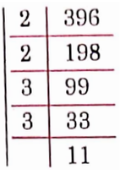
By pairing the prime 2 factors, we get
396 = \(\underline{3 \times 3} \times\underline{5 \times 5}\) ×11
We see that the prime factor 11 has no pair. So, if we divide 396 by 11, then we get
= \(\underline{2 \times 2} \times\underline{3 \times 3}\)
Now each prime factor has a pair.
∴ 396 ÷ 11 = 36 is a perfect square.
Thus, the required smallest number is 11.
Also , \(\sqrt{2}{3}\)
= 6
4. The prime factorisation of 2645 is
2645 = 5 × 23 × 23.

By pairing the prime factors, we get
2645 = \(\underline{23 \times 23}\)
Now the only prime factor 23 has a pair.
Therefore, 2645 ÷ 5 = 529 is a perfect square.
Thus, the required smallest number is 5
Also, \(\sqrt{529}\) =23
5. The prime factorisation of 2800 is
2800 = 2 × 2 × 2 × 2 × 5 × 5 × 7.

By pairing the prime factors, we get
2800 = \(\underline{2 \times 2} \times\underline{2 \times 2} \times \times\underline{5\times 5} \times\)7
We see that the prime factor 7 has no pair. So, if we divide 2800 by 7, then we get
2800 ÷ 7 \(\underline{2 \times 2} \times\underline{2 \times 2} \times \times\underline{5\times 5}\)
Now each factor has a pair. Therefore, 2800 + 7 = 400 is a perfect square. Thus, the required smallest number is 7.
Also, \(\sqrt{400}\)
= 2 × 2 ×5 = 20
6. The prime factorisation of 1620 is
1620 = 2 × 2 × 3×3 × 3 × 3 × 5

By pairing the prime factors, we get
1620 ÷ 5 = \(\underline{2 \times 2} \times\underline{3 \times 3} \times \times\underline{3\times 3}\)
Now each factor has a pair. Therefore, 1620 ÷ 5 = 324 is a perfect square. Thus, the required smallest number is 5.
Hence, \(\sqrt{324}\)= 2 × 3 × 3
= 18.
Square roots class 8 important questions
Question 7. The students of Class 8 of a school donated ₹ 2401 in all, for Prime Minister’s National ReliefFund, Each student donated as many rupees as the number of students in the class. Find the number of students in the class
Solution:
Let the number of students in the
Then rupees donated by each student = ₹ x
Rupees denoted by x students
= ₹ x × x
= ₹ x²
∴ The students of class 8th of a school donated ₹ 2401 for the Prime Minister’s National ReliefFund
⇒ \(x^2= 2401 \)
= \(\sqrt{2401}\)
The prime factorisation of 2401 is
x = \(\sqrt{2401} \)
= \(\sqrt{7 \times 7} \times 7 \times 7\)

x = 7 × 7 = 49
Hence, the number of students in the class is 49
Question 8. 2025 plants arc to be planted in a Now prime factorization of 2 180 pardons in such a nay that each row contains as many plants as the number of rows. Find the number of rows and the number of plants in each row
Solution:
Let the number of rows 3 2025 be x. 3 675
Then, the number of plants in each row = x.
Number of plants to be planted
= x × x
=x²
But 2025 plants are to be planted in the garden.
⇒ \(x^2=2025 \Rightarrow x=\sqrt{2025}\)
The prime factorization of 2025 is
2025= \(\underline{3 \times 3} \times\underline{3 \times 3} \times \times\underline{5\times 5}\)
x = \(\sqrt{2025}\)
x = \(\sqrt{3 \times 3} \times 3 \times 3 \times 5 \times 5\)
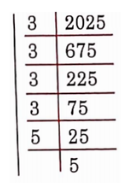
r = 3 × 3 × 5
x = 45
Hence, the number of rows is 45 and the number of plants in each row is 45
Question 9. Find the smallest square number that is divisible by each of the numbers 4, 9, and l0
Solution:
The least number divisible by each one of 4, 9, and 10 is their L.C.M
The L.C.M. of 4, 9 and 10 is
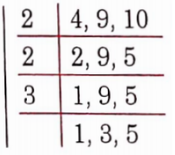
2 × 2 × 3 × 3 × 5 = 180
Now prime factorisation of 180 is
180 = \(\underline{2 \times 2} \times \underline{3 \times 3} \times \underline{3 \times 3} \times \underline{5 \times 5}\)
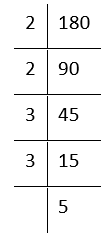
The prime factor 5 is not in pairs. Therefore 180 is not a perfect square.
To get a perfect square, each factor of 180 must be paired. So, we need to make a pair of 5
Therefore, 180 should be multiplied by 5.
Hence, the required smallest square
number is 180 ×5 = 900.
Question 10. Find the smallest square number that is divisible by each of the numbers 8, 15, and 20.
Solution:
The least number divisible by each one of 8, 15, and 20 is their L.C.M.
The L.C.M. of 8, 15 and
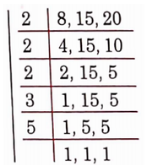
2 × 2 × 2 × 3 × 5 = 120
Now prime factorisation of 120 is
120 = \(\underline{2 \times 2}\) × 2 × 3 × 5

The prime factors 2, 3, and 5 are not in pairs.
∴ 120 is not a perfect square.
To get a perfect square, each factor of 120 must be paired. So, we need to make pairs of 2, 3, and 5. Therefore, 120 should be multiplied by 2 × 3 × 5; ie, 30.
Hence, the required smallest square number is 120 × 30 = 3600
Steps
Question 1. Can we say that if the perfect square is of n-digits, then its square root will have n/2 digits if n is even or \(\frac{(n+1)}{2}\)
Solution:
Yes. The following examples will establish the truth ofthe above fact.
1. Consider the perfect square 729. Here, n = 3 (which is odd)
∴ Number of digits in the square root
=\(\frac{n+1}{2}=\frac{3+1}{2}=2\)
= 2
Also =\(\sqrt{729}\)
= 27 (which has 2 digits)
2. Consider the perfect square 2025.
Here, n = 4 (which is even)
∴ Number of digits in the square root
= \(\frac{n}{2}=\frac{4}{2}\)
= 2
Also\(\frac{n}{2}=\frac{4}{2}\) =45(which has 2 digits)
Class 8 maths chapter 5 solved examples
Question 2. Without calculating square roots, find. the number of digits in the square root of the following numbers.
Solution:
1. By placing bars, we get \(\overline{2}\) \(\overline{56}\) \(\overline{00}\) Since there are 3 bars, the square root will be of 3 digits
Aliter:
Here, n = 5 (which is odd)
Number of digits in the square root
= \(\frac{n+1}{2}\)
= \(\frac{5+1}{2}\)
= \(\frac{6}{2}\)
= 3
2. By placing bars, we get \(\overline{3}\) \(\overline{68}\)\(\overline{64}\)
⇒ \(\overline{1} \overline{00} \overline{00} \overline{00} \overline{00}\)
Since there are 5 bars, the square root will be 5 digits.
Aliter:
Here, n = 9 (which is odd)
Number of digits in the square root
=\(\frac{n+1}{2}=\frac{9+1}{2}\)
= \(\frac{10}{2}=5\)
3. By placing bars, we get \(\)
Since there are 3 bars, the square root will be of 3 digits.
Aliter:
Here, n = 5 (which is odd)
Number of digits in the square root
=\(\frac{n+1}{2}=\frac{5+1}{2}\)
= \(\frac{6}{2}\)
= 3
Put bars on the integral part of the number in the usual manner. Place bars in the decimal part on every pair of digits beginning with the first decimal place. Proceed as usual to find the square root.
Question 1. Find the square root of each of the following numbers by the Division method:
Solution:
1. 2304

∴ \(\sqrt{2304}\)
= 48
2. 4489
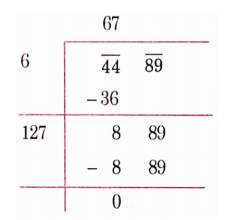
∴ \(\sqrt{4489}\)
= 67
3. 3481
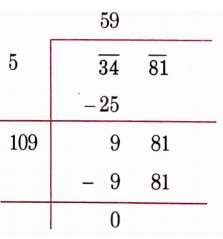
∴\(\sqrt{3481}\)
= 59
4. 529
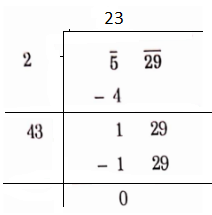
∴ \(\sqrt{529}\)
= 23
5.3249
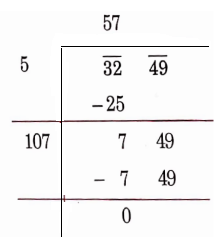
∴ \(\sqrt{3249}\)
= 57
6. 1369
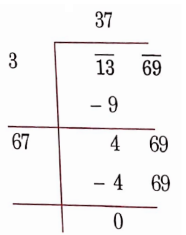
∴ \(\sqrt{1369}\)
= 37
7. 5776
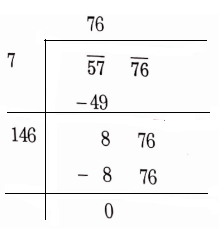
∴ \(\sqrt{5776}\)
= 76
8. 7921
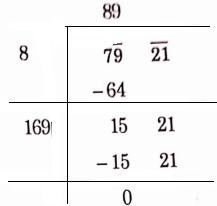
∴ \(\sqrt{7921}\)
= 89
9. 576

∴ \(\sqrt{7921}\)
= 89
10. 1024

∴ \(\sqrt{1024}\)
= 32
11. 3136

∴ \(\sqrt{3136}\)
= 56
12. 900
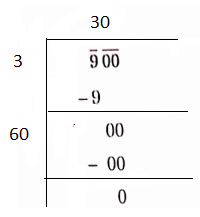
∴ \(\sqrt{900}\)
= 30
Class 8 Maths Chapter 5 NCERT book solutions
Question 2. Find the number of digits in the square root of each of the following numbers (without any calculation)
Solution:
1. Number (n) of digits in 64
= 2 which is even.
∴ Number of digits in the square root of 64 = \(\frac{n}{2}=\frac{2}{2}\)
= 1
2. Number (n) of digits in 144
= 3 which is odd.
∴ Number of digits in the square root of
144 = \(\frac{n+1}{2}=\frac{3+1}{2}\)
= \(\frac{4}{2}\)
= 2
3. Number (n) of digits in 4489
= 4 which is even.
∴Number of digits in the square root of
4489 = \(\frac{n}{2}=\frac{4}{2}\)
= 2
4. Number (n) of digits in 27225
= 5 which is odd.
∴ Number of digits in the square root of
27225 = \(\frac{n}{2}=\frac{6}{2}\)
= 3
= \(\frac{6}{2}\)
5. Number (n) of digits in 390625
= 6 which is even.
∴ Number of digits in the square root of
= \(\frac{n+1}{2}=\frac{5+1}{2}\) = \(\frac{6}{2}\)
= 3
Question 3. Find the square root of the following decimal number
Solution:
1. 2.56
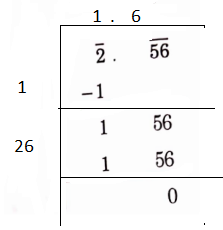
Hence, \(\sqrt{2.56}=1.6\)
2. 7.29
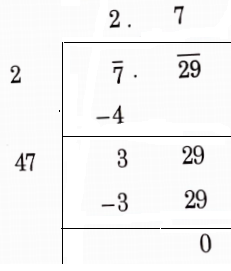
Hence, \(\sqrt{7.29}=2.7\)
3. 51.84
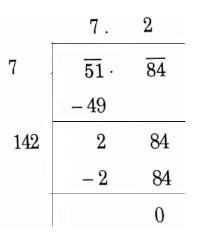
Hence, \(\sqrt{51.84}=7.2\)
4. 42.25
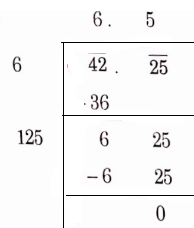
Hence, \(\sqrt{42.25}=6.5\)
5. 31.36

Hence, \(\sqrt{3136}=5.6\)
Question 4. Find the least number that must be subtracted from each of the following numbers to get a perfect square. Also, the square root of the perfect square so obtained
Solution:
1. We have 402
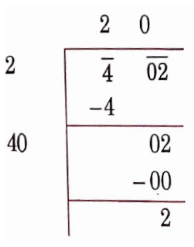
This shows that 20² is less than 40² by 2. This means, that if we subtract the remainder of 2 from the number, we get a perfect square. So, the required least number is 2.
∴The required perfect square is 402-2 = 40
Hence,\(\sqrt{400}\)=20.
2. We have 1989

This shows that 44² is less than 1989 by 53. This means that if we subtract the remainder of 53 from the number, we get a perfect square. So, the required least number is 53
∴The required perfect square is 1989 – 53 = 1936.
Hence, \(\sqrt{1936}\) = 44
3. We have,3250
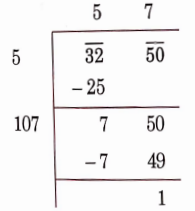
This shows that 57² is less than 3250 by
This means if we subtract the remainder (1) from the number, we get a perfect square. So, the required least number is 1.
∴ The required perfect square is
3250-1 = 3249
Hence, \(\sqrt{43249}\)= 57
4. We have, 825
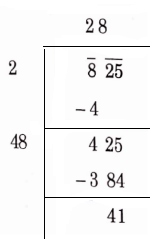
This shows that 28² is less than 825 by 41. This means if we subtract the remainder (41) from the number, we get a perfect square. So, the required least number is 41.
∴ The required perfect square is 825-41 = 784
Hence,\(\sqrt{784}\) = 28
5. We have, 4000
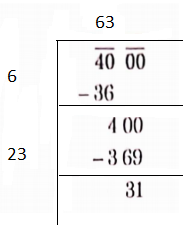
This shows that 63² is less than 4000 by 31
This means if we subtract the remainder (31) from the number, we get a perfect square. So, the required least number is 31.
∴ The required perfect square is 4000 – 31 = 3969
Hence, \(\sqrt{3969}\) = 63
CBSE class 8 chapter 5 squares and roots PDF
Question 5. Find the least number that must be added to each of the following numbers to get a perfect square. Also, find the square root of the perfect square to obtain
Solution:
1. We have 525
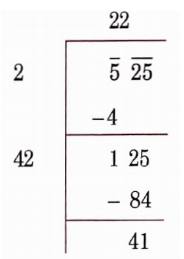
This shows that 22² < 525.
The next perfect square is 23² = 529.
Hence, the least number to be added is
23² – 525 = 529 – 525 = 4
∴ The perfect square so obtained is 525 + 4 = 529
Hence,\(\sqrt{529}\) = 23
2. We have 1750
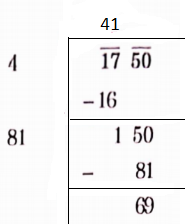
This shows that 41² < 1750.
The next perfect square is 42² = 1764.
Hence, the least number to be added is
42² – 1750 = 1764 – 1750
= 14
∴ The perfect square so obtained is 1750 + 14 = 1764
Hence \(\sqrt{1764}\)
= 42
3. We have, 252
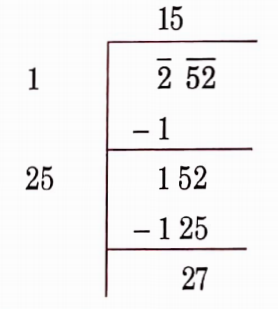
This shows that 15² < 252.
The next perfect square is 16² = 256.
Hence, the least number to be added is
16² – 252 = 256 – 252 = 4.
∴ The perfect square so obtained is 252 + 4 = 256
Hence \(\sqrt{256}\)
= 16
4. We have, 6412

This shows that 42² < 1825
The next perfect square is 43² = 1849.
Hence, the least number to be added is
43² – 1825 = 1849 – 1825
= 24.
Therefore, the perfect square so obtained is 1825 + 24 = 1849
Hence, \(\sqrt{1849}\)
= 43
5. We have 1825

This shows that 80² < 6412.
The next perfect square is 81² = 6561.
Hence, the least number to be added is
81² – 6412 = 6561 – 6412 = 149.
Therefore, the perfect square so obtained is 6412+ 149 = 6561
Hence,\(\sqrt{6561}\)
= 81
Question 6. Find the length of the side of a square whose area is 441 m.2.
Solution:
Area of the square = 441 m
Length of the side of the square
⇒ \(\sqrt{441}\)m
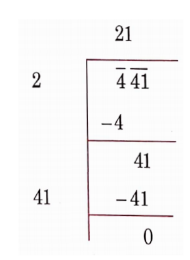
∴ \(\sqrt{441}\) = 21
Hence, the length ofthe side ofthe square is 21 m
Question 7. In a right triangle ABC, ∠B – 30°.
Solution:
1. In the right triangle ABC,
∠B = 90°
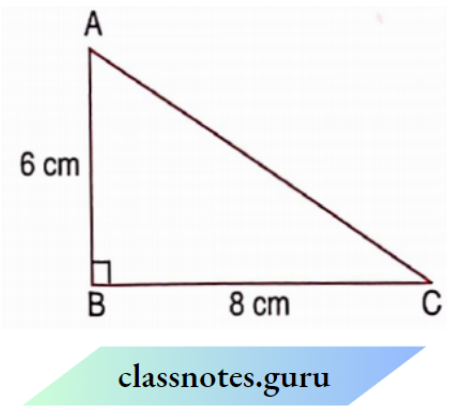
By Pythagoras Theorem
AC² = AB² + BC²
AC² = 6² + 8²
AC² = 36 + 64
AC² = 100
AC = \(\sqrt{100}\)
⇒ \(\sqrt{100}\) = 10
Hence, AC is equal to 10 cm.
In the right triangle ABC,
∠B = 90°
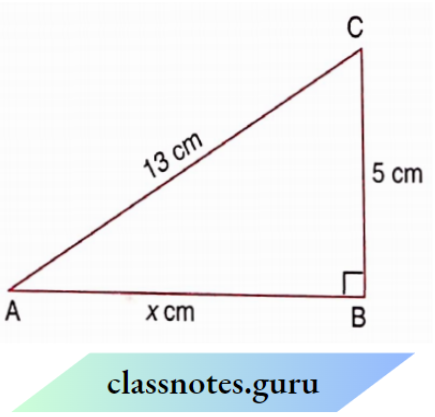
By Pythagoras Theorem,
AC² = AB² + BC²
13² = AB² + 5²
169 = AB² + 25
AB² = 169-25
AB² = 144
AB = \(\sqrt{144}\)
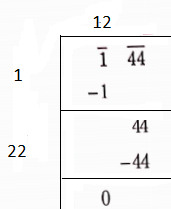
Therefore,= \(\sqrt{144}\) 12.
Hence, AB is equal to 12 cm
Question 8. A gardener has 1000 plants. He wants to plant these in such a way that the number of rows and the number of columns remain the same. Find the minimum number of plants he needs for this
Solution:
Let the number of rows be x. Then the number of columns is x. Let us find out the square root of1000 by the division method

This shows that 31² < 1000
32² = 1024.
Hence, the minimum number of plants needs more for this = 1024 – 1000 = 24
So, number of rows
= number of columns = 32
Class 8 maths chapter 5 mock test
Question 9. There are 500 children in a school. For a. P. T. drill they have to stand so that the number of rows is equal to several columns. How many children would be left out in this arrangement
Solution:
Let us find out the square root of the 500 division method.
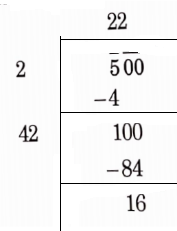
We get the remainder of 16. It shows that 222 is less than 500 by 16.
This means that 16 children would be left out of this arrangement
Question 1. The perfect, square number out of 2, 3, 4, and 5 is
Solution: 3. 4
4 = 2 × 2 = 2²
Question 2. A perfect square number between 30 and 40 is
Solution: 1. 36
36 = 6 × 6 = 6²
Question 3. Between 50 and 60, the perfect square number is
Solution: 4. None
None of 51,52,……59 is a perfect square
Question 4. Which ofthe following is a perfect square number?
Solution: 4. 625
Perfect square numbers end with 0, 1, 4, 5, 6, or 9 only at the unit’s place.
Question 5. Which ofthe following is a perfect square number?
Solution: 4. 10000
Perfect square numbers end with 0, 1, 4, 5, 6, or 9 only at the unit’s place.
6. Which of 132², 87², 72² and 209² would end with digit 1?
Solution: 4. 209²
If a number has 1 or 9 in the unit’s place, then its square ends in 1
Question 7. Which of 105², 216², 333² and 111² would end with the digit 1
Solution: 4. 111²
If a number has 1 or 9 in the unit’s place, then its square ends in 1
Question 8. Which of 17², 34², 25², and 49² would have 6 at unit place?
Solution: 2. 34²
If a number has 4 or 6 in the unit’s place, then its square ends in 6.
Question 9. Which of 21², 33², 47², and 36² would have 6 at unit place?
Solution: 4. 36²
If a number has 4 or 6 in the unit’s place, then its square ends in 6.
Question 10. What will be the number of zeros in the square of the number 100
Solution: 2. 4
Number of zeros at the end of the number 100 = 2
Number of zeros at the end of the square ofthe number 100 = 2 ×2 = 4
Question 11. What will be the number of zeros in the square of the number 50?
Solution: 2. 2
Number of zeros at the end ofthe number 50 = 1
Number of zeros at the end of the square of the number 50 = 2×1 = 2
Question 12. What will be the number of zeros in the square ofthe number 9000?
Solution: 4. 6
Number of zeros at the end ofthe number 9000 = 3
Number of zeros at the end of the square ofthe number 9000 = 2 × 3 = 6
Question 13. The square of which of the following numbers will be even?
Solution: 4. 112
∴ 112 is even 3.
∴ Its square will be even
Question 14. The square of which of the following numbers will be odd?
Solution: 4. 99
∴ 99 is odd
∴ Its square will be odd.
Question 15. The square of which of the following numbers will be even?
Solution: 4. 50
∴ 50 is even.
∴ Its square will be even.
Question 16. The square of which of the following numbers will be odd?
Solution: 4. 81
∴ 81 is odd
∴ Its square will be odd
Question 17. How many natural numbers is he between 8² and 9²
Solution: 1. 16
2 × 8 = 16
Class 8 maths chapter 5 solved examples
Question 18. How many natural authors lie between 12² and 13²?
Solution: 3. 24
2× 12 = 24
Question 19. How many nonsquare numbers lie between the pair of numbers 80² and
Solution: 2. 160
2 × 80 = 160
Question 20. How many nonsquare numbers lie between the pair of numbers 36² and 37²?
Solution: 4. 72
2 × 36 = 72
Question 21. How many nonsquare numbers lie between the pair of numbers 500² and 501²
Solution: 1. 1000
2 × 500=1000
Question 22. Express the square number 5² as the sum of two consecutive integers.
Solution: 1. 12+13
⇒ \(\frac{5^2-1}{2}=12, \quad \frac{5^2+1}{2}=13\)
Question 23. Express 9² as the sum of two consecutive integers.
Solution: 1. 40 + 41
⇒ \(\frac{9^2-1}{2}=40, \quad \frac{9^2+1}{2}=41\)
Question 24. Express 7² as the sum of two consecutive integers.
Solution: 2. 24+25
⇒ \(\frac{7^2-1}{2}=24, \quad \frac{7^2+1}{2}=25 .\)
Question 25. The unit digit in the square ofthe number 132 is
Solution: 4. 4
2 × 2 = 4
Question 26. The unit digit in the square ofthe number 1000 is
Solution: 2. 0
0 × 0 = 0
Question 27. The unit digit in the* square of the number 1111 is
Solution: 1. 1
1 × 1 = 1
Question 28. The unit digit in the square of the number 1333 is
Solution: 2. 6
3 × 3 = 9
Question 29. The unit digit in the square of the number 2644 is
Solution: 2. 6
4 × 4 = 1\(\underline{6}\)
Question 30. The unit digit in the square of the number 125 is
Solution: 3. 5
5 × 5 = 2 \(\underline{5}\)
Question 31. The unit digit in the square of the number 166 is
Solution: 3. 6
6 × 6 = 3\(\underline{6}\)
Question 32. The unit digit in the square of the number 27 is
Solution: 4. 9
7 × 7 =4 \(\underline{9}\)
Question 33. The unit digit in the square of number 78 is
Solution: 3. 3
8 × 8= 6\(\underline{4}\)
Question 34. The unit digit in the square of number 209 is
Solution: 1. 1
9× 9 = 8\(\underline{1}\)
Question 35. If 10² = 100, then the square root of 100 is
Solution: 2. 10
⇒ \(\sqrt{100}\) = 10
Question 36. If 25² = 625, (hen the square root of 625 is
Solution: 2. 26
⇒ \(\sqrt{625}\) = 25
Question 37. What could be the possible one-digit of the square root of 625?
Solution: 4. 5
5 × 5 = 25
Question 38. What could be the possible one-digit of the square root of 121?
Solution: 1. 1, 9
1 × 1 = 1
9 × 9 = \(1 \underline{81}\)
Question 39. What could be the possible one-digit of the square root of 361?
Solution: 1. 1, 9
1 × 1 = 1
9 × 9 = \(8 \underline{1}\)
Question 40. What could be the possible one-digit of the square root of 576?
Solution: 1. 1, 9
4 × 4 = \(1 \underline{6}\)
6 × 6 = \(1 \underline{36}\)
Question 41. What could be the possible one-digit of the square root of 676?
Solution: 1. 4, 6
4 × 4 = \(1 \underline{6}\)
6 × 6 = \(1 \underline{36}\)
Question 42. The smallest number by which 32 should be multiplied to get a perfect square is
Solution: 1. 2
32 × 2 = 64 = 8²
Question 43. The smallest number by which 48 should be multiplied to get a perfect square is
Solution: 2. 3
48 × 3 = 144 = 12²
Question 44. The smallest number by which 45 should be multiplied to get a perfect square is
Solution: 3. 5
45 × 5 = 225 = 15²
Question 45. The smallest number by which 54 should be multiplied so that we get a perfect square is
Solution: 1. 2
54 × 6 = 324 = 18²
Question 46. The smallest number by which 28 should be multiplied to get a perfect square is
Solution: 4. 7
28 × 7 = 196 = 14²
Question 47. The smallest number by which 1000 should be multiplied to get a perfect square is
Solution: 2. 10
1000 × 10 = 10000 = 100²
Question 48. The smallest number by which 128 should be divided to get a perfect square is
Solution: 1. 2
128 ÷ 2 = 64 = 8²
Question 49. The smallest number by which 48 should be divided to get a perfect square is
Solution: 2. 3
48 ÷ 3 = 16 = 4²
Question 50. The smallest number by which 125 should be divided so as to get a perfect square is
Solution: 2. 5
125 ÷ 5 = 25 = 5²
Question 51. The smallest number by which 150 should be divided so as to get a perfect square is
Solution: 4. 6
150 ÷ 6 = 25 = 5²
Question 52. The smallest number by which 112 should be divided so as to get a perfect square is
Solution: 4. 7
112 ÷ 7 = 16 = 4²
Question 53. The smallest number by which 1000 should be divided so as to get a perfect square is
Solution: 2. 10
1000 ÷ 10 = 100 = 10²
Question 54. The smallest 3-digit, perfect square is
Solution: 2. 100
100 = 10²
Question 55. The number of digits in the square root of 62500 is
Solution: 3. 3
n = 5, \(\frac{n+1}{2}=3\)
Question 56. The number of digits in the square root of 441 is
Solution: 2. 2
n = 3, \(\frac{n+1}{2}=2\)
Question 57. The number of digits in the square root of 100 is
Solution: 2. 2
n = 3, \(\frac{n+1}{2}=\) = 2
NCERT solutions for class 8 maths chapter 5
Question 58. Find the length of the side of a square whose area is 100 cm2.
Solution: 2. 10 cm
⇒ \(\sqrt{100}=10\)
Question 59. The students of class VIII of a school donated? 10000 in all, for the Prime Minister’s National Relief Fund. Each student donated as many rupees as the number of students in the class. The number of students in the class is
Solution: 2. 100
⇒ \(\sqrt{10000}=100\)
1. That sum of two perfect squares is a perfect square – False
2. The product of two perfect squares is a perfect square – True
3. 1000 is a perfect square – False
4. All numbers of a Pythagorean triplet are even – False
5. There is only one square number between 20 and 30 – True
1. 11² = 60 +→ 61
2. 112 + 113 =→ (15)²
3. There are non-square numbers between 42 and 52. → 8
4. The square of 1.1 is → 1.21
5. For every natural number m (> 1), 2m, m² – 1 and m² + 1 form a -Pythagorea
1. Write the greatest two-digit square number → 81
2. The smallest number of a Pythagorean triplet is 3. Find its other two numbers → 4,5
3. Which letter best represents the location of 716 on a number line → E

4. The area of a square board is 144 square units. Find the length of the side of the square board →12 units.
5. Find the value of \(\sqrt{17+\sqrt{64}}\) → 5
If a is any non-zero integer and n is a positive integer, then
x a (n times) is written as a”,
i.e., a” is the continued product of a multiplied by itself n times.
Here, ‘o’ is called the base, and V is called the ‘exponent’ or ‘index’.
The number a” is read as a raised to the power of or simply as ‘nth power of o’.
The notation a” is called the exponential or power notation.
We can write large numbers more conveniently using exponents.
For example :
10000 = 104; 243 = 35; 128 = 27, etc.
Now, we shall learn about negative exponents
Read and Learn More NCERT Solutions For Class 8 Maths
If a is any non-zero integer and m is a positive integer, then
⇒ \(a^{-m}=\frac{1}{a^m}\)
Note: a m is called the multiplicative inverse of am as a-m x am = 1
Am and a ~m are multiplicative inverses of each other.
Note 2: \(a^m=\frac{1}{a^{-m}}\)
Question: What is 10 ~10 equal to?
Solution: \(10^{-10}=\frac{1}{10^{10}}\)
NCERT solutions for class 8 maths chapter 10
Question 1. Find the multiplicative inverse of the following:
Solution:
The multiplicative inverse is \(2^{-4}=\left(\frac{1}{2^{-4}}\right) \text { is } 2^4\)
⇒ \(a^{-m}=\frac{1}{a^m}\)
The multiplicative inverse of \(10^{-5}=\left(\frac{1}{10^{-5}}\right) \text { is } 10^5\)
⇒ \(a^{-m}=\frac{1}{a^m}\)
The multiplicative inverse of \(7^{-2}=\left(\frac{1}{7^{-2}}\right) \text { is } 7^2\)
⇒ \(a^{-m}=\frac{1}{a^m}\)
The multiplicative inverse \(5^{-3}=\left(\frac{1}{5^{-3}}\right) \text { is } 5^3\)
⇒ \(a^{-m}=\frac{1}{a^m}\)
The multiplicative inverse\(10^{-100}=\left(\frac{1}{10^{-100}}\right) \text { is } 10^{100}\)
⇒ \(a^{-m}=\frac{1}{a^m}\)
Question 2. Expand the following numbers using exponents :
Solution:
1025.63
1 x 1000 + 0 x 100 + 2 x 10 + 5 x 1 + 6 x\(\frac{1}{10}+3 \times \frac{1}{100}\)
= 1 x 103 + 0 x 102 + 2 x 101 + 5 x 10° + 6 x 10-1 + 3 x 10-2
1256.249
= 1 x 1000 + 2 x 100 + 5 x 10
+ 6x 1+ 2 x \( \frac{1}{10}+4 \times \frac{1}{100}+9 \times \frac{1}{1000}\)
= 1 X 103 + 2 X 102 + 5 X 101 + 6 x 10° + 2 x 10-1 + 4 x 10-2 + 9 x lO-3
If a, b are non-zero integers and m, n are any integers, then
an” = 1 = n = 0
1n = 1 where n is any integer.
(- 1)n = 1 where n is any even integer.
(-1)n =-1 where n is any odd integer.
Q. Simplify and write in exponential form:
(-2)-3X (-2)-4
p3 x p -I0
32 x 3-5 x 36
Solution:
(-2)~3 x (-2)-4 = (- 2)(“3) + (-4>
am x an = am +n
= (-2)-7 = {(-1) x 2} -7
⇒ \(\frac{1}{\{(-1) \times 2\}^7}= \frac{1}{(-1)^7 \times(2)^7}\)
(ab)m = am bm
⇒ \(\frac{1}{(-1) \times 2^7}=-\frac{1}{2^7}\)
⇒ \(\mid(-1)^{\text {odd integer }}=-1\)
⇒ \(p^3 \times p^{-10}=p^{3+(-10)}=p^{-7}=\frac{1}{p^7}\)
⇒ \(a^{-m}=\frac{1}{a^m}\)
32 x 3-5 x 36 = 32 + (-5) + 6 = 33
Question 1. Evaluate:
Solution:
⇒ \(3^{-2}=\frac{1}{3^2}=\frac{1}{9}\)
⇒ \(a^{-m}=\frac{1}{a^m}\)
⇒ \((-4)^{-2}=\frac{1}{(-4)^2}=\frac{1}{16}\)
⇒ \(a^{-m}=\frac{1}{a^m}\)
⇒ \(\left(\frac{1}{2}\right)^{-5}=\left(\frac{2}{1}\right)^5\)
⇒ \( a^{-m}=\frac{1}{a^m}\)
⇒ \(\frac{2^5}{1^5}\)
⇒ \(\left(\frac{a}{b}\right)^m=\frac{a^m}{b^m}\)
⇒ \(\frac{32}{1}=32\)
1n = 1 where n is an integer
Exponents and powers class 8 solutions
Question 2. Simplify and express the result in power notation with a positive exponent
Solution:
1. (-4)6 ÷ (-4)8
⇒ \(\frac{(-4)^5}{(-4)^8}\)
⇒ \((-4)^{5-8}\)
⇒ \((-4)^{-3}\frac{a^m}{a^n}=a^{m-n}\)
⇒ \(=\frac{1}{(-4)^3} a^{-m}=\frac{1}{a^m}\)
which is the required form.
2. \(\left(\frac{1}{2^3}\right)^2 =\frac{1^2}{\left(2^3\right)^2}\)
⇒ \(\left(\frac{a}{b}\right)^m=\frac{a^m}{b^m}\)
⇒ \(\frac{1}{2^{3 \times 2}} \)
⇒ \( \mid\left(a^m\right)^n=a^m\)
⇒ \(\frac{1}{2^6}\)
which is the required form
3. \((-3)^4 \times\left(\frac{5}{3}\right)^4=\{(-1) \times 3\}^4 \times \frac{5^4}{3^4} \)
⇒ \(\left(\frac{a}{b}\right)^m=\frac{a^m}{b^m}\)
⇒ \((-1)^4(3)^4 \times \frac{5^4}{3^4}\)
I (ab)m = am bm
= (- 1)4 x 54
= 1 x 54
(-1) even integer = 1
= 54
which is the required form.
4. (3-7 / 3-10) x 3-5
⇒ \(=\frac{3^{-7}}{3^{-10}} \times \frac{1}{3^5}\)
⇒ \( a^{-m}=\frac{1}{a^m}\)
⇒ \(3^{-7-(-10)} \times \frac{1}{3^5}\)
⇒ \(\frac{a^m}{a^n}=a^{m-n}\)
⇒ \(3^3 \times \frac{1}{3^5} \)
⇒ \(\frac{a^m}{a^n}=a^{m-n}\)
⇒ \(3^{3-5} \)
⇒ \(3^{-2} \)
⇒ \(a^{-m}=\frac{1}{a^m}\)
which is the required form.
5. \(2^{-3} \times(-7)^{-3}\)
⇒ \(\frac{1}{2^3} \times \frac{1}{(-7)^3}\)
⇒ \(\frac{1}{[2 \times(-7)]^3}=\frac{1}{a^m}\)
(ab)m = amb
⇒ \(\frac{1}{(-14)^3}\)
which is the required form.
Question 3. Find the value of:
(3° + 4 -1) x 22
(2-1 x 4-1)/2 -2
⇒ \(\left(\frac{1}{2}\right)^{-2}+\left(\frac{1}{3}\right)^{-2}+\left(\frac{1}{4}\right)^{-2}\)
⇒ \(\left(3^{-1}+4^{-1}+5^{-1}\right)^0\)
⇒ \(\left\{\left(\frac{-2}{3}\right)^{-2}\right\}^2.\)
Solution:
1. (3° + 4-1) x 22
⇒ \(\left(1+\frac{1}{4}\right) \times 4\)
⇒ \(a^{-m}=\frac{1}{a^m}, \quad a^0=1\)
⇒ \(\frac{5}{4} \times 4=5\)
(2-1 x 4-1) + 2″2
= {2 -l x (22)-1} + 2 -2
= {2-1 x 22x(-1>} -f2-2
(am)n = amn
= (2-’X2-2)T2-2 = 2(-1)+(-2) 2-2
am x a” = am+”
= 2-3 4- 2″2
⇒ \(\frac{2^{-3}}{2^{-2}}=2^{-3-(-2)} \)
⇒ \(\frac{a^m}{a^n}=a^{m-n}\)
⇒ \(2^{-1}\)
⇒ \(a^{-m}=\frac{1}{a^m}\)
⇒ \(\frac{1}{2}\)
3.\(\left(\frac{1}{2}\right)^{-2}+\left(\frac{1}{3}\right)^{-2}+\left(\frac{1}{4}\right)^{-2}\)
⇒ \(\frac{1^{-2}}{2^{-2}}+\frac{1^{-2}}{3^{-2}}+\frac{1^{-2}}{4^{-2}}\)
⇒ \(\left(\frac{a}{b}\right)^m=\frac{a^m}{b^m}\)
⇒ \(\frac{2^2}{1^2}+\frac{3^2}{1^2}+\frac{4^2}{1^2}\)
⇒ \(\frac{4}{1}+\frac{9}{1}+\frac{16}{1}\)
= 4 + 9 + 16 = 29
4. [3-1 + 4-1 + 5-1]0
⇒ \({\left[\frac{1}{3}+\frac{1}{4}+\frac{1}{5}\right]^0 }\)
⇒ \(\left(\frac{20+15+12}{60}\right)^0\)
⇒ \(\quad \text { | LCM }(3,4,5)=60\)
⇒ \(\left(\frac{47}{60}\right)^0=1\)
\(a^0=1\)Aliter
(3-1 + 4-1 +5-1)° = 1
a°= 1
5. \(\left\{\left(\frac{-2}{3}\right)^{-2}\right\}^2\)
⇒ \(\left(\frac{-2}{3}\right)^{(-2) \times 2}\)
⇒ \(\mid\left(a^m\right)^n=a^{m n}\)
⇒ \(\left(\frac{-2}{3}\right)^{-4}\)
⇒ \(\left(\frac{3}{-2}\right)^4 \)
⇒ \( \left(\frac{a}{b}\right)^{-m}=\left(\frac{b}{a}\right)^m\)
⇒ \(\frac{3^4}{(-2)^4}=\frac{3^4}{(-1 \times 2)^4}\)
⇒ \(\left(\frac{a}{b}\right)^m=\frac{a^m}{b^m}\)
⇒ \(\frac{3^4}{(-1)^4(2)^4}\)
⇒ \((a b)^m=a^m b^m\)
⇒ \(\frac{3^4}{1 \times 2^4} \)
⇒ \((-1)^{\text {even integer }}=1\)
⇒ \(\frac{3^4}{2^4}\)
⇒ \(\frac{3 \times 3 \times 3 \times 3}{2 \times 2 \times 2 \times 2}=\frac{81}{16}\)
Class 8 maths chapter 10 question answer
Question 4. Evaluate:
Solution:
1. \(\frac{8^{-1} \times 5^3}{2^{-4}}\)
⇒ \(\frac{2^4 \times 5^3}{8^1}\)
⇒ \(a^{-m}=\frac{1}{a^m}\)
⇒ \(\frac{16 \times 125}{8}=250\)
2. \(\left(5^{-1} \times 2^{-1}\right) \times 6^{-1}=\left(\frac{1}{5} \times \frac{1}{2}\right) \times \frac{1}{6}\)
⇒ \(a^{-m}=\frac{1}{a^m}\)
⇒ \(\frac{1}{10} \times \frac{1}{6}=\frac{1}{60}\)
Question 5. Find the value of m for which 5m + 5-3 = 55
Solution:
5m + 5-3 = 55
⇒ \(\frac{5^m}{5^{-3}} =5^5\)
⇒ \(5^{m-(-3)} =5^5\)
⇒ \(\frac{a^m}{a^n}=a^{m-n}\)
⇒ \(5^{m+3} =5^5\)
bases are equal exponents are equal
m + 3 = 5
m = 5-3
m = 2
Question 6. Evaluate:
Solution:
⇒ \(\left\{\left(\frac{1}{3}\right)^{-1}-\left(\frac{1}{4}\right)^{-1}\right\}^{-1}\)
⇒ \(\left(\frac{1^{-1}}{3^{-1}}-\frac{1^{-1}}{4^{-1}}\right)^{-1}\)
⇒ \(\left(\frac{a}{b}\right)^m=\frac{a^m}{b^m}\)
⇒ \(\left\{\frac{\frac{1}{1^1}}{\frac{1}{3^1}}-\frac{\frac{1}{1^1}}{\frac{1}{4^1}}\right\}^{-1}\)
⇒ \(a^{-m}=\frac{1}{a^m}\)
⇒ \(\left(\frac{3^1}{1^1}-\frac{4^1}{1^1}\right)^{-1}\)
⇒ \(a^1=a\)
⇒ \(\left(\frac{3}{1}-\frac{4}{1}\right)^{-1}\)
⇒ \( (3-4)^{-1}\)
⇒ \((-1)^{-1}=\frac{1}{(-1)^1}\)
⇒ \(| a^{-m}=\frac{1}{a^m}\)
⇒ \(\frac{1}{(-1)}\)
\((-1)^{\text {odd integer }}=-1\)= -1
⇒ \(\left(\frac{5}{8}\right)^{-7} \times\left(\frac{8}{5}\right)^{-4}=\frac{5^{-7}}{8^{-7}} \times \frac{8^{-4}}{5^{-4}}\)
⇒ \(\frac{5^{-7}}{5^{-4}} \times \frac{8^{-4}}{8^{-7}}\)
⇒ \(=5^{(-7)-(-4)} \times 8^m=\frac{a^m}{b^m}\)
⇒ \(\frac{a^m}{a^n}=a^{m-n}\)
⇒ \(5^{-7+4} \times 8^{-4}+7 \)
⇒ \(\frac{1}{5^3} \times 8^3=\frac{8^3}{5^3}\)
⇒ \(\frac{8 \times 8 \times 8}{5 \times 5 \times 5}=\frac{512}{125}\)
Question 7. Simplify:
Solution:
1. \(\frac{25 \times t^{-4}}{5^{-3} \times 10 \times t^{-8}}\)
⇒ \(\frac{25 \times 5^3}{10} \times \frac{t^8}{t^4}\)
⇒ \(\frac{625}{2} \times \frac{t^8}{t^4}\)
⇒ \(\frac{625 t^4}{2}\)
⇒ \(\frac{3^{-5} \times 10^{-5} \times 125}{5^{-7} \times 6^{-5}}\)
⇒ \(\frac{3^{-5} \times(2 \times 5)^{-5} \times(5 \times 5 \times 5)}{5^{-7} \times(2 \times 3)^{-5}}\)
⇒ \(\frac{3^{-5} \times 2^{-5} \times 5^{-5} \times 5^3}{5^{-7} \times 2^{-5} \times 3^{-5}} \)
⇒ \(\quad(a b)^m=a^m b^m\)
⇒ \(\frac{5^{-5} \times 5^3}{5^{-7}}=\frac{5^{(-5)+3}}{5^{-7}}\)
⇒ \(\mid a^m \times a^n=a^{m+n}\)
⇒ \(\frac{5^{-2}}{5^{-7}}=5^{(-2)-(-7)}\)
⇒ \(5^{-2+7}=5^5\)
A number is said to be in standard form if expressed in the form K x 10″ where 1 < K < 10 and n is an integer. A number written in standard form is said to be expressed in scientific notation.
Tiny numbers can be expressed in standard form using negative exponents.
1. To express a large number, we move the decimal point to the left such that only one digit is left to the left side of the decimal point and multiply the resulting number by 10n where n is the number of places to which the decimal point has been moved to the left.
For example : 270,000,000,000 = 2.7 x 1011
(Decimal point has have been moved to the left for11 places)
2. To express a number (< 1), we move the decimal point to the right such that only one digit is left to the left side of the decimal point and multiply the resulting number by 10~’1 where n is the number of places to which the decimal point has been shifted to the right.
For example : 0.000 0009 = 9 x 10-7
(Decimal point has have been shifted to the right for 7 places.)
Question 1. Identify huge and very small numbers from the above facts and write them in the following table:
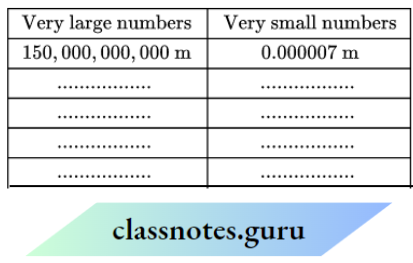
Solution:
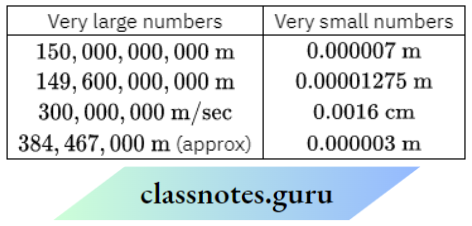
Question 2. Write the following numbers in standard form:
Solution:
1. 0.000000564
= 5.64 x 10-7
Moving decimal 7 places to the right
2. 0.0000021
0.0000021 = 2.1 x 10-6
Moving decimal 6 places to the right
3. 21600000
21600000 = 2.16 x 107
Moving decimal 7 places to the left
4. 15240000
15240000 = 1.524 x 107
Moving decimal 7 places to the left
Question 2. Write all the facts given in the standard form.
Solution:
(1) The distance from the Earth to the Sun is 1.496 x 1011 m
149, 600,000,000 = 1.496 x 1011.
Moving the decimal 11 places to the left
(2) The speed of light is 3 x 108 m/sec.
300, 000, 000 = 3 x108.
Moving decimal 8 places to the left
The thickness of the Class VII Mathematics book is 2 x 101 mm.
20 = 2 x 10 = 2 x 101
The average diameter of a Red Blood Cell is 7 x 10 6 mm.
0.00 0007 = 7 x 10-6
Moving decimal 6 places to the right
The thickness of human hair is in the range of 5 x 10 -3 cm to 1 x I0″2cm
⇒ \(0.005=\frac{5}{1000}=\frac{5}{10^3}=5 \times 10^{-3}\)
⇒ \(a^{-m}=\frac{1}{a^m}\)
⇒ \(0.01=\frac{1}{100}=\frac{1}{10^2}=1 \times 10^{-2}\)
The distance of the moon from the Earth is 3.84467 x 108m
384,467,000 = 3.84467 x 108
I Moved the decimal 8 places to the left
(7) The size of a plant cell is 1.275 x 10-5m
0.00001275 = 1.275 x 105
Moving decimal 5 places to the right
The average radius of the Sun is 6.95 x105km
695000 = 695 x 1000 = 695 x 103 = 6.95 x 105
(9) Mass of fuel in a space shuttle
solid rocket booster is 5.036 x 105 kg
503600
= 5036 x 100 = 5036 x 102
= 5.036 x 103 x 102
= 5.036 x 103+2
am x an = am+n
= 5.036 x 105
(10) Thickness of a piece of paper is 1.6 x10-3 cm
0.0016 = 1.6 x 10-3
Moving decimal 3 places to the right
The diameter of wire on a computer chip is 3 x 10-6 m
is 3 x 10-6
0.000003 = 3 x 013
Moving decimal 6 places to the right
(12) The height of Mount Everest is 8.848 x 103 m.
8848 = 8.848 x 1000 = 8.848 x 103
Class 8 chapter 10 exponents and powers
Question 1. Express the following numbers in standard form:
Solution:
1. 0.0000000000085
0.0000000000085 = 8.5 x 10-12
Moving the decimal 12 places to the right
2. 0.00000000000942
0.00000000000942 = 9.42 x 10-15
Moving the decimal 12 places to the right
3. 6020000000000000
6020000000000000 = 6.02 x 1015
Moving the decimal 15 places to the left
4. 0.00000000837
0.00000000837 = 8.37 x 10-9
Moving decimal 9 places to the right
5. 31860000000
31860000000 = 3.186 x 1010
Moving decimal 10 places to the left
Question 2. Express the following numbers in the usual form:
Solution:
⇒ \(3 \times 10^{-8}=\frac{3}{10^8}\)
⇒ \(a^{-m}=\frac{1}{a^m}\)
⇒ \(=\frac{3.02}{1000000}\)
⇒ 0.00000302
2. 4.5 x 104 = 4.5 x 10000 = 45000
3. \(3.02 \times 10^{-6}=\frac{3.02}{10^6}\)
⇒ \(a^{-m}=\frac{1}{a^m}\)
⇒ \(\frac{3}{100000000}\)
=0.00000003
4. 1.0001 X 109
= 1.0001 X 1000,000,000
= 1,000,100,000
5. 5.8 X 1012
= 5.8 X 1,000,000,000,000
= 5,800,000,000,000
6. 3.61492 x 106
= 3.61492 x 1,000,000
= 3,614,920
Question 3. Express the number appearing in the following statements in standard form:
Solution:
1. \(\frac{1}{1000000} \mathrm{~m}= \frac{1}{10^6}\)
⇒ \(1 \times 10^{-6} \mathrm{~m}\)
⇒ \(a^{-m}=\frac{1}{a^m}\)
which is the required standard form.
2. 0.000,000,000,000,000,000,16 coulomb
⇒ \(\frac{16}{100,000,000,000,000,000,000} \text { coulomb }\)
⇒ \(frac{16}{10^{20}} \text { coulomb }\)
⇒ \(\frac{1.6 \times 10}{10^{20}} \text { coulomb }\)
⇒ \(\frac{1.6 \times 10^1}{10^{20}} \text { coulomb } \quad \mid a^1=a\)
⇒ \(1.6 \times 10^{1-20} \text { coulomb } \frac{a^m}{a^n}=a^{m-n}\)
⇒ \(1.6 \times 10^{-19} \text { coulomb }\)
which is the required standard form.
3. 0.0000005 m
⇒ \(\frac{5}{10000000} \mathrm{~m} \)
⇒ \(\frac{5}{10^7} \mathrm{~m}\)
⇒ \(5 \times 10^{-7} \mathrm{~m}\)
which is the required standard form.
4. \(0.00001275 \mathrm{~m} =\frac{1275}{100,000,000} \mathrm{~m}\)
⇒ \(\frac{1275}{10^8} \mathrm{~m}\)
⇒ \(\frac{1275}{10^3 \times 10^5} \mathrm{~m}\)
| am x a” = am + n
⇒ \(\frac{1275}{10^3} \times 10^{-5} \mathrm{~m}\)
⇒ \(a^{-m}=\frac{1}{a^m}\)
⇒ \(1.275 \times 10^{-5} \mathrm{~m}\)
which is the required standard form.
5. \( 0.07 \mathrm{~mm} =\frac{7}{100}\)
⇒ \(\frac{7}{10^2}=7 \times 10^{-2} \mathrm{~mm}\)
⇒ \(a^{-m}=\frac{1}{a^m}\)
which is the required standard form
NCERT class 8 maths chapter 10 solutions PDF
Question 4. In a stack, there are 5 books each of thickness 20 mm, and 5 paper sheets each of thickness 0. 016mm. What is the total thickness of the stack?
Solution:
Total thickness of books = 5 x 20 mm = 100 mm
Total thickness of paper sheets = 5 x 0.016 mm = 0.080 mm
Total thickness of the stack
= Total thickness of books + Total thickness of paper sheets
= 100 mm + 0.080 mm
= (100 + 0.080) mm
= 100.080 mm
= 1.0008 x 102 mm.
Moving decimal 2 places to the left
Hence, the total thickness of the stack is 1.0008 x IQ2 mm.
Question 1. am x an is equal to
Solution: 1. am+n
Question 2. am ÷ am is equal to
Solution: 1. am+n
Question 3. (am)is equal to
Solution: 3. amn
Question 4. Am x is equal to
Solution: 1. (ab)m
Question 5. a0 is equal to
Solution: 2. 1
Question 6. \(\frac{a^m}{b^m}\) is equal to
Solution: 1. \(\left(\frac{a}{b}\right)^m\)
Question 7. 2 x 2 x 2 x 2 x 2 is equal to
Solution: 4. 25
Question 8. In 102, the exponents
Solution: 2. 2
Question 9. In 102, the base is
Solution: 3. \(\frac{1}{10}\)
Exponents and powers class 8 extra questions
Question 10. 10-1 is equal to
Solution: 3. \(\frac{1}{10}\)
Question 11. The multiplicative inverse of 2-3 is
Solution: 4. 23
Question 12. The multiplicative inverse of 105 is
Solution: 3. 10-5
Question 13. The multiplicative inverse of \( \frac{1}{2^2}\)
Solution: 2. 22
Question 14. The multiplicative inverse of 10 “10 is
Solution: 4. 1010
Question 15. The multiplicative inverse of am is
Solution: 5. a-m
Question 16. 53 x 5-1 is equal to
Solution: 4. 52
Question 17. (-2)5 x (- 2)6 is equal to
Solution: 2. -2
Question 18. 32 x 3-4 x 35 is equal to
Solution: 3. 33
19. (- 2) 2 is equal to
Solution: 1. \(\frac{1}{4}\)
Question 20. \(\left(\frac{1}{2}\right)^{-4}\) is equal to
Solution: 2. 24
Class 8 maths exponents and powers worksheet
Question 21. (20 + 4-1) x 22 is equal to
Solution: 4. 5
Question 22. (2-1 + 3-1 + 5-1)0 is equal to
Solution: 4. 1
Question 23. 3m÷ 3-3 = 35 ⇒ m is equal to
Solution: 2. 2
Question 24. (-2)m+1 x (-2)4 = (- 2)6 ⇒ m =
Solution: 2. 1
Question 25. (-1)60 is equal to
Solution: 2. 1
Question 26. (-1)51 is equal to
Solution: 1. -1
Question 27. 149600000000 is equal to
Solution: 1. 1.496 x 1011
Question 28. 300000000 is equal to
Solution: 1. 3 x 108
Question 29. 0.000007 is equal to
Solution: 1. 7 x 10-6
NCERT maths class 8 chapter 10 explanation
Question 30. 384467000 is equal to
Solution: 1. 3.84467 x 108
Question 31. 0.00001275 is equal to
Solution: 1. 1.275 x 10-6
Question 32. 695000 is equal to
Solution: 1. 6.95 x 105
Question 33. 503600 is equal to
Solution: 1. 5.036 x 105
Question 34. 0.0016is equal to
Solution: 1. 1.6 x 10-3
Question 35. 0.000003 is equal to
Solution: 1. 3 x 10-6
Question 36. 8848 is equal to
Solution: 1. 8.848 x 103
Question 37. 1.5 x 1011 is equal to
Solution: 1. 150000000000
Question 38. 2.1 x 10-6 is equal to
Solution: 1. 0.0000021
Exponents and powers class 8 important questions
Question 39. 2.5 x 104 is equal to
Solution: 4. 25000
Question 40. 0.07 x 1O10is equal to
Solution: 1. 700000000
Write whether the following statements are True or False:
1. The value of \(\left\{(-1)^{-1}\right\}^{-1}\) is 1: False
2. The reciprocal of \(\left(\frac{4}{3}\right)^0\) is 1: True
3. The standard form of \(\frac{1}{1000000}\) is 1.0 x 10 -6: True
4. If 6m + 6 “3 = 66, then the value of m is 3: True
5. 2345.6 = 2 x 1000 + 3 x 100 + 4 x 10 + 5 x 1 + 6 x 10 – 1: True
Class 8 maths chapter 10 solved exercises
1. (1000)° = 1
2. The standard form of 1,234,500,000,000 is: 1.2345 x 1012
3. The multiplicative inverse of(-3) ~2 is: (-3)2
4. (- 9)4 -5- (- 9)10 is equal to (-9)-6
5. The value of (2 -1 + 3 -1 + 4 -1)° is : 1
6. Write 1.0002 x 109 in the usual form: 1000200000
7. Write the reciprocal of 10 _1: 10
8. Find the value of*if* “3 = (100)1-4 + (100)°: 100
9. By what number should (-8) -1 be divided, so that the quotient may be equal to (-8) -1: 1
10. If = \(\frac{5^m \times 5^2 \times 5^{-3}}{5^{-5}}=5^4\) then find the value of m: 0
The information collected in the form of numbers in the context of a situation under study is called data.
For example :
Marks obtained by the students of your class in the monthly test in English, weights of students of your class, etc.
We systematically organise the data and then interpret it.
Sometimes, we represent the data graphically to get a clear idea of what it represents.
Question 1. A pictograph
It is a pictorial representation of data using symbols
Read and Learn More NCERT Solutions For Class 8 Maths
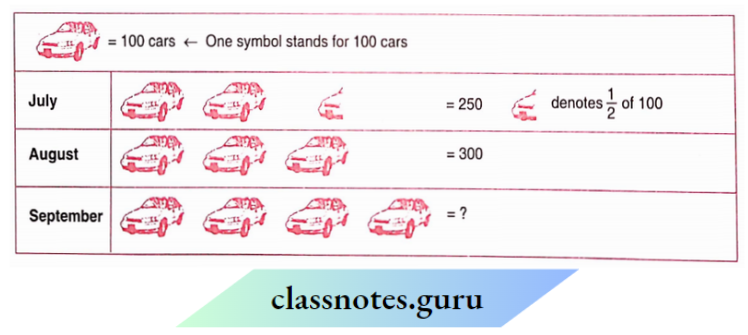
1. How many cars were produced in July?
Solution:
250 cars were produced in July
2. In which month was the maximum number of cars produced?
Solution:
The maximum number (= 400) was produced in September
Question 2. A bar graph
It is a display of information using bars of uniform width, with equal gaps in between. Their heights are proportional to the respective values.
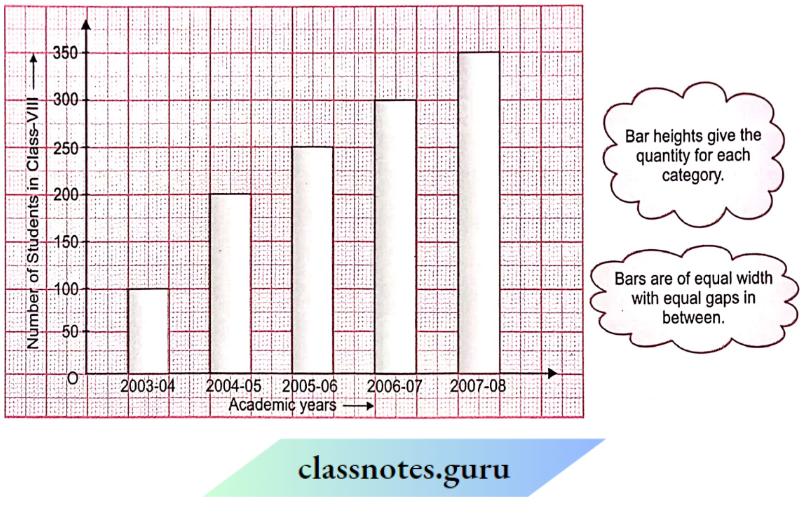
‘The number of students during 2005-2006 is twice that of 2003-04’.
Solution:
1. The bar graph gives information about the number of students in class VIII in various academic years in the school.
2. Increase in the number of students in
2004 – 05 = 200 – 100 = 100
Increase in the number of students in
2005- 06 = 250 – 200 = 50
Increase in the number of students in
2006-07 = 300 – 250 = 50
Increase in the number of students in
2007-08 = 350 – 300 = 50
Hence, the increase in the number of X students is maximum in the year 2004-2005.
3. The number of students is maximum in the year 2007-08.
4. The number of students during
2005-06 = 250
The number of students during
2003-04 = 100
Twice the number of students during
2003-04 = 2 xl00 = 200* 250
( = The number of students during 2005- 06)
Since the number of students during 2005-06 is not twice that of 2003-04, therefore the given statement is false.
Question 3. Double bar graph
Bar graph allowing Iwo sola of data simultaneously. It is useful for the comparison of the data.
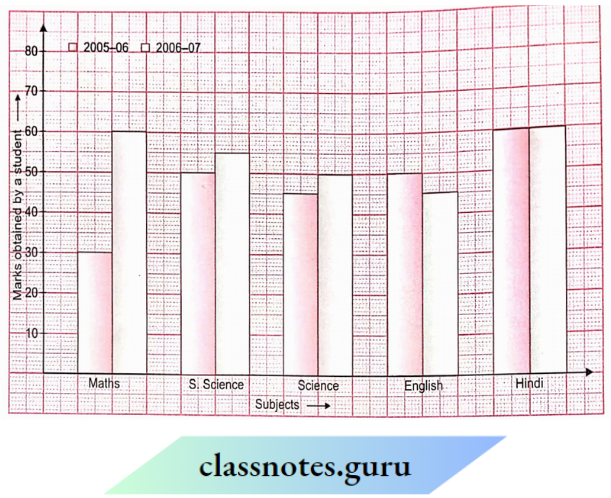
Solution:
1. The double bar graph gives information about the marks obtained by a student in different subjects in the academic years 2005-06 and 2006-07.
2. The performance has improved the most in the subject of Mathematics.
3. The performance has deteriorated in the subject of English.
4. The performance is at par in the subject of Hindi
Question 4. If we change the position of any of the bars of a bar graph, would it change the information being conveyed? Why
Solution:
No, because bar heights give the quantity for each category. Since by changing the position of any of the bars of a bar graph, the height of the bar remains unchanged, the information conveyed regarding the quantity remains unchanged
Question 5. Draw an appropriate graph to represent the given information.

Solution:
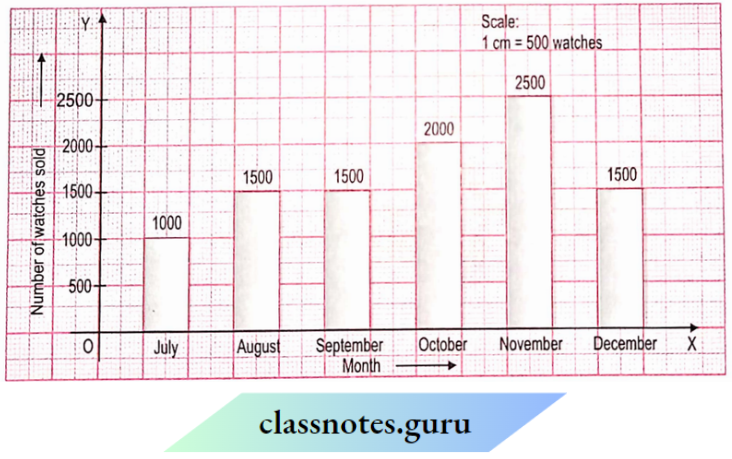
Question 6.
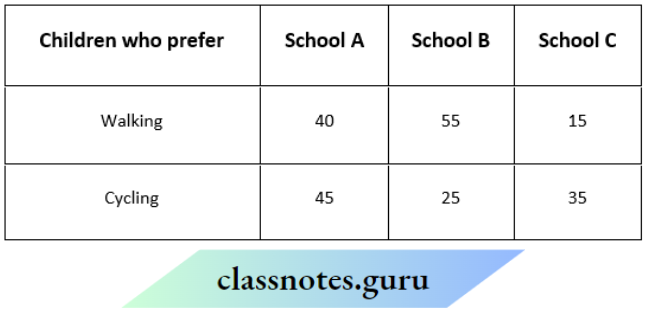
Solution:
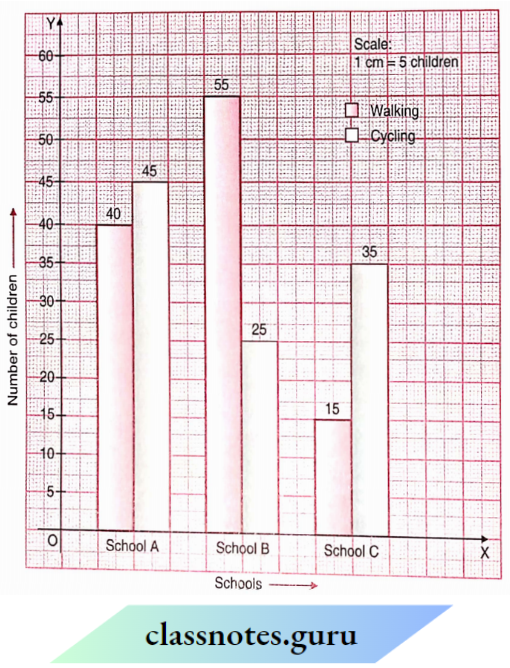
Question 7. Percentage wins in ODI by 8 top cricket teams

Solution:

A circle graph shows the relationship between a whole and its parts. We divide the whole circle into various sectors. The size of each sector is proportional to the information or activity it represents.
Question 8. Each of the following pie charts gives you a different piece of information about your class. Find the fraction ofthe circle representing each of these information
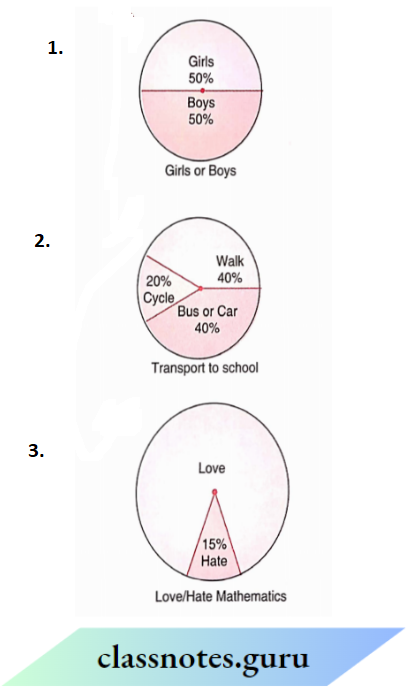
Solution:
1. Fraction of the circle representing the ‘girls’
= \(\frac{\text { Percentage of girls }}{\text { Percentage of all students }}\)
= \(\frac{50}{100}=\frac{1}{2}\)
Dividing the numerator and denominator by 50 [= HCF (50, 100)]
Fraction of the circle representing the boys
= \(\frac{\text { Percentage of boys }}{\text { Percentage of all students }}\)
= \(\frac{50}{100}=\frac{1}{2}\)
2. Fraction of the circle representing walk
= \(\frac{\text { Percentage of walk }}{\text { Total percentage of transport }} \)
= \(\frac{40}{100}=\frac{2}{5}\)
Dividing the numerator and denominator by 20 [= HCF (40, 100)]
Fraction ofthe circle representing‘cycle’
= \(\frac{\text { Percentage of cycle }}{\text { Total percentage of transport }} \)
= \(\frac{20}{100}=\frac{1}{5}\)
Fraction of the circle representing (Bus or car)
= \(\frac{\text { Percentage of Bus or } \mathrm{Car}}{\text { Total percentage of transport }}\)
= \(\frac{40}{100}=\frac{2}{5}\)
Dividing the numerator and denominator by 20 [= HCF (40, 100)]
3. The fraction of the circle represents those who hate Mathematic
= \(\frac{\text { Percentage of students who hate Mathematics }}{\text { Percentage of all students }}\)
= \(\frac{15}{100}=\frac{3}{20}\)
Dividing the numerator and denominator by 20
[= HCF (40, 100)]
Dividing the numerator and denominator by 5
[= HCF (15, 100)
The fraction ofthe circle representing those who whose Mathematic
= \(\frac{\begin{array}{c}
\text { Percentage of those who love Mathematics } \\
\end{array}}{\text { Percentage of all students }}\)
= \(\frac{100-15}{100}\)
= \(\frac{85}{100}=\frac{17}{20}\)
Question 9. Answer the following questions based on the pie chart given

Solution:
From the given pie chart, we prepare the following table

1. Since the percentage of entertainment viewers is the highest, therefore, entertainment programmes are viewed the most.
2. Percentage of viewers watching the news
= 15% r
Percentage of viewers watching X informative = 10%
∴ Some of the percentages of viewers watching news and informative
= (15 + 10)% = 25%
= Percentage of viewers watching spo ts
Hence, news and information programmes have many viewers equal m those watching sports channels.
The total angle at the centre of a circle is 360°. The central angles of sectors are fractions of 360°.
The central angle of a sector
= \(\left(\frac{\text { Value of the component represented by the sector }}{\text { Sum of the values of all the components }} \times 360^{\circ}\right)\)
Question 1. Draw a pie chart of the data given below. The time spent, by a child during a day.
Solution:

Now, we make the pie chart pie chart
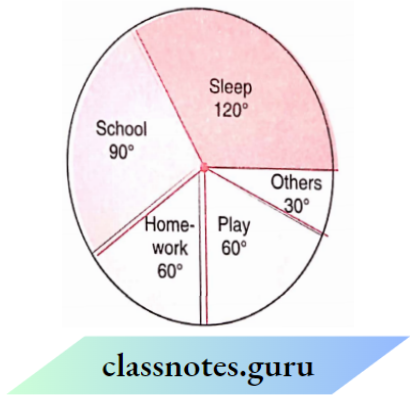
Question 1. A survey was made to find the type of music Il\al a certain group of young people liked in a city. The adjoining pie chart shows the findings of this survey
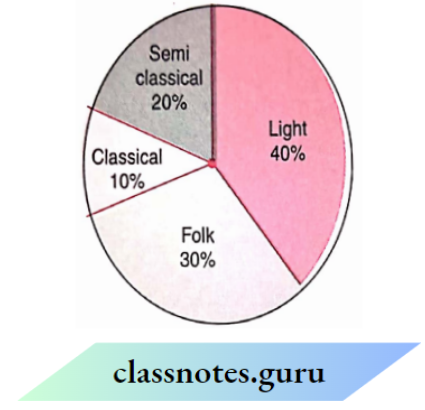
Solution:
1. Suppose that x young people were surveyed. Then, the number of young people who liked classical music = 10% of x
= \(\frac{10}{100} \times x=\frac{x}{10}\)
According to the question
⇒ \(\frac{x}{10}=20\)
x = 20 × 10
Multiplying both sides by 10
X = 200
Hence 200 young people were surveyed
2. Since the percentage of young people who liked light music is the highest, therefore, light music is liked by the maximum number of people
3. Total number of CD’s = 1000
Number of CD’s of semi-classical music
= 20% of 1000
= \(\frac{20}{100} \times 1000\)
= 200
Number of CDs of classical music 10% of 1000
= \(\frac{10}{100} \times 1000\)
=100
Number of CD’s of folk music
= 30% of 1000
= \(\frac{30}{100} \times 1000\)
= 300
Number of CDs of light music
= 40% of 1000
= \(\frac{40}{100} \times 1000\)
= 400
Question 2. A group of 360 people were asked to vote for their favourite season from the h “ee Semi seasons rainy, winter and summer.

Solution:
1. Since the no. of votes corresponding to the winter season is the maximum, therefore, winter season got the most votes.
2. Total votes = 90+ 120+ 150 = 360.
The central angle of the sector corresponds to the summer season
= \(\frac{\begin{array}{c}\text { Number of people who vote for summer season } \\\end{array}}{\text { Total number of people }} \times 360^{\circ} \)
= \(\frac{90}{360} \times 360^{\circ}=90^{\circ}\)
The central angle of the sector corresponds to the rainy season
= \(\frac{\begin{array}{c}\text { Number of people who vote for rainy season } \\\end{array}}{\text { Total number of people }} \times 360^{\circ}\)
= \(\frac{120}{360} \times 360^{\circ}=120^{\circ}\)
The central angle of the sector corresponding to the winter season
= \(\frac{\begin{array}{c}\text { Number of people who vote for winter season } \\\end{array}}{\text { Total number of people }} \times 360^{\circ}\)
= \(\frac{150}{360} \times 360^{\circ}=150^{\circ}\)
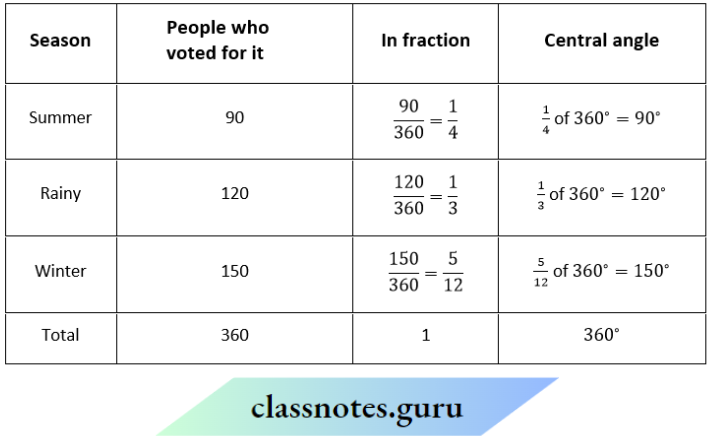
Pie Chart

Question 3. Draw a pie chart showing the following information. The table shows the colours Preferred by a group of people

Find the proportion of each sector. For example,
Blue is – \(\frac{18}{36}=\frac{1}{2}\)
Green – \(\frac{9}{36}=\frac{1}{4}\) and so on
Use this to find the corresponding and
Solution:
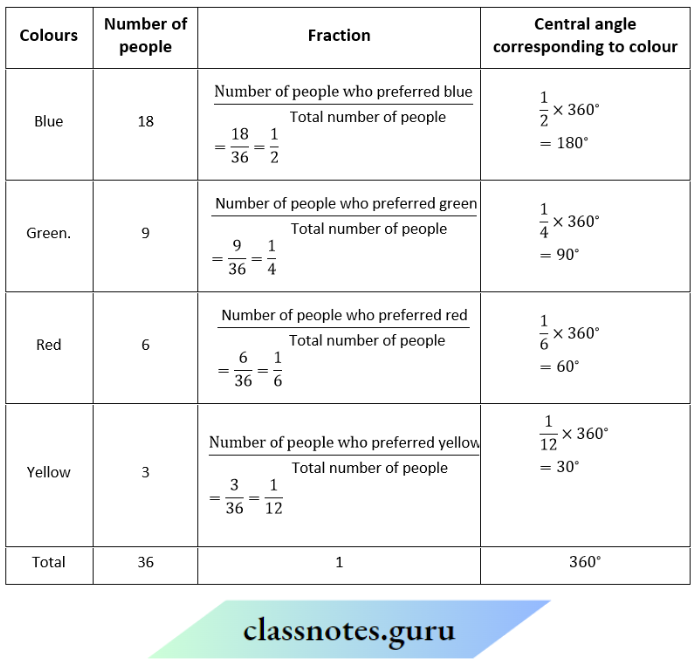
Pie chart:
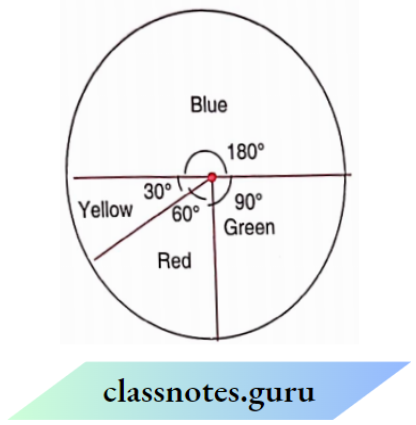
Question 4. The adjoining pie chart gives the marks scored in an examination by students in Hindi, English, Mathematics, SocialScienceand Science. If the total marks obtained by the students were 540, answer the following questions:

1. In which subject did the student score 105 marks?
Hint: For 540 marks, the central angle
= 360°. So, for 105 marks, what is the central angle?
2. How many more malts were obtained by the student in Mathematics than in Hindi?
3. Examine whether the sum of the marks obtained in Social Science and Mathematics is more than that in Science and Hindi
Solution:
1. Total marks = 540
∴ Central angle corresponding to 540 marks
= 360°
∴ Central angle corresponding to 105 marks
= \(\frac{360^{\circ}}{540} \times 105=70^{\circ}\)
Since the sector having a central angle of 70° corresponds to Hindi, therefore, the student scored 105 marks in Hindi.
2. Central angle corresponding to the sector of mathematics = 90°
∴ Marks obtained by the student in Mathematics
= \(\frac{90^{\circ}}{360^{\circ}} \times 540\)
= 135
Marks obtained by the student in Hind =105
Hence, the student obtained 135 – 105 = 30 marks more in Mathematics than in Hindi.
3. Sum ofthe Central Angles for Social
Science and Mathematics
= 65° + 90° = 155°
Some of the central angles for Science and Hindi
= 80° + 70° = 150°
Since the sum of the central angles for Social Science and Mathematics is greater than the sum of the central angles for Science and Hindi, therefore the sum of the marks obtained in social science and mathematics is more than that in Science and Hindi.
Question 5.The number of students in a hostel, speaking different languages is given below. Display the data in a pie chart

Solution:
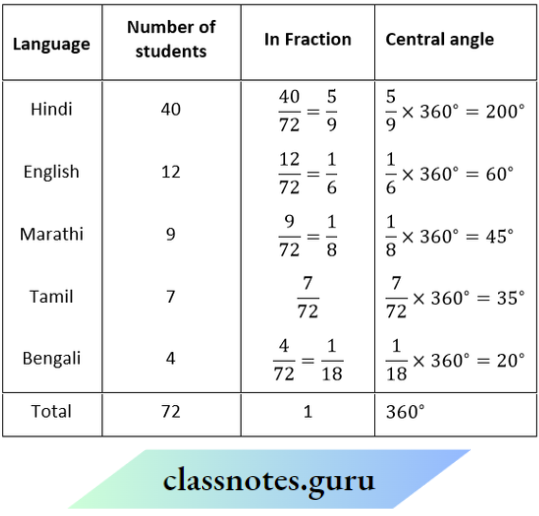
Now, we make the pie chart.
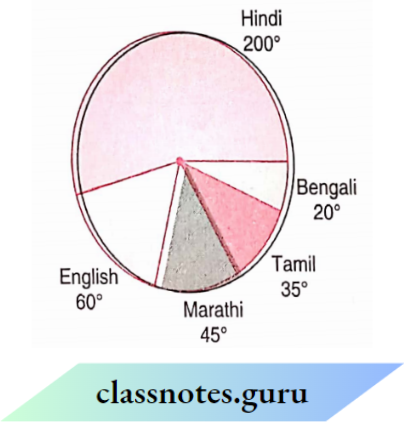
We face many situations where we take a chance and it does not go as per our wish. For example, on tossing a coin, we may get a head or we may get a tail; but simply by chance. There exist many situations when the chances of a certain thing happening or not happening are not equal.
Getting A Result
A random experiment is one whose outcome cannot be predicted exactly in advance.
Question 1. If you try to start a scooter, what arc the possible outcomes?
Solution:
If we try to start, a scooter, then the possible outcomes are
Question 2. When a die is thrown, what are the six possible outcomes?
Solution:
When a die is thrown, the six possible outcomes are 1, 2, 3, 4, 5 and 6.
Question 3. When you spin the wheel shown, what are the possible outcomes? List them. (Outcome here means the sector at which the pointer stops).
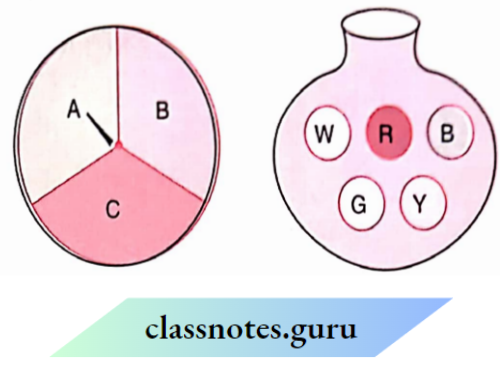
Solution:
Since in the given wheel, there are three sectors A, B, and C, so, when we spin the wheel, the possible outcomes are A, B and C.
Question 4. You have a bag with five identical balls of different colours and you are to pull out (draw) a ball without looking at it; list the outcomes you would
Solution:
Since the given bag contains five identical balls of different colours, W, R, B, G and Y, therefore, when we pull out (draw) a ball without looking at it, the possible outcomes are W, R, B, G and Y.
Question 5. In throwing a die
1. Does the first player have a greater chance of getting a six?
Solution: No
2. Would the player who played after him have a lesser chance of getting a six?
Solution: No
3. Suppose the second player got a six. Does it mean that the third player would not have a chance of getting a six?
Solution: No
Equally Likely Outcomes
Outcomes of an experiment are equally likely if each has the same chance of occurring.
Linking Chances To Probability
Chances of the happening of an event lead us to find the probability of that event. Of course, we have to take into account the total number of chances related to a particular event under consideration
Question 1. What is the probability of getting a tail?
Solution: The probability of getting a tail is \(\frac{1}{2}\)
Question 2. What is the probability of getting Ike number 5?
Solution: The probability of getting the number 5 is \(\frac{1}{6}\)
Question 3. What is the probability of getting the number 7?
Solution: The probability of getting the number 7 is 0.
Question 4. What is the probability of getting a number 1 through 6?
Solution: The probability of getting a number 1 through 6 is \(\frac{1}{6}\)
Probability of an event =\(\frac{\text { Number of outcomes that make an event }}{\text { Total number of outcomes of the experiment }} \text {, }\) when the outcomes are equally likely.
One or more outcomes of an experiment make an event
Question 1. List the number of outcomes of getting a green sector and not getting a green sector on this wheel
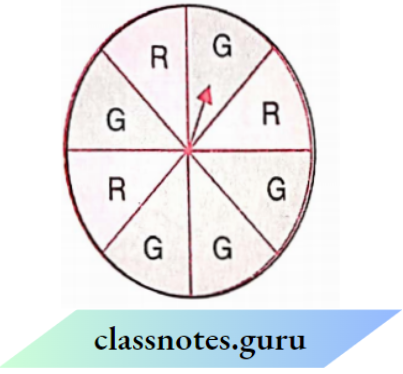
Solution:
1. Number of outcomes getting a green sector on this wheel = 5
The number of outcomes of not getting a green sector on this wheel = 3
2. Total number of equally likely outcomes = 8
Number of outcomes getting a green sector = 5
∴ Probability of getting a green sector
= \(=\frac{\begin{array}{l}
\text { Number of outcomes of getting a green sector } \\
\end{array}}{\text { Total number of outcomes }}\)
= \(\frac{5}{8}\)
Total number of equally likely outcomes = 8
Number of outcomes of not getting a green sector = 3
The probability of not getting a green sector
= \(\frac{\begin{array}{l}\text { Number of outcomes of getting a green sector }\end{array}}{\text { Total number of outcomes }}\)
= \(\frac{3}{8}\)
Chance And Probability Related To Real Life
Chances and probability are related to real life. The UHO of probability i.s ma(te in various cases in real life. For example, during elections ‘an exit poll’ is taken which gives a rough idea of the chance of winning of each candidate and predictions regarding the poll are made based on it. Here, we have used a small part of the group to find the characteristics of a large group.
Question 1. List the outcomes you can see in these experiments.
1. Spinning wheel
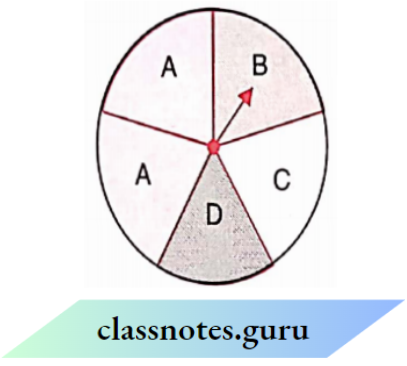
2. Tossing two coins together
Solution:
Question 2. When a die is thrown, list the outcomes of an event of getting
1.
2.
Solution:
Possible outcomes are :
1, 2, 3, 4, 5, and 6.
Out of these, prime numbers are 2, 3 and 5.
The outcomes of an event of getting a prime number are :
2, 3 and 5
The outcomes of an event of not getting a prime number are 1, 4 and 6.
The outcome of an event of getting a number greater than 5 is 6.
Outcomes of an event of getting a number not greater than 5 are1, 2, 3, 4 and 5
Question 3. Find the
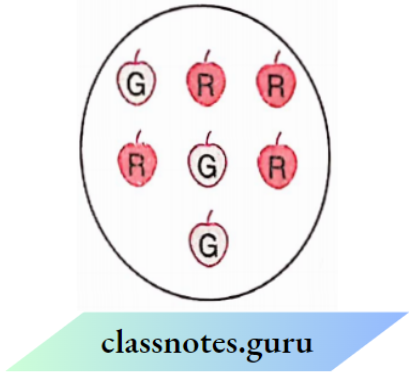
Solution:
1. There are 5 sectors on the spinning wheel represented by A, A, B, C and D. The pointer stopping on D has m only 1 outcome, i.e., D
∴ Probability of the pointer
Stopping on D =\(\frac{1}{5}\)
2. Total number of playing cards = 52
Number of possible outcomes = 52
Number of aces in a deck of playing cards = 4
∴Probability y of getting an ace from a well-shuffled deck of 52 playing cards =\(\frac{4}{52}\)
= \(\frac{1}{3}\)
3. Total number of apples = 7
Number of red apples = 4
The probability of getting a red apple
= \(\frac{4}{7}\)
Question 4. Numbers 1 to 10 are written on ten separate slips (one number on one slip), kept in a box and mixed well One slip is chosen from the box without looking into it. What is the probability of this?
Solution:
Total number of outcomes of the event (1, 2. 3, 4, 5, 6, 7, 8, 9 and 10) = 10
1. Number of outcomes of getting a number 6 = 1
∴ The probability of getting the number 6
= \(\frac{1}{10}\)
2. There are 5 numbers (1, 2, 3, 4 and 5) less than 6.
∴ Number of outcomes getting a number less than 6 = 5
∴ Probability of getting a number Less than
6 = \(\frac{5}{10}\)
= \(\frac{1}{2}\)
3. There are ‘I number (7, 8, 9nnd 10) greater than
Number of outcomes of ting a number greater than G = 4
The probability of getting a number greater than 6 = 4 is greater than
6 = \(\frac{4}{10}\)
= \(\frac{2}{5}\)
There are 9 1-digit numbers(1, 2, 3, 4, 5, 6, 7, 8 and 9)
∴ Number of outcomes of getting a1-digit number = 9
∴ Probability of getting a 1-digit number = \(\frac{9}{10}\)
Question 5. If you have a spinning wheel with 3 green sectors, 1 blue sector and 1 red sector, what is the probability of getting a green sector? What is the probability of getting a non-blue sector?
Solution:
Number of green sectors = 3
Number of blue sectors = 1
Number of red sectors = 1
∴ Total number of sectors
= 3+1+1 = 5
∴ Total number of outcomes of the event = 5
Number of outcomes of getting green sector = 3
Probability of getting a green sector
= \(\frac{3}{5}\)
Number of outcomes of getting non-blue sector
= Number of green sectors + Number of red sectors
= 3+1 = 4
∴ The probability of getting a non-blue
= \(\frac{4}{5}\)
Question 6 Find the probabilities ofthe (rents I have given in
Solution:
Total number of outcomes of the event (1. 2. 3, 4, 5 and 6) = 6
1.
1. Number of prime numbers
(2. 3 and 5) = 3
Number of outcomes of getting a prime number = 3
∴ Probability of getting a prime number
= \(\frac{3}{6}\)
= \(\frac{1}{2}\)
2. Number of non-prime numbers (1, 4 and 6) = 3
Number of outcomes of getting a prime number = 3
∴ Probability of gelling a non-prime
= \(\frac{3}{6}\)
= \(\frac{1}{2}\)
2.
1. Number greater than 5 = 6, i.e., only one.
∴ The probability of getting a number greater than 5 =\(\frac{1}{6}\)
2. Number of numbers not greater than 5 (1, 2, 3, 4 and 5) = 5
The number of outcomes of getting a number not greater than 5 = 5
Probability of getting a number not greater than 5 = \(\frac{5}{6}\)
Observe the following bar graph and answer the following questions :
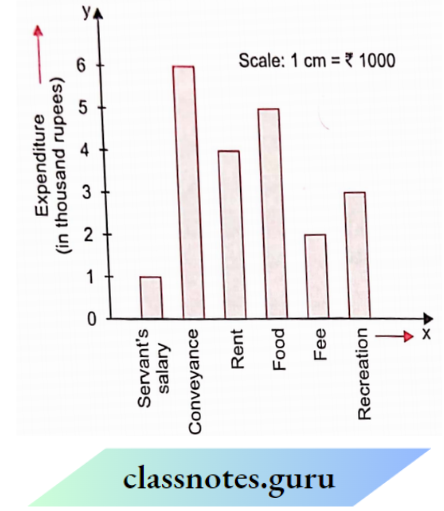
Question 1. On which item has the maximum expenditure been done?
Solution: 1. Conveyance
The height of the bar corresponding to conveyance is the maximum.
Question 2. On which item has the minimum expenditure been done?
Solution: 1. Servant’s salary
The height of the bar corresponding to the servant’s salary is the minimum.
Question 3. What is the expenditure on food?
Solution: 4. ₹5000
Expenditure done on food = 5 × 1000 = 5000.
Question 4. What is the difference between expenditures done on conveyance and rent?
Solution: 2. ₹ 2000
Expenditure done on conveyance
= 6 × 1000 = ₹ 6000
Expenditure done on rent = 4 × 1000
= ₹ 4000
.-. Difference = ₹ 6000 – ₹ 4000
= ₹ 2000
Question 5. ₹ 5000 is the expenditure done on
Solution: 2. Food
⇒ \(\frac{5000}{1000}\) = 5 cm is the height of the bar corresponding to food
Question 6. ₹60000 is the expenditure done on
Solution: 3. Conveyance
⇒ \(\frac{6000}{1000}\) = 6 cm is the height of the bar corresponding to conveyance
Question 7. How much expenditure h;m been done in all?
Solution: 1. 21000
Total expenditure
= (1 + 6 + 4+ 5 + 2 + 3) × 1000
= ₹ 21000
Observe the following paragraph and answer the following questions:
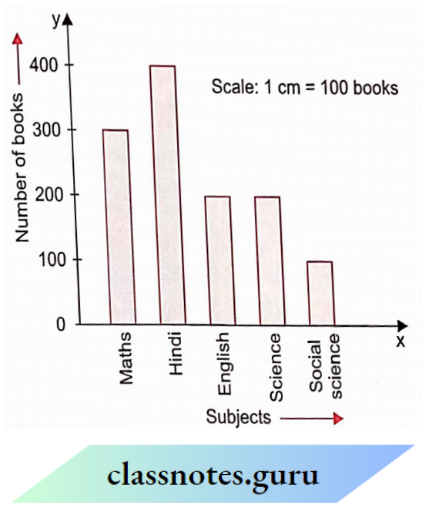
Question 8. Of which subject are there the maximum books?
Solution: 1. Hindi
The height of the bar corresponding to Hindi is maximum.
Question 9. How many books are there on ofthe subject whose books are maximum?
Solution: 4. 400
Hindi → 400
Question 10. Of which subject are there the minimum books?
Solution: 1. Social
The height of the bar corresponding to Social Science is the minimum
Question 11. How many books are there on the subject whose books are minimum?
Solution: 1. 100
Social Science → 100
Question 12. Which two subjects have the same number of books?
Solution: 3. English and Science
English → 200
Science → 200
Question 13. 300 books on the subject
Solution: 1. Maths
300 → Maths
Question 14. The difference of the number of books in English and Science is
Solution: 4. 0
200-200 = 0
Question 15. The difference of the number of books of Hindi and Social Science is
Solution: 2. 300
400-100 = 300
Question 16. The total number of books is
Solution: 1. 1200
300+400 + 200 + 200+ 100 = 1200
Question 17. The total number of books of English and Science is
Solution: 3. 400
200 + 200 = 400
Observe the pie chart given below and answer the following questions:

Question 18. The central angle for sector A is
Solution: 1. 108°
Central angle for sector A
= \(\frac{30}{100} \times 360^{\circ}\)
= 108°
Question 19. The central angle for sector B is
Solution: 2. 144°
Central angle for sector A
= \(\frac{40}{100} \times 360^{\circ}\)
= 144°
Question 20. Which sector has the greatest angle?
Solution: 2. B
Greatest percentage = 40% → B
Question 21. What is the difference between the central angles for Sector B and Sector C?
Solution: 1. 36°
144° – 108° = 36°
Observe the pie chart and answer the English following questions
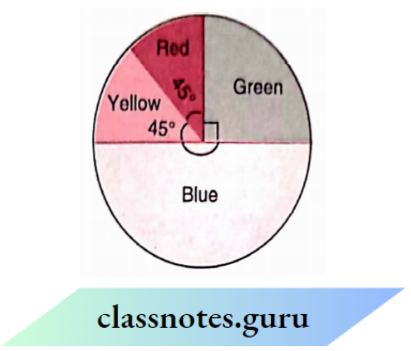
Question 22. Which two colours have the same central angles?
Solution: 1. Red, yellow
Red → 45% ; Yellow → 45%.
Question 23. Which colour has the greatest central angle?
Solution: 4. Blue
Blue → 180°
Question 24. The proportion of the sector in red is
Solution: 3. \(\frac{1}{8}\)
⇒ \(\frac{45^{\circ}}{360^{\circ}}=\frac{1}{8}\)
Question 25. The difference between the central angles for green and blue is
Solution: 2. 90°
Central angle for blue = 180°
Central angle for green = 90°
Difference = 180° – 90° = 90°.
Question 26. A child has a block in the shape of a cube with one letter written on each face as shown below

The cube is thrown once. What is the probability of getting A
Solution: 1. \(\frac{1}{3}\)
Probability =\(\frac{2}{6}\)
= \(\frac{1}{3}\)
Question 27. A die is thrown. What is the probability of getting an even prime number
Solution: 1. \(\frac{1}{6}\)
Even prime number = 2
Probability =\(\frac{1}{6}\)
1. In the n chart, a whole circle is divided into various sectors – True
2. The number of times a particular observation that occurs in a given data is called its frequency – True
3. The probability of a sure event is 0– False
4. The probability of an impossible event is 1 – False
5. In a throw of a die, the outcomes are equally likely – True
1. The difference between the highest and the lowest values ofthe observations in a data is called the Range of the data.
2. A geometric representation showing the relationship between a whole and its parts is called a → Pie chart
3. The probability that it will rain tomorrow is 0. 75. What is the probability that it will not rain tomorrow → 0.25
4. Find the range ofthe marks obtained by 10 students in class as follows → 11, 9, 13, 18, 20, 18, 42, 41, 13,
5. In the throw of die, what is the probability of getting a number greater than 6 → 0
6. What is the total number of outcomes, when a coin is tossed → 2